
AUGUST 2020 HEALTH • MONEY • TRAVEL • RECIPES • FASHION • TECHNOLOGY READER’S DIGEST | SMALL AND PERFECTLY INFORMED | AUGUST 2020 Gordon Ramsey “I MISS THE KITCHEN LIKE HELL” Finding My Family LIVES TRANSFORMED BY DNA TRACING AUGUST 2020 £3.79 readersdigest.co.uk 3 GIANTS In The Footsteps Of DISCOVERING THE NORTH ANTRIM COAST
Everyone has a book in them It’s called an autobiography
It’s the one no one else can write
How you saw The Beatles in ’62
Or the Pistols in ’76
And rolled And lived
How you rocked And loved
Things the grandchildren won’t believe
It’s time to tell your story
The gift of a lifetime
LifeBook is the world’s leading autobiography service. Around the world more than 8000 people already enjoy owning the life story of someone they love. Each book is a unique piece of family treasure, custom-made and handcrafted, to be shared by generations to come. It’s time to tell your story. Find out how by contacting us on 0800 999 2280 or visit lifebookuk.com
Features
16 IT’S A MANN’S WORLD
Olly Mann on his love for the theatre and how he’s been coping without it in lockdown
ENTERTAINMENT
20 INTERVIEW: GORDON RAMSEY
The foul-mouthed chef shares the secret to his self-confidence and winning over US audiences
28 “I REMEMBER”: JUDY COLLINS
One of America’s brightest folk stars reminisces about her fiery love affairs and meeting John F Kennedy
HEALTH
38 MALE BALDNESS
Twenty-one per cent of men link baldness to depression— what options do they have in the battle with hair loss?
INSPIRE
56 DYING LANGUAGES
We speak to the people fighting to save some of the world’s oldest languages
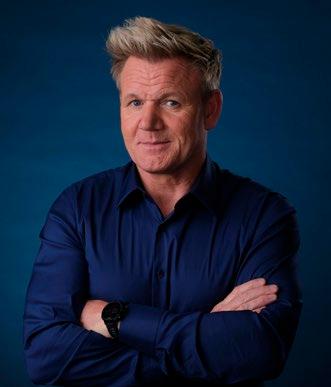

64 MY UNITED KINGDOM: BELFAST
Discover the natural beauty and fascinating history behind the capital of Northern Ireland
74 FINDING MY FAMILY
Three people share how they rediscovered their roots through the wonder of DNA tracing
90 NORTH ANTRIM COAST
Exploring the rugged, mystical coast of Northern Ireland
AUGUST 2020 • 1
Contents AUGUST 2020
p90 p20 cover illustration by Daniel Mitchell
RECLINING HARDWOOD SUN LOUNGER
WITH LUXURY CUSHION
£165 for Reader’s Digest readers (RRP £295.99)


THIS SOLID, BEAUTIFULLY MADE, QUALITY PIECE MAKES IT EASY TO RELAX!
• Fully reclining hardwood sun lounger with side pull out table (slides to left or right) and luxury cushion with head pillow included
• Stained, oiled and gently rubbed down by hand, the finish is a delight and matches Plant Theatres outdoor garden furniture ranges
• Plant Theatre’s sun lounger comes with extended wooden handles and wheels for easy manoeuvrability
• Delivered flat-packed and part assembled, easy home assembly with full instructions included.
• Dimensions: Sun lounger L 198cm x W65 x depth from ground 34cm (excluding cushion

Fully reclining sun lounger made from Acacia hardwood from sustainable sources has been stained, oiled and gently rubbed down by hand, the finish is a delight.
It has a pull-out side table which slides from left or right or can be completely hidden, plus extended wooden handles and wheels for easy manoeuvrability.
A specifically made luxury cushion with double piping, fabric ties and removable head pillow is included, all covers have zips and can be removed for washing.
The sun lounger arrives flat-packed and part assembled for easy home completion with full instructions included.
delivery normally within 3-5 working days.
plant-theatre.co.uk/reclining-hardwood-sun-lounger-with-luxury-cushion.html
ENTER CODE RD1
TO RECEIVE OFFER PRICE


AUGUST 2020 • 3 8 Over to You 12 See the World Differently HEALTH 46 Advice: Susannah Hickling 50 Column: Dr Max Pemberton INSPIRE 70 If I Ruled the World: Katie Piper TRAVEL & ADVENTURE 98 My Great Escape 100 Hidden Gems: London MONEY 102 Column: Andy Webb FOOD & DRINK 106 A Taste Of Home: Ella Mills 108 World Kitchen: Turkey ENVIRONMENT 112 Column: Jessica Lone Summers FASHION & BEAUTY 114 Column: Lisa Lennkh on how to look your best 116 Beauty ENTERTAINMENT 118 August’s cultural highlights BOOKS 122 August Fiction: James Walton’s recommended reads 127 Books That Changed My Life: Candice Brathwaite TECHNOLOGY 128 Column: James O’Malley FUN & GAMES 130 You Couldn’t Make It Up 133 Word Power 136 Brain Teasers 140 Laugh! 143 60-Second Stand-Up 144 Beat the Cartoonist
issue p106 Contents AUGUST 2020 p113
In every
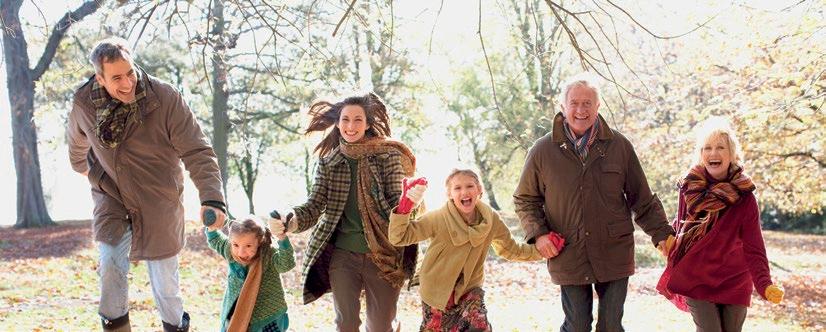











SENIOR EDITORS Anna Walker, Eva Mackevic
EDITORIAL ASSISTANT Jessica Lone Summers
ART DIRECTOR Richard Cooke
ADVERTISING Jigs Pankhania
MARKETING Sarah Hughes
HEAD OF FINANCE Santwana Singh
FINANCE MANAGER Irving Efren
MANAGING DIRECTOR Julie Leach
CHAIRMAN Gary Hopkins
subscriber enquiries, please
WE PAY...
£50 for the star letter and £30 for regular letters.
Email readersletters@readers digest.co.uk or go to readers digest.co.uk/contact-us
WE ALSO PAY...
£30 for the true stories, anecdotes, jokes in Laugh! and You Couldn’t Make It Up…, and contributions to end-ofarticle fillers and My Great Escape.
Email excerpts@readersdigest.co.uk or go to readersdigest.co.uk/contact-us
SORRY!
We cannot acknowledge or return unpublished items or unsolicited article-length manuscripts. Do not send SAEs. Article-length stories, poetry and cartoons are not requested.

TRUSTED MEDIA BRANDS INC (USA)
President and Chief Executive Officer
Bonnie Kintzer
Editor-in-Chief, International Magazines
Raimo Moysa
number below
CUSTOMER SERVICES
Contact Customer Services for renewals, gifts, address changes, payments, account information and all other enquiries. Call 0330 333 2220* or email customer_service@readersdigest.co.uk
TALKING MAGAZINES
Reader’s Digest is also available in audio and accessible etext editions from RNIB Newsagent, for blind and partially sighted readers. Call the RNIB Helpline on 0303 123 9999 or visit rnib.org.uk/newsagent
SUBSCRIPTIONS
Annual subscriptions are available to be delivered monthly direct to your door. For our latest offers please visit readersdigest.co.uk/subscribe Or telephone us today on 01778 392461
Gift subscriptions also available. UK rates may vary. Overseas rates: Republic of Ireland €50, Rest of the World €60.
*Calls to 03 numbers cost no more than a national rate call to an 01 or 02 number and will be free if you have inclusive minutes from any type of line including mobile, BT or other fixed line PAPER FROM SUSTAINABLE FORESTS. PLEASE RECYCLE © 2017 Vivat Direct Ltd (t/a Reader’s Digest). British Reader’s Digest is published by Vivat Direct Ltd, 57 Margaret Street, London W1W 8SJ. All rights reserved throughout the world. Reproduction in any manner, in whole or part, in English or other languages, is prohibited. Reader’s Digest is a trademark owned and under license from Trusted Media Brands, Inc, and is registered with the United States Patent and Trademark Office. All rights reserved. Printed by Pindar Scarborough Limited. Newstrade distribution by Seymour Distribution Limited. SMALL PRINT: Ensure submissions are not previously published. Include your name, email, address and daytime phone number with all correspondence. We may edit letters and use them in all print and electronic media. Contributions used become world copyright of Vivat Direct Ltd (t/a Reader’s Digest). Reader’s Digest is a member of the Independent Press Standards Organisation (which regulates the UK’s magazine and newspaper industry). We abide by the Editors’ Code
Practice
committed
upholding the highest standards
journalism.
met those standards,
contact 0203
IPSO
Editors’ Code, contact IPSO
0300 123 2220 or visit
of
and are
to
of
If you think that we have not
please
795 8886. If we are unable to resolve your complaint, or if you would like more information about
or the
on
ipso.co.uk For all
use the customer services
WRITE TO US! SEND US YOUR STORIES, JOKES AND LETTERS OR VISIT OUR WEBSITE
5
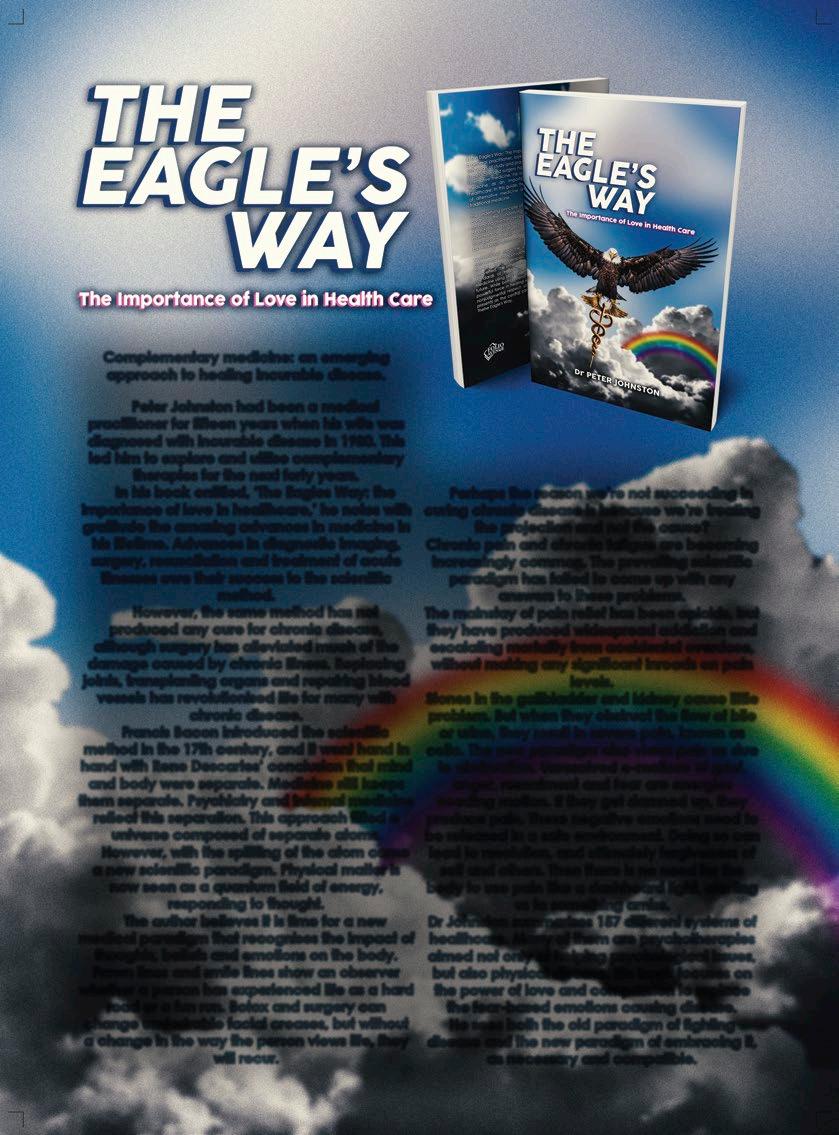

In This Issue…

What does home mean to you? The bricks and mortar of your house? The town you grew up in? Or that fuzzy feeling of time spent with loved ones? Our August issue tackles home in many different senses. On p56, we meet people fighting to keep their mother tongue alive, as native langauges increasingly fall silent. On p106, home is the taste of Ella Mills (aka Deliciously Ella)’s mum’s tomato risotto. Meanwhile on p74, home comes in unexpected places, when two friends who grew up just a few miles apart are astonished to discover that they’re brothers.
Think your home town is particularly special? We’d love to cover it for our My Britain series, which pays a visit to Belfast on p64. Email us at readersletters@ readersdigest.co.uk and let us know.
And when we’re not basking in wholesome domesticity, we’re braving some of the world’s most remote and mystical corners. On p90, Sarah Kante takes in the steely beauty of Northern Ireland’s North Antrim Coast whose landscapes are so rugged and dramatic, they’ve captivated the audiences of the hit TV series, Game of Thrones. On p118, we take a look at Make Up—a film defined by its uncompromisingly aloof and untamed Cornish landscape, while on p12, we visit a 1,200m-high hillside in the Swiss Alps, adorned by a graffiti painting symbolising a hopeful outlook for the future. At a time when travel is still very much limited, we hope that experiencing the world through this issue’s pages will bring you at least a modicum of satisfaction.
Anna Eva
FOLLOW US

facebook.com/readersdigestuk


You can also sign up to our newsletter at readersdigest.co.uk
Reader’sDigestis published in 27 editions in 11 languages
AUGUST 2020 • 7
EDITORS’ LETTERS
twitter.com/readersdigestuk @readersdigest_uk
Over To You
LETTERS ON THE June ISSUE
We pay £50 for Letter of the Month and £30 for all others
LETTER OF THE MONTH

I enjoyed “If I Ruled The World” by Mick Harvey. Especially his ideas on repairing the planet. Although the richest, most developed countries in the world are overwhelmingly to blame for the catastrophe of global climate change, they are not the ones who will suffer the most from it. It’s the poorest countries that suffer. Sadly, climate change is exacerbating global income inequality between wealthy nations in cooler regions, and poor nations in hotter parts of the world. Even as they change their own energy policies, the world’s wealthier nations must also help poorer countries create sustainable energy grids. We must confront China’s counterproductive practice of building coal-fired power plants in developing nations to curry political influence. We must offer aid and policies to reverse deforestation in the Amazon, Indonesia and other vital forests that remove carbon from the atmosphere.
SUZANNE ROSWELL, Stevenage
LITERATURE LOVE
Lottie Fyfe’s “The Art Of The Bookshelf” really made me think. Having never previously analysed my own bookshelves’ layout, I now recognise the pleasing jumble of hardbacks and paperbacks as a chronicle of my evolving tastes and interests.
Recently, politicians in lockdown have used their own collections to help enhance their credibility with voters. Rarely a minister has appeared on television without some seminal political text waving at viewers from the background. The ploy may appear cynical, but we all have self-images we wish to project and bookshelves are an excellent tool for doing so.
On a lighter note, one Twitter user in 2018 posted a wonderful image of her colour-coded arrangement with the caption, “I have created a reading rainbow in our new place and anyone who does not like it is an enemy of joy.” What better way to showcase your love of literature and sense of fun.
ROB BUXTON, London
8 • AUGUST 2020
BOOKWORM

I loved reading “The Art Of The Bookshelf.” How true that we all like a sneaky peak at someone else’s collection! My books are all stood along a thin wooden shelf that runs the length of my sitting room. We put the shelf up for practicality but I also like the way the books make our living room feel more homely. And intensely personal. Scanning along the shelf, each spine reminds me of a particular time and place in my life—it’s as much about storing memories as it is about the books themselves. It’s also about sharing those memories. I don’t order my books but I do have a couple of sections where I put the books I think others may like to read. And as we swap books, we start to understand each other. This is the true artistry of books—the conversations they start and the way they connect lives together. Books are so much more than a stack or a collection and lose their meaning when they are reduced to mere objets d’art, rather books are vessels of remembrance, co-ordinates of the places we have visited, the people we have been —through them we tell the stories of our lives— no wonder our bookcases are weighted with so much meaning!
JENNIE GARDNER, Bath
THE HOME COMMUTE
I wholeheartedly agree with Olly Mann’s tips for working from home. I’ve been doing it for a couple of years now and it’s taken a bit of getting used to. I think a lot of people are learning that it demands a level of self-discipline, both to stay focused on work and to stay away from the fridge!
It can also feel quite isolating, although the “zoom boom” and the way it accommodates face-to-face chats has certainly changed the dynamic a bit.
Having pets around can be really good company.
Although, while I find the regular appearance of my cat sitting in front of my laptop, with its “feed me” face, quite cute, it’s not especially helpful when I’m trying to meet a tight deadline!
Whatever the pros and cons, working from home is clearly now a part of the new normal and lots more of us are going to continue to do it (with or without demanding cats).
LISA BEST, Cheshire
Send letters to readersletters@readersdigest.co.uk Include your full name, address, email and daytime phone number. We may edit letters and use them in all print and electronic media WE WANT TO HEAR FROM YOU!
AUGUST 2020 • 9

is MINI is electric
LET’S START BY STATING THE OBVIOUS
THIS IS A 3-DOOR MINI HATCHBACK IT’S ALSO ELECTRICALLY POWERED
IN OTHER WORDS YOU’VE GOT A CAR WHICH IS ALREADY GREAT TO DRIVE AND NOW THERE’S 100 PER CENT ELECTRIC POWER


THIS IS A WINNING FORMULA





PARTNERSHIP PROMOTION



Let’s start with some number crunching
The MINI Electric starts at £24,400 (including government grant). This is around £400 cheaper than the petrol engine MINI Cooper S. Why compare it with the Cooper S? Simple, they have an almost identical 0-60 performance time of 7.3 seconds. Don’t forget, whereas a conventionally powered car has to build the revs to reach peak power and you need to work the gearbox, electric cars have 100 per cent power instantly and, in e ect, only one gear. The MINI Electric does 0-30mph in around 3 seconds. It’s seriously quick, terrific fun, but incredibly simple to drive.
Hop in, turn it on, select drive, press the throttle and away you go. There are four driving modes; Sport, Mid, Green and Green+. All vary the steering response and the rate in which power is delivered. Green+ mode turns o kit which drains power, like air con for example.
Another switch allows you to alter what is known as regenerative braking. The car charges the battery when you lift your foot o the throttle. It provides a braking force which, once you get used to it, allows you to drive along without using the foot brake.
Back to number crunching
The MINI Electric has a predicted range of 145 miles. This will lower in cold weather. At a fast-charging station an 80% charge is reached from zero in 36 minutes. The sort of charger you will find at work or can be installed at home, will give you an 80 per cent charge in around 3 hours.
There are three levels of trim, but every MINI Electric is well equipped with sat nav, cruise control, air con and a host of customising options.


A daily round journey work commute of, say, twenty miles should be fine for a single charge on a Sunday night to last until the weekend. If you can adapt to the number of miles per charge, the MINI Electric is one of the best electric cars around.
IT’S 100% ELECTRIC, AND IT’S A MINI.
WHAT’S NOT TO LOVE?

12
Photos: © P icture alliance/K e Y stone /V alentin SEE THE WORLD... turn the page


…DIFFERENTLY
Those wishing to admire this creation will have needed to fly high! “Beyond Crisis” is what Saype, a French expatriate artist in Switzerland, named this image he sprayed onto a hillside 1,200m-high in the Swiss Alps. The work was done in April of this year to convey a sense of calm and hope during the coronavirus pandemic. The graffiti artist has the young girl looking confidently into the distance, symbolising mankind’s collective anticipation of a future where this crisis has passed. Sadly, his 3,000 square metre artwork will be gone before that future arrives, as his biodegradable chalk and charcoalbased pigments disappear into the grass after only two to four weeks.
Photo: © Gett Y i ma G es/Donal D m iralle

15
The Curtain Call
Olly Mann recounts the joys of a well-packed theatre and wonders when the show will go on
You’re reading this five weeks after I’m writing it, so forgive me if the news cycle has swung back to existential tragedy, but right now one of the stories doing the rounds is Sir Cameron Mackintosh’s decision to suspend performances of his blockbuster musicals until 2021—because they can’t turn a profit whilst maintaining social distancing.
This means that the final performance of Les Misérables in 2020—after an uninterrupted run of approximately 795 years—was on March 15. Which means, as it happens, that I caught it just before

Olly Mann presents Four Thought for BBC Radio 4, and the award-winning podcasts The Modern Mann and Answer Me This!
it closed. I went on March 13, with my mate Josh, after it had emerged, over dinner one night in a Korean restaurant, that he had never seen it.
"WHAT?!" I said, spitting kimchi everywhere (we weren’t wearing masks, it was March). "It’s a classic!"
Josh—who works for the civil service, watches Newsnight and thinks musicals are actively bad for you—replied sternly, "The Victor Hugo novel is a classic. I’ve read it. Isn’t the musical just a bit… naff?"
Now, I’ve never read the book, and have no intention to, but I’ve seen the musical loads, and I was not going to let this go.
"Naff?", I retorted. "Only if you think joy is naff! Only if you think emotion is naff! Only if you think The French Revolution is naff!"
(It turns out the background to the story is actually the failed Paris Uprising of 1832, not the French Revolution 50 years earlier, but hey, you go to Les Mis for the wigs and
illustration by Eva Bee
16 • AUGUST 2020 IT’S A MANN’S WORLD
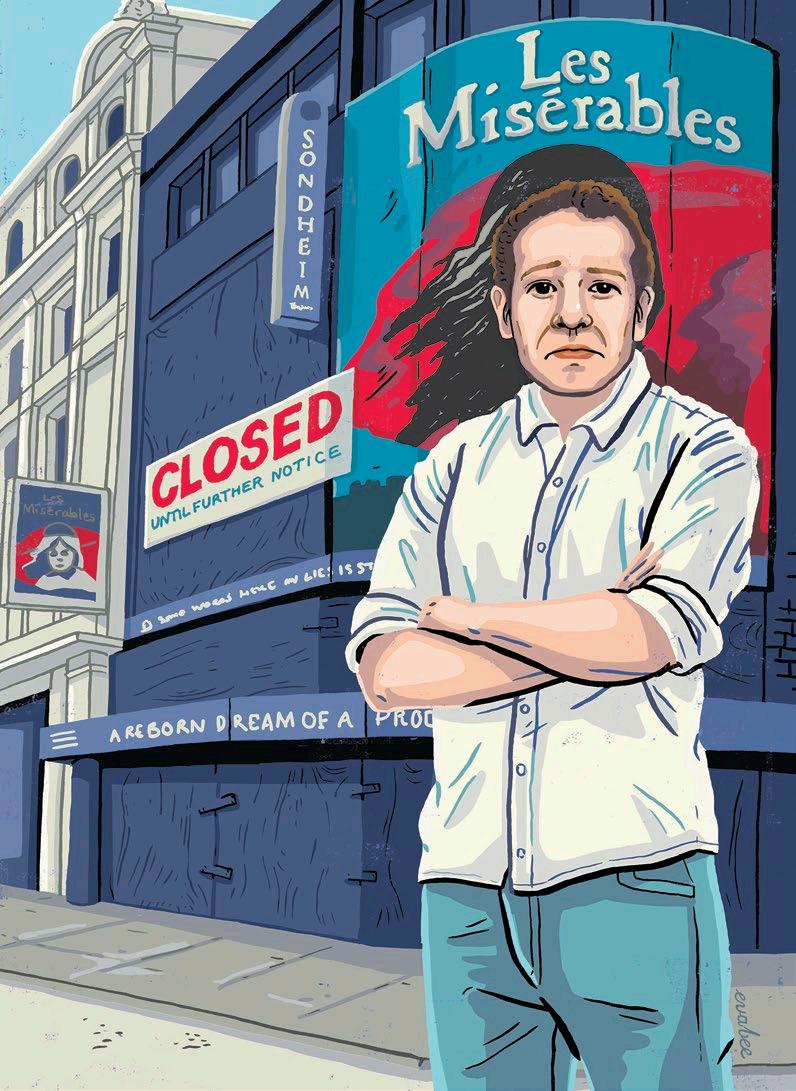
the harpsichords, not for a history lesson, right?).
Anyway, Josh and I went to see the show, just as London was beginning to lock down. It felt risky, if I’m honest, taking our seats among 1,074 coughing tourists from every nation on Earth. But it certainly added a frisson to the melodrama on stage. As Valjean spluttered his final lines to Cosette’s ghost (spoiler!), I must admit, I empathised somewhat more intensely than in pre-Covid times. I glanced to see if a tear had, perhaps, moistened Josh’s face. It had not. But, still, during the obligatory standing ovation, he rose with the crowd. He’d thought the sung-through libretto was a bit silly, he told me in the bar afterwards. But the barricades had stirred him.
I have not, of course, been to the theatre since. Which is significant, because theatre is my thing. Ever since my wife and I first negotiated a childcare rota, Thursday evenings have been theatre night (I go to the West End, my wife stays at home. She hates all theatre and finds it boring, so this works well. She gets to ride a horse on Mondays and Wednesdays). Sometimes I meet a friend (Sam for the contemporary drama, Ben for the jukebox musicals), sometimes I go with my mum (if I can get a box, so she can stretch her legs). Often, if I’m seeing something I know
no-one else will come to (weird Russian circus; an off-West End revival of Aspects of Love), I just go by myself.
And I never regret it. Even if the production is a bit below par. Even if I’m a bit tired. Even if I haven’t had time to eat before and all I can find in the interval is a dodgy egg sandwich from the corner shop. Even then. Because theatre is my thing. For two-three hours, I switch off my phone, get involved in someone else’s story, and share an intimate experience with a roomful of strangers. It never fails to make me feel better. It’s like therapy.
So it’s a strange sensation to realise that, almost certainly, I will not be visiting a theatre again this year. Back in the spring, the productions I had tickets for offered me the opportunity to reschedule, so I rebooked them all for October, on the basis that surely by then this whole "virus thing" will

18 • AUGUST 2020 IT’S A MANN’S WORLD
be over. Now that doesn’t seem at all certain, and, even if those shows do re-open, I’m not convinced I would actually want to go. For the first time in my life, I might choose not to go to the theatre.
There are filmed productions, of course, available to stream on telly at home, but not only is this not really the same experience as watching the event live; for me it subverts the thing I love most about theatre, which is—however glitzy or epic the production—its temporality. Its smallness.
I’m a broadcaster, and if a radio show or podcast I was working on reached just 1,000 listeners, I’d be furious. It wouldn’t be worth making it. Yet, when I go to the theatre, an entire cast and crew of talented professional creatives work their
"IT FELT RISKY TAKING OUR SEATS AMONG 1074 COUGHING TOURISTS FROM EVERY NATION ON EARTH"
socks off to entertain me and 1,000 or so others (often far fewer, in fringe venues). Then, after all their exertions, the communal experience evaporates—except in the memories of those who were there. That is what makes it special. That is what makes it feel like a treat.
Roll on 2021. Do you hear the people sing? n
Bugging out
Caterpillars have 12 eyes!
One dung beetle can drag 1,141 times its weight—that’s like a human pulling six double-decker buses.
A single honeybee colony can produce around 100kg of honey each year— that’s 220 jars.
An ant-eating assassin bug piles its victims onto its body to scare predators.
Fruit flies were the first living creatures to be sent into space.
Butterflies taste with their feet.
Via NatGeoKids.com
AUGUST 2020 • 19 READER’S DIGEST
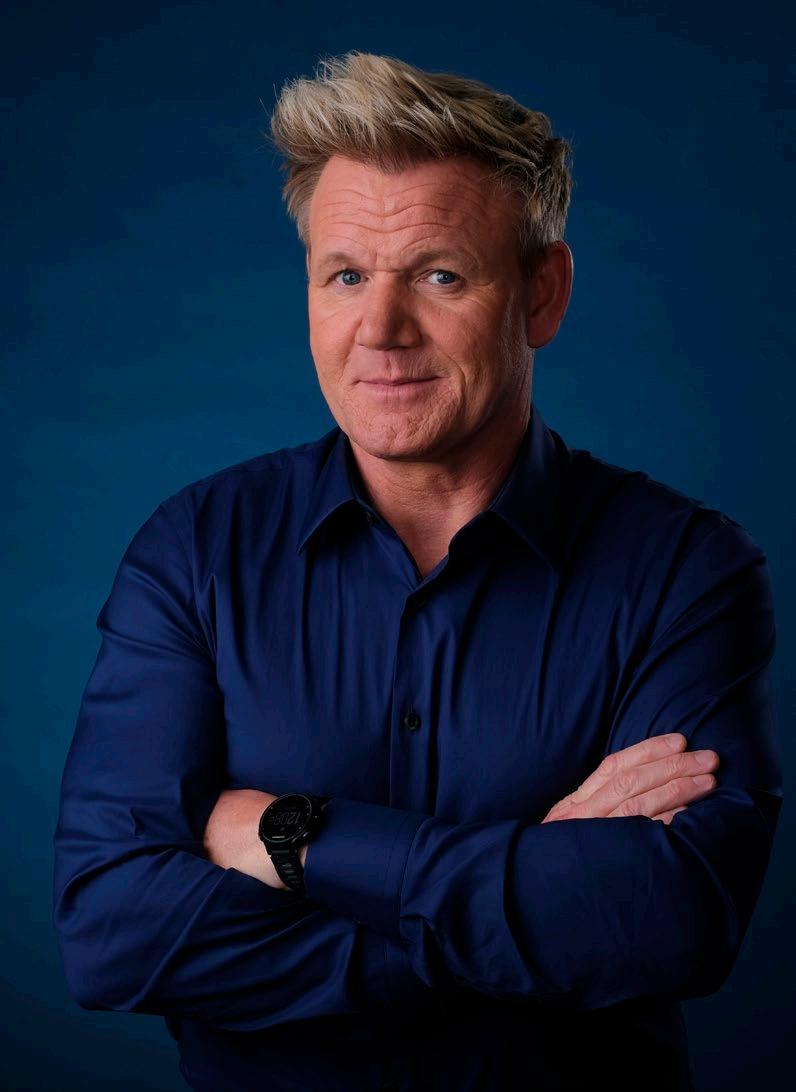
ENTERTAINMENT
Gordon Ramsay:
“If You Don’t Like It, Turn Over”
by Paul Dargan
Why is Gordon Ramsay’s approach to his craft, his business and life itself confrontational and committed, yet utterly compelling?
Read up on the great philosophers, or listen to one of our astute thinkers of the modern era, and most will tell you that arrogance is a shield to a lack of knowledge and some very deepseated insecurities.
That makes understanding Gordon Ramsay something of a conundrum. Even the chef and restaurateur’s greatest admirers recognise a sense of haughtiness in the make-up of someone who has persistently hunted down the next challenge.
The most decorated chefs are where they are because of their ability to perform, manage and excel in one of the most stressful work environments imaginable.
“I’m the same as anyone else,”
says Ramsay. “I’m the product of discipline, bloody-mindedness, passion, being organised, being clear in my goal, and perhaps even a bit of selfishness. You know, success won’t just fall onto your lap—you’re going to have to work f*****g hard for it; but I will guarantee you that with the right amount of effort and a basic requirement that you’re not an idiot, you can get somewhere… anyone can.”
Of course, the Gordon Ramsay we encounter away from the pressured atmosphere of the restaurant is very different to that bullish, bulldozing, bombastic character who stomps, swears and curses his way through various globally distributed television series and concepts.
AUGUST 2020 • 21

 Evander Holyfield, Gordon Ramsay, Oscar De La Hoya on CelebrityMasterchef (Below); The Gordon Ramsay restaurant in Paris hotel, Las Vegas
Evander Holyfield, Gordon Ramsay, Oscar De La Hoya on CelebrityMasterchef (Below); The Gordon Ramsay restaurant in Paris hotel, Las Vegas
Without for a moment suggesting the 53-year-old Scot is softening in his middle years, in conversation he is reflective, grateful for what he has, loving and funny… although still unapologetically brash.
“My advice on this one has always been the same,” he says, addressing his love of an expletive. “If you don’t like it, turn over. You have to appreciate the pressures of the kitchen and that environment. It looks like a lovely serene, woolly, fluffy place frontof-house and that’s the whole point—you wouldn’t want to keep turning up for meals where the staff were ripping shreds off one another; but it needs to be high pressure out the back. And only when you’ve seen that situation do you really appreciate what it is we go through.
allowing the lure of expansion to divert him into areas outside his comfort zone, he’s always acted quickly when challenges approached. And never was critical action more required than in spring this year when the coronavirus pandemic struck.
As expected, some sections of the press leapt on his furloughing of an estimated 500 members of staff, but the blanket shutdown of hospitality across almost the entirety of his global portfolio—that’s an empire of 34 restaurants and bars, 16 of which are in London— has provided the greatest commercial challenge in his two decades in business.
“YOU HAVE TO APPRECIATE THE PRESSURES OF THE KITCHEN AND THAT ENVIRONMENT”
“It’s stress—pure, unadulterated stress. It’s not pleasant for anyone, and someone being offended by an expletive is really going to be the least of my f*****g worries!”
Through all his crudeness, in 2020 Gordon Ramsay’s eponymous empire is a meticulously curated, globally renowned brand. Much of that is down to its founder’s measured pursuit of what he is good at—never
“We have to imagine these as new openings,” he told the press in June. “Forget the salt and pepper, it’s hand sanitiser. Forget the long-winded descriptions, forget table sides. Temperature checks—all these things are going to come into play.”
Tough times are to follow, undoubtedly. “There will be substantial losses next year, there’s no two ways about that,” he says, predicting too that the restaurant business will not return to any semblance of normality until Christmas, and even then won’t be functioning at full capacity until spring 2021.
AUGUST 2020 • 23
READER’S DIGEST EVERETT COLLECTION INC / YAACOV DAGAN / ALAMY STOCK PHOTO
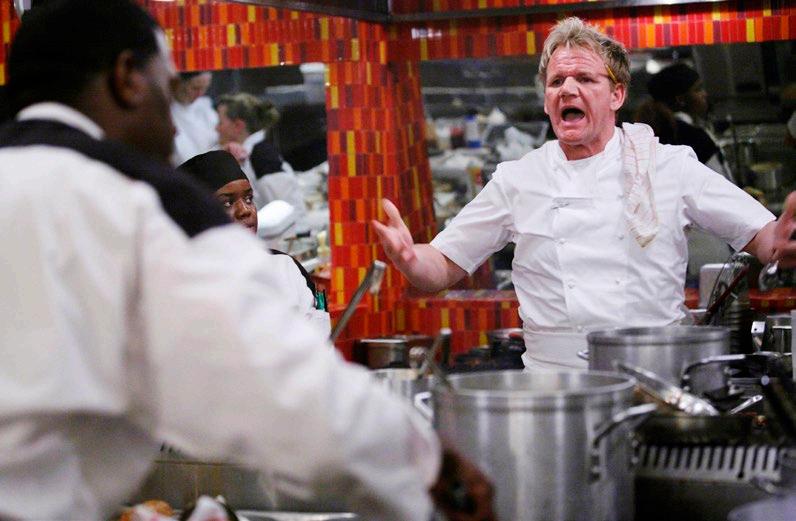
Coronavirus has provided Ramsay with a battle for survival even more profound than the one he saw off back in 2008 when the global financial crisis saw a near 40 per cent dip in trade. The chef’s geographical strength—premium restaurants, many in London’s financial district— is also his main weakness… not that he would ever let the fear show.
“We are going to come back stronger; it will be treated as a new start, a new opening… something better than we were doing before we closed. That’s how we survive.”
While Ramsay may begin to feel encouraged by the slow emergence of a “new normal” in the industry, he’ll take confidence too from the steely successes that have patterned
so much of his past. From his first project, Restaurant Gordon Ramsay, established in Chelsea in 1998, to the 16 Michelin stars acquired over the years, to the exporting of his own unique brand to foreign shores, including the US and the Middle East, Ramsay has always come through. Perhaps it’s the thrill of the chase—even at the peak of his powers with terrestrial shows Ramsay’s Kitchen Nightmares, Hell’s Kitchen and The F-Word engaging a nation in the concept of food celebrity for the first time, the now father of five uprooted for the States and the potential of an expansive new market.
“I was never worried that the production concept of those shows
Gordon Ramsay in Hell’s Kitchen
24 • AUGUST 2020
wouldn’t work somewhere else,” he says. “We had a really good few formats in the UK that we’d played about with, and I knew that whatever worked in the UK should work in the US.
“And of course, the one thing that unites the Brits and the Yanks is that we f*****g love our food; and getting slagged off by so many other countries creates a unity that keeps us together,” he laughs.
What helps too is the realisation that the UK is truly producing some of the best food experts in the whole world.
Acknowledging the French and Italians at the industry’s top table, he adds, “We have joined them there by virtue of our diversity and ability to draw in, celebrate, style and reimagine traditional global cuisine. It has taken us to the next level.
child-like giddiness that will always keep Ramsay at the top. For all his impassioned speeches, rants and dressing downs when in the kitchens of others in his reality shows, when it comes to gauging his own survival prospects, the chef is self-assured in his poise.
“I have always had confidence in myself when it comes to work, largely because I’ve achieved everything I’ve set out to. I can’t afford to worry.
“THE ONE THING THAT UNITES THE BRITS AND THE YANKS IS THAT WE F*****G LOVE OUR FOOD”
“The French won’t do that—they want to be the French, and they’re bloody good at it. The Italians have probably got the best food staples you could ever wish for, yet the UK and the US have always been a melting pot, and our dinner plates have a strength and a versatility that others just can’t get near. It’s exciting times,” he says. It all adds up to a passion, a determination and almost
“When [wife] Tana and I sold our first home to raise the money for my breakthrough restaurant, it was a nervy time. We were back in rented accommodation in London with no guarantee whatsoever that things would work out the way we hoped, but that fear was the absolute driver in terms of pushing forward and ensuring that every last ounce of effort was invested in the brand and the business.
“As you get older and become wealthier, you have more to fall back on, but still it amounts to the same thing whether it’s a big investment or a small one—you don’t want to fail, and that fear of failure, combined with the motivation for the next ‘thing’, is what galvanises me more than anything else. I love the feeling.”
AUGUST 2020 • 25
READER’S DIGEST
EVERETT COLLECTION INC / ALAMY STOCK PHOTO
The ability to read an audience— or spar with it, in Ramsay’s case where his live cooking demos are concerned—certainly helps. Those same audiences have always embraced the somewhat voyeuristic appeal of a man who’s battling with his temper, so it’s little wonder Ramsay really is the reality king of the kitchen.
“A temper? Me?” he chips back, with a wry smile. “I think the big thing is wanting a job to get to the point where you sit back and savour it. And the fact is, if you have some idiot stood in your way, preventing that, then of course you’re going to get mad.
“You must remember too that the kitchen is a pressured environment. It’s hot, it’s smelly, it’s unwelcoming and it’s the place where the demands on you are incessant, and where absolutely everything you produce will be scrutinised to the hilt.”
Moving forward into the frontline that is front-of-house has been a progression that’s great for TV, though for someone driven to cook, who was trained, enriched and inspired in the kitchens of Pierre Koffmann and Marco Pierre White, it’s clear Ramsay misses the cut and thrust.
As a cultural mainstay who has been on our screens now for two decades, Ramsay’s tone and

temperament appeal to perhaps the widest possible demographic. Whether tuning in for the passion, the politics or simply to find out how to boil a quail’s egg, the food industry would be a much diluted place without his presence. What he gives to those who watch him is a route to achieve greatness—his is a brief to be followed, and stray from that at your peril. But buried beneath the bluster and bloodymindedness is someone who has battled hard to get to where he is.
“Unfortunately what social media has given us is unparalleled access
26 • AUGUST 2020
INTERVIEW: GORDON RAMSAY

into the lives of rich and famous people, and typically what you see, is those people in their leisure time. You are not witnessing the hard graft, so it becomes something of a distorted picture, and I do think that’s dangerous.
“Me, I wanted to become one of the best, so I knew I had to work with the best, and that’s exactly what I did. So as my mates were progressing into the first-team at Rangers,” he says, referencing a promising football career that had him on the books at the Scottish giants, “I was buzzing my arse off in
France, taking s**t from the French, being called ‘rosbif’, all sorts of names, and being asked, ‘What are you doing over here?’
And yet, the harder the time I got, the more focused it made me.”
And the “arrogant” tag? Well, one of Ramsay’s tutors, Marco Pierre White, famously stated that, “success was born out of arrogance”.
“Listen, I worked under Marco and learned so much from him. Angry, brutal, exacting and hard as nails.”
He pauses, “I don’t think too much of him rubbed off on me…”
AUGUST 2020 • 27
n CHRISTOPHER PILLITZ / ALAMY STOCK PHOTO
Gordon Ramsay and Marco Pierre White at Harvey’s Restaurant, London, 1988

28 ENTERTAINMENT

I REMEMBER… Judy Collins
Seattle-born singer Judy Collins, 81, has been in the business for more than six decades. She looks back on a musical childhood, dating Stephen Stills and meeting John F Kennedy
…MY FIRST MEMORY IS DANCING WITH MY FATHER on a street corner when they announced that the Second World War was over. I was three years old at the time and I recall him carrying me on his shoulders as everyone around us seemed so happy and elated.
…I WAS THE OLDEST OF FIVE SIBLINGS and I like to say I was “trained” rather than “raised” because I was taught to play the piano from a
young age. When I was five, I was taken to a dance class and I did poorly so I then went to a piano teacher and I did well. My father was a singer, songwriter, performer and radio show host so I heard all the great songs and I sang in the church and school choirs. It was a very busy childhood.
…MY REPORT CARD AT SCHOOL SAID “NEEDS IMPROVEMENT.”
Both in Seattle and Denver, where we moved when I was ten years old,
AUGUST 2020 • 29
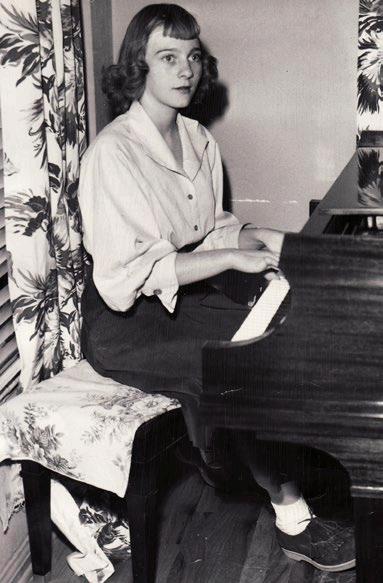
I was always being pulled up for my behaviour in class because I guess I didn’t pay much attention to subjects I wasn’t good at, like algebra. But I was pretty good at geometry and singing.
…MUM WAS AN INCREDIBLE WOMAN. She sewed our clothes, cooked our food, drove a Red Cross van during the war and had her own book club for 40 years. Both my parents had ethics and they were disciplined but kind.
…I WAS HOSPITALISED WITH POLIO WHEN I WAS 11. I was on an isolation ward for a couple of months
and my mother blamed it on the fact that four years earlier I’d been at a vaccine fundraiser in Los Angeles where my father was singing. They were showing off the iron lung and put me in one, but Mum wasn’t amused and later she blamed the iron lung for my polio. Funnily enough, Joni Mitchell was also in the same hospital at the same time and we’ve since shared stories about it.
…MY PIANO TEACHER DIDN’T APPROVE OF MY MOVE INTO FOLK MUSIC. My teacher Antonia Brico was a world-famous conductor and pianist and I played a Mozart concerto with her orchestra when I was 13. A couple of years later I was supposed to play a Rachmaninov concerto with the orchestra but by then I’d fallen in love with folk music and wanted to devote my time to learning that.
…PLAYING THE FOLK CLUBS WAS SO EXCITING. After leaving high school I performed in clubs in Colorado and then in New York, and I just loved it. I made my father get me a guitar and I was off to the races. By age 22, I’d released my first album and I’d already made six of them before I recorded Wildflowers in 1967 and had my first big hit with my version of Joni’s “Both Sides Now”.
…I HARDLY NOTICED WHEN I BECAME SUCCESSFUL. I saw the success of the Wildflowers album as
30 • AUGUST 2020
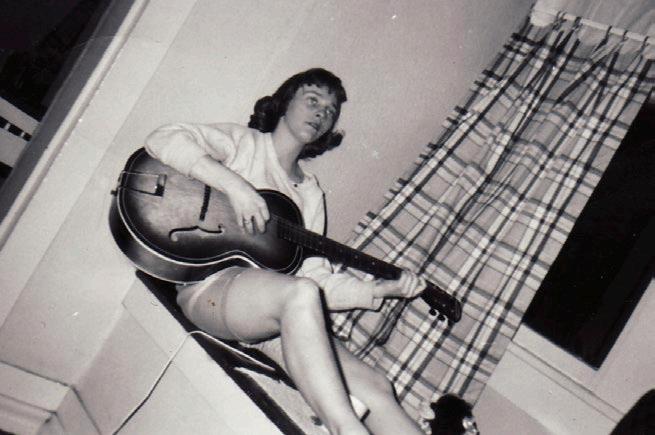
a continuation rather than a turning point. I’d been on the road since I was 19, I was now 28 and I was still on the road. When they started playing my songs on the radio I got a lot of attention and I had a few dollars so I was able to send my parents on vacation to Hawaii and buy my mother a car but that was about it. Everything else kind of remained the same.
…STEPHEN STILLS AND I HAD AN AFFAIR when he played on an album of mine called Who Knows Where the Time Goes which lasted long enough for him to write “Suite: Judy Blue Eyes” for me. We’ve remained friends for more than 50 years and two years ago we went on tour and did 115 shows in a year and a half. We were on stage
together for two hours solid and we didn’t have one single fight. Crosby, Stills and Nash had fights all the time but we didn’t.
…I WAS FAMILIAR WITH “AMAZING GRACE” because people in my family, like my grandmother, sang it and everybody seemed to know it. One night in 1969 I was at an encounter group in New York City that I belonged to and a friend of mine, the record producer Mark Abramson, said, “I think you’d better sing something because people are getting upset with each other and they’re ramping up to some sort of an argument.” So I sang “Amazing Grace” and he called me the next day and said, “You should record that.” We tried to do it with a band, then I said,
AUGUST 2020 • 31
With Leonard Cohen

I REMEMBER… 32 • AUGUST 2020
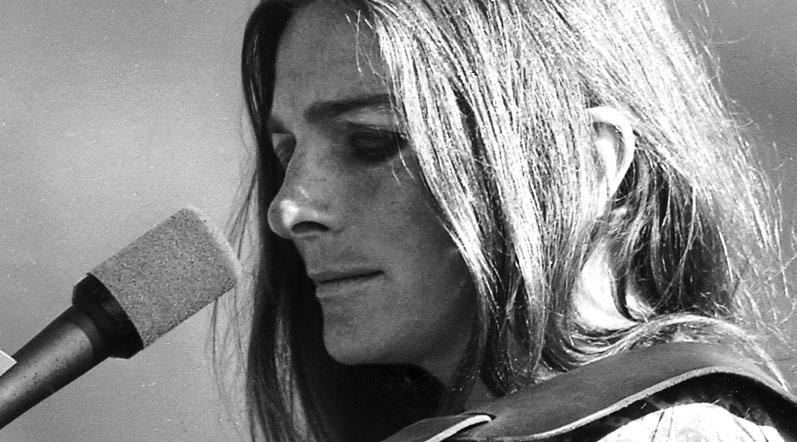
“We have to do it a capella because that’s the way it’s usually done.” So we went uptown to the little chapel at Columbia University and recorded it in this gorgeous chapel, Saint Paul’s Chapel, with a little choir.
…WHEN I RECORDED “SEND IN THE CLOWNS” a few years later I was in one of those desperate places where I didn’t know what to do next. Then a friend told me about the Stephen Sondheim song and it felt like karma. Hal Prince, the producer of A Little Night Music which the song was from, told me that about 200 people had already recorded it and I said, “I don’t care.” My record company got a phone call the night before my version came out in 1973 from Frank Sinatra’s “people” saying they’d like me to hold off releasing it because he’d also recorded it.
[Laughs] I’m sure you can imagine what they told Mr Sinatra’s “people” in response to that!
…I TOLD MY FATHER, “I’M NEVER GETTING MARRIED” when I was five years old and I’ve been married twice, so so much for promises. My first marriage [to Peter Taylor in 1958] only lasted a few years but we did have a son, Clark. Then I met Louis [Nelson, a designer] in 1978 at a fundraiser and we’ve been together ever since. We didn’t get married until 1996 and only then because of the legal technicalities.
…LOSING MY SON TO SUICIDE WAS DEVASTATING. That was in 1992, when Clark was 33, and I wrote a book about it [Sanity & Grace] because I wanted to get all my feelings down on paper. I’m a
AUGUST 2020 • 33

survivor of my own suicide attempt when I was 14 and suffering from depression, then to lose my son to it was terrible. He’d been sober for seven years so I thought he was OK, but the main thing I’ve learned is there is no guilt in suicide—you didn’t cause it and you couldn’t have stopped it.
…IT WAS SUCH AN HONOUR when artists such as Dolly Parton, Chrissie Hynde and Joan Baez recorded the Born to the Breed album as a tribute to me in 2008. I was so thrilled that Leonard Cohen also appeared on the album. I discovered him when I recorded his song “Suzanne” back in the 1960s. Well, it was mutual—we then discovered each other.
…I’VE HAD SO MANY CAREER HIGHLIGHTS. Recording “Amazing Grace” is right up there. Playing the Royal Albert Hall in the 1960s when it was jam-packed wasn’t bad. Getting nominated for a Grammy [for Silver Blue Skies in 1996] for the first time in more than 40 years was pretty wonderful and it’s the longest time anyone has ever gone between nominations so I’m now in the record books.
…MEETING JOHN F KENNEDY WASN’T TOO SHABBY. That was in 1963, the year that he died, when I sang for him at a big dinner thrown in his honour. Did I swoon when I met him? I absolutely did, I just wish I’d worn my off-the-shoulder dress. He shook my hand and when you shake the hand of a President like JFK or Obama, electricity goes through your whole body. You feel like you’ve met royalty—and I haven’t met the Queen yet but I’m hoping.
…REVISITING “AMAZING GRACE” NOW FEELS LIKE THE PERFECT TIME. I heard that this gentleman [Notting Hill vicar Pat Allerton] had played my version in the street near Charing Cross Hospital and I was so moved by that. I thought, How great that this song can be healing because he’d chosen it to play it for all the health care workers. After I recorded it the first time I found out from Steve
34 • AUGUST 2020
With Stephen Stills in 2017
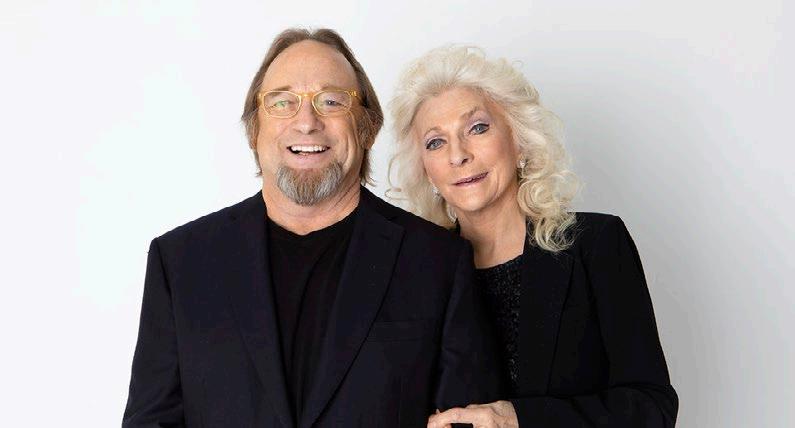
Turner, the writer in London, that he was writing a book about the song’s composer John Newton and he asked me to write the preface, saying to me, “You’re the one who rescued the song from drifting into obscurity.”
That’s when I learned about John Newton himself and how he evolved from being the captain of a slave ship to a writer of powerful hymns. His
life is a transformational story and I’m sure that’s why the song has such power it has. n
As told to Simon Button
Amazing Grace by Judy Collins and the Global Virtual Choir is out now, with all proceeds going to the World Health Organisation Response Fund. For more information visit judycollins.com
Do As The Romans Do
Take our test to see how much you remember about ancient history from school
1. What was the first capital of ancient Egypt?
A: Memphis B: Thebes C: Alexandria D: Baltimore
2. On what island did ancient Greek civilisation originate?
A: Crete B: Samos C: Olympia D: Rhodes
3. Who is considered the founder of the Xia Dynasty in ancient China?
A:Tang B: Yu C: Qi D: Shu
4. How many years did the Peloponnesian War last? A:16 B: 27 C:39 D: 54
5. When did the first documented Olympic Games take place?
A: 776 B.C. B:432 B.C. C: 112 B.C. D: 6 A.D.
AUGUST 2020 • 35
1: A; 2: A; 3: B; 4: B; 5:A
HAVE YOU CONSIDERED RELEASING EQUITY?

Find out today why so many over-55 homeowners have accessed their home’s wealth
For the UK’s over-55 homeowners, a large proportion of their wealth is tied up in the bricks and mortar of their homes. If you are in this situation and in need of finding a way to access some of that wealth tied up in your home, there are options available to you.
You might consider downsizing to a smaller home and releasing some of the equity in your home that way. If considering this, there will also be the accompanying costs of moving, not to mention the emotional stress of having to say goodbye to the family home.
If you wanted to remain in the family home whilst still gaining access to your home’s value, you could consider an equity release product. The most popular of these products is a Lifetime Mortgage, which will allow you to borrow a tax-free cash lump sum against the value of your home, without being required to make any monthly payments.
You will maintain 100% ownership of your home, with the mortgage and interest only needing to be repaid once you and your partner have either passed away or entered permanent long-term care. In most cases this is achieved with the sale of the home.
PARTNERSHIPPARTNERSHIPPROMOTION PROMOTION

Why Reader’s Digest Equity Release?
At Reader’s Digest Equity Release Service, we can offer you a free no obligation phone call with our Information Team. They cannot sell anything to you and are only there to answer the questions that you might have, as well as provide an estimate of how much you could release. Should you be interested in learning more, the Information Team can book you a no obligation appointment with your local fully qualified equity release specialist. Your local adviser will be able to tell you if equity release is your best option, as well as assess the impact it could have on the value of your estate and entitlement to means-tested benefits.
What could you do with your released equity?
The choice of what to do with your taxfree cash lump sum is entirely up to you, but if you need a little inspiration here are some popular uses:
• Clearing an existing mortgage
• Boosting disposable income
• Undertaking home improvements
If you want to learn more about your financial options in retirement, then contact us today and request your free copy of the Reader’s Digest Guide to Equity Release. n
FOR MORE INFORMATION readersdigest.co.uk/er2 Call 0800 029 1233
MESSING WITH OUR HEADS
For many balding men, wigs, dark humour and stoicism often mask deep distress. What options do they have in the battle against hair loss?
by Rhodri Marsden From moSAICSCIENCE.Com
When I was a teenager, my mother reassured me that I wouldn’t go bald in my twenties like my father had.
“Look,” she said, pushing back her hair from her forehead, “You’ve got my hairline, not your dad’s.”
Within ten years her argument was revealed to be magnificently wrong. My hairline began its slow march north, a clear sign that I’d inherited male-pattern hair loss from one of my
parents, if not both of them. As the years went by I persuaded myself that ever-shorter haircuts made me look better than I used to. But deep down it felt unfair, a genetic quirk I didn’t deserve. I’d wince as the barber held up the mirror behind me, revealing an ever-expanding bald patch.
I pretended not to be bothered, and that pretence continues today, in my forties. But while stoically accepting hair loss as my destiny, I don’t like it. I’ve found myself wearing hats
HEALTH
38 • AUGUST 2020

39 39
and growing a beard, attempts at misdirection that fool nobody, least of all me.
Androgenetic alopecia is the medical term for my inherited form of hair loss. While it affects both men and women, marketing by hairloss treatment companies mostly targets male anxieties. The industry is estimated to be worth at least £1.2 billion a year worldwide.
“PEOPLE SAY [BALDING] IS MUCH HARDER FOR WOMEN. THAT'S NOT WHAT I FIND”
According to the UK’s National Institute for Health and Care Excellence (NICE), male-pattern hair loss affects 30 per cent of men under 30, increasing to around 80 per cent of men over 70. Its causes are wellestablished, if poorly understood by those of us who have it. The hormone dihydrotestosterone (DHT) is synthesised from testosterone by an enzyme, 5-alpha-reductase, that's found at the base of the hair follicle. This sets off a process of miniaturisation in hormonally sensitive areas such as the forehead and crown. The follicles shrink and, as the American Hair Loss Association puts it, they stop producing “cosmetically acceptable hair”.
The first consequence of this is
progressive baldness. The second, and arguably more important, consequence is the psychological effect it has on many men. A 2005 study of men with hair loss in Germany, France, Italy, Spain and the UK found that 43 per cent were concerned about its effect on personal attractiveness, 22 per cent worried about its impact on their social life, and 21 per cent linked it with feelings of depression.
“I’d say that the most desperate emails, the people who sound like they’re at their absolute lowest ebb, tend to be from men,” says Amy Johnson at Alopecia UK, a charity that offers support and advice to men and women with all types of alopecia. “When people say it’s much harder for women, and for men it’s all right, I say actually, no, that’s not what I find.”
An internet search returns a disorienting array of options that promise to alleviate the misery of the balding man: herbal remedies, surgeries, hair pieces, shampoos and nanofibre sprays that “colour in” bald patches. Some of them work, in that the hair loss might be less apparent, but what works for one person might pan out disastrously for another.
Here are some of the options available to balding men.
WIGS AND HAIRPIECES
Jay Patel, the co-founder of wig company MH2Go, sits in his office in central London, fiddling with a
40 • AUGUST 2020
MESSING WITH OUR HEADS
pen as he recounts his tale of hair loss. “About four or five years ago I tried to commit suicide,” he says, adding that his state of mind was worsened by body dysmorphia.
“I was in hospital for three weeks, and I got a lot of support. After that I told everyone that I wore a wig, and the whole burden just lifted. I stopped feeling ashamed.”
Patel is a goodlooking chap, and he’d look great with or without hair. But having told me about his wig, he forces a smile. He knows that I know.

“I’ve turned something that was an issue into my livelihood,” he says.
From the street, MH2Go’s premises look like a regular hair salon, but inside Patel offers advice to people looking to buy wigs, while his business partner, Egita Rogule, styles and fits them. Prices, by wig standards, are very reasonable: £640 for the first and £320 for each subsequent “system”, each of which should last the user between four and six months.
Patel looks at my forehead. “You see,” he says, “you wouldn’t be a
good hair transplant client because of the larger area to cover. It’s just not feasible.”
He picks out a hairpiece from a box. “Do you want to try one?” I reluctantly sit down in front of a mirror. Patel puts it into position and stands back.
"Actually,” he says, “it looks quite good.” I’m inclined to agree—but at the end of the day, it’s a wig.
“I do my consultations in a way that makes people aware of what they’re getting themselves into,” says Patel. “I say, look, it’s a wig. We’ll make it look the best we can, but you’re still wearing a wig.” His honest approach
AUGUST 2020 • 41
ILLUST r ATIo NS (pr E v I o US S pr EA d AN d T h IS p A g E ): IST o C k
Hair loss usually begins at the temples, with the hairline gradually receding

Follicular unit transplantation (FUT) involves transplanting a patient’s natural hair into balding areas
stems from bitter experience. In his early twenties, he paid a company many thousands of dollars for a series of wigs that lasted just a few weeks.
TRANSPLANTS
Nadeem Uddin Khan, director of the Harley Street Hair Clinic in London, knows how painful the experience of hair loss can be. He shows me a picture on his phone of a balding guy, good-looking, perhaps slightly selfconscious. Again, I instinctively look back up at his current hairline: it’s neat, buzz-cut and very different from the one in the photo. “That was about ten, 12 years ago,” he says. “When I lost my hair it was just terrible. A year
of not going out. So I understand what these guys go through.”
Khan had the follicular unit extraction (FUE) method of hair transplantation, which his clinic now specialises in.
After donning some protective clothing, I’m led into a surgery, where a man under local anaesthetic is lying on his back as a doctor makes incisions in his forehead. He spent the morning lying on his front as follicles were extracted from the back of his head; later they’ll be popped into their new location. It’s his second operation; he was so delighted with the results of the first that he’s come back for another.
All hair transplants are based on the principle of donor dominance, developed in the 1950s by New York dermatologist Norman Orentreich: a transplanted follicle continues to grow as if it had been left where it was. By the 1980s, experiments with grafting had developed into follicular unit transplantation (FUT), or strip surgery. A strip of the scalp is removed and cut into very small segments, which are inserted into small holes in the affected area.
42 • AUGUST 2020
ADULT AUTISM
It’s a quicker procedure than FUE, and is considered by some to be the best way of harvesting high-quality hair. However, it leaves a long scar where the strip has been removed.
THERE IS NO MAGIC SOLUTION THAT WILL MAKE HAIR RE-SPROUT FROM A BALD PATE
FUE clinics tend to be quick to denigrate FUT, but FUE also has its drawbacks. As I witnessed at the Harley Street Hair Clinic, it’s a gruelling process that requires great concentration and stamina on the part of the physician, and enormous patience from the patient. Thousands of individual follicles are extracted with a special tool and transplanted into tiny incisions. “The procedure for me—around 3,000 grafts—was so labour-intensive that it took all day,” says one man who underwent an FUE transplant in Australia.
Expertise is the key to a good FUE transplant, according to Khan. “The transplants should be done by a physician who knows what they’re doing,” he says.
“The right follicle has to go in the right place. Mother Nature doesn’t work in straight lines. These little design details are critical.”
Sadly, not everyone performing
these operations pays close attention.
“There are tens of thousands of clinics,” says Spencer Stevenson, a British advocate for men experiencing hair loss. “Often you have nurses performing surgery in the back of a dentist’s office! It’s unbelievable."
Given the risks associated with dodgy clinics, why do men put themselves through these procedures? The belief that a full head of hair gives men greater masculinity and sex appeal is deep-seated, and the industry has never dispelled it.
“The reality of Western culture is that young is beautiful, more successful, more attractive,” says Anthony Bewley, a London consultant dermatologist. “If you are older, uglier, scarred and bald, it’s not just about what that means in terms of your ability to succeed or be attractive; it’s also, sadly, marked out as being less worthy.”
Jay Patel knows the feeling. “I used to have really thick hair,” he says wistfully. “In our culture, South Asian culture, if you don’t have hair, you’re not going to get marriage proposals.”
Patel tells heartbreaking stories of clients who arrive for assisstance at his shop, traumatised.
“One guy spent half an hour standing outside because he was too scared to come in and even discuss hair loss,” he said. “He eventually came in, wearing a bandana, which he was really reluctant to remove. He wanted the door closed.”
AUGUST 2020 • 43 READER’S DIGEST
ILLUSTRATIONS: ISTOCK
“WE CAN'T CURE HAIR LOSS. WHAT MEN NEED IS HELP TO COME TO TERMS WITH IT”
MEDICATIONS
Another, seemingly easy, way of treating male-pattern hair loss is through drugs. From the sales pitches and glowing testimonials for various foams, sprays, creams and tablets, you’d think that there would be at least one drug, one magic solution, that would make hair re-sprout from a bald pate. But it isn’t so. There are just two approved drugs on the market: minoxidil, a topical formula; and finasteride, a tablet. It’s generally agreed that neither reverses hair loss but merely delays the inevitable.
The link between minoxidil and hair growth was first noticed in the 1960s, and the US Food and Drug Administration (FDA) approved it as a hair-loss treatment in 1988 with the proviso that it “will not work for everyone”. Trials have shown some form of regrowth in as many as 80 per cent of patients, but a 2015 review of the efficacy of minoxidil stated that “cosmetically acceptable results are present in only a subset of patients”.
“It’s a bit of a plaster,” says Spencer Stevenson. “It’s a good add-on as part of your regime, but on its own it’s not going to get you too far.”
Finasteride, meanwhile, has been available for hair growth under the name Propecia since 1997. Some of the side effects listed by the FDA, including erectile dysfunction and libido disorders, can put men off.
“There are millions of people taking finasteride with no side effects,” says Stevenson, “but you don’t hear from them. All you hear is the minority of people who have, and they put the fear of God in everybody.”
Many dietary supplements with medical-sounding names also claim to promote healthy hair growth. The merits of supplements such as TRX2 and Viviscal are vigorously debated online, but the National Institute for Health and Care Excellence's guidance on androgenetic alopecia doesn't mention any dietary supplements.
NEW TREATMENTS
While those arguments rage on, the pursuit of a wonder drug continues. One US company, Allergan, has two potentially promising drugs undergoing trials: a topical treatment, bimatoprost, which was approved by the FDA in 2008 to assist with the growth of eyelashes; and an oral medication, setipiprant, which inhibits a compound, prostaglandin D2, that’s found to be elevated in balding scalps.
Another US company, Samumed, has picked up a huge amount of media interest for another potential
44 • AUGUST 2020 MESSING WITH OUR HEADS
treatment, SM04554, but some experts have found their clinical data to be less impressive than their marketing acumen.
“There’s a lot of research being done, and a lot of avenues look interesting, but it’s a question of whether they come through all the rigorous tests to become an effective treatment,” says Susan Holmes, a hair-loss expert at the British Association of Dermatologists.
“Hair is just a difficult thing to make grow.”

Stevenson sees hope in the cloning of hair follicles, which could give transplant patients a more plentiful source of hair.
“Hair cloning, neogenesis, induction, it’s all the same thing,” says Claire Higgins, a lecturer in the Department of Bioengineering at Imperial College London, “but it’s really hard to do.”
maybe the only thing that can help balding men is psychological support.
“We know we can’t cure hair loss,” Holmes says. “What men need is help to come to terms with it.” Given our poor track record, is there any likelihood that balding men like me will ever accept, even relish, our slow shedding of hair?
Milan Stolicny hopes so. His website, baldattraction.com, offers a joyous appreciation of balding heads, and urges men with receding hairlines to embrace their baldness.
Researchers are turning their attention to the next big frontier in hair science—cloning
“Bald is very attractive!” he says. “Bald men can wildly succeed in this world!”
Stolicny offers no quackery, no remedies or potions—just enthusiastic support.
“The true baldness cure is to become an attractive bald man,” he says. In other words, you have to believe in yourself.
If balding men were able to change their attitude, a huge industry would suddenly disappear overnight. But it knows only too well that Stolicny’s solution, while beautifully simple, is perhaps the hardest of all methods to achieve. n
AUGUST 2020 • 45
From moSAIC SCIENCE (SEpTEmBEr 4, 2016). ThIS vErSIoN wAS CoNdENSEd By rEAdEr'S dIgEST. CopyrIghT © 2016 By rhodrI mArSdEN. moSAICSCIENCE.Com

SICK OF SUMMER?
While the warmer months bring many delights, they can bring health issues, too

Susannah Hickling is twice winner of the Guild of Health Writers Best Consumer Magazine Health Feature
Lyme disease
This bacterial disease is spread via tick bites. You can pick up ticks in urban parks and even the garden, as well as in country areas, especially in southern England and Scotland. It’s important to catch Lyme disease early, as it can turn into a long-term debilitating illness. Fatigue and joint pain are common, but it can even affect the heart. It usually begins with flu-like symptoms and a circular rash around a tick bite. Wear long trousers and enclosed shoes if walking in woodland or grassy areas, and remove a tick promptly by gripping it close to the skin with tweezers and pulling steadily.
46 • AUGUST 2020
HEALTH
Weil’s disease
Also known as leptospirosis, Weil’s disease is spread in the urine of infected animals, such as rats and mice. If that sounds disgusting and unlikely, you’re right on both counts, but if you enjoy swimming, fishing or kayaking in rivers, there’s a chance you could catch it. It causes flu-like symptoms initially. These can be treated with antibiotics. But leave it and Weil’s disease can turn serious, even potentially leading to liver or kidney failure. To prevent it, shower after being in freshwater.
Food poisoning
We love barbecues, but there’s a risk that your grilled chicken and salads could make you ill. Don’t leave meat out of the fridge too long in warm weather or bacteria might spread, and make sure it’s cooked right through. Cross-contamination is another danger—avoid letting raw meat come in contact with other foods via utensils or chopping boards, and wash your hands after touching it. Chill cold foods until you’re ready to serve them.
Sunburn
We all know the score, but we can still find ourselves caught unawares. Try to avoid direct exposure to the sun between 11am and 3pm—ideally by staying indoors or in the shade, or by covering up. Use sun cream of at least SPF 30.
Heat stroke
Spend too long in the sun and you could get heat exhaustion, with headache, dizziness, nausea, sweating, cramps and a high temperature. If you don’t cool down quickly at this point, preferably by sponging with cold water and drinking water, heat exhaustion could turn into heat stroke. This can sometimes cause seizures and loss of consciousness, and is a medical emergency.
Bites and stings
Attacks by mozzies, horseflies, wasps and the like are unpleasant but the consequences clear up quickly. However, some people suffer a severe allergic reaction with swelling in the mouth and throat, dizziness and difficulty breathing. This requires urgent medical attention. Wash bites and stings with soap and water, apply a cold compress/ice pack and elevate the affected part of the body.
Athlete’s foot
Dry your feet well after washing them, particularly between the toes, to avoid the cracked, painful skin that’s the tell-tale sign of this fungal infection. Pharmacy treatments work but might take a few weeks. Change your socks every day and avoid shoes which make your feet hot and sweaty.
For more weekly health tips and stories, sign up to our newsletter at readersdigest.co.uk
AUGUST 2020 • 47

Paw-Sitive News
Furry friends are good for your health
Owning any pet is beneficial to health—especially mental health— research has found. And sorry if this offends cat and rabbit lovers, but having a dog will almost certainly score you more health points. That’s because you’re obliged to walk a dog, which means that having a canine companion makes you more active as well.
The government recommends we spend two and a half hours a week taking moderate exercise, including brisk walking. Most dog owners do way more exercise than that, which not only keeps them fit but also helps keep their weight down. A 2017 study in the Gerontologist medical journal found that older people who walked a dog had a lower BMI, had fewer limitations in their daily activities and went to the doctor less often.
Taking Fido for walkies also improves your social life, researchers have found, no doubt because you talk to other dog owners. So you’re less likely to feel lonely if you’re out and about with a furry friend. That in
turn can help ward off cognitive decline, which is often associated with social isolation.
And there’s really strong evidence that dogs are good for your heart and might even help you live longer. A Canadian study published in the journal Circulation: Cardiovascular Quality and Outcomes found that cohabiting with a canine was associated with a 31 per cent drop in deaths from cardiovascular causes and, for those who already had a heart problem, the reduction in deaths from all causes was a stunning 65 per cent.
A Swedish study in the same journal found that heart attack survivors who lived alone with a dog had a 33 per cent reduced risk of dying. Dog owners recovering from a stroke had a 27 per cent reduced risk.
Other research has shown that petting a pooch can lower blood pressure and cholesterol levels. On the strength of this evidence, you’d be barking mad not to have a dog! n
HEALTH 48 • AUGUST 2020
Ask The Expert: Eating To Boost Immunity
Alex Ruani is a doctoral researcher in nutrition science education at University College London and chief science educator at the Health Sciences Academy
How did you become an expert in nutrition to support immunity?
I qualified as a lawyer in Argentina but when I was working in the City of London, I wanted a career change. I went on to study biochemical sciences, genetics and nutrition science education, and became interested in the immune system and nutrition when my mother got colon cancer and her immune cell count fell very low.
How does your diet affect your immune system?
Seventy per cent of your immune function is hosted in your gastrointestinal system. Can specific foods or supplements make you immune? No. Can a nutritious diet support our immune system? Absolutely.
What should you eat to stay healthy?
Nutrients work synergistically. You need adequate protein from sources such as eggs, yogurt, cottage cheese, fish, and fibre from wholegrains, root vegetables like carrots and sweet potato, broccoli, red beans, red lentils, and fruit such as apples,
pears, bananas. Omega 3 fatty acids from oily fish, like salmon and fresh tuna, and egg yolks play an antioxidant and anti-inflammatory role, while probiotics—live organisms in yogurts, soft cheeses, sauerkraut— beneficially interact with cells in the immune system. Flavonoids from herbal teas, blueberries, strawberries, tomatoes and spinach also support immune cells.
What shouldn’t you eat?
Too much salt, too much alcohol, and too many calories, which mean that we can be overfed but malnourished. All three reduce the body’s ability to fight infection.
What else can people do to improve immunity?
Move your body! Exercise has an immune-enhancing effect, even cleaning the house or taking the stairs. Sleep well and for long enough, because your body regenerates while you sleep. Manage your stress levels—laugh or chat with a friend, meditate, take a walk in nature. Stay hydrated. n

AUGUST 2020 • 49
READER’S DIGEST

A Matter Of Sick Pay
Dr Max Pemberton on the commodification of Britain’s hospitals

Max is a hospital doctor, author and columnist. He currently works full time in mental health for the NHS. His new book, The Marvellous Adventure of Being Human, is out now
The shouting from outside was getting louder. I peered out of the window in the nurses’ office. From my vantage point I could see one of the senior doctors, Dr Webber, shouting and wagging his finger at a man in a uniform.
“Have some sense, man” I can hear him bellow. It seems to happen with such regularity that I’m amazed he can continue the pretence of being astounded at what’s happened. The same scene is played out week after week: once again, Dr Webber has been clamped in the hospital car park. I continue to watch the events unfold outside and am joined by a nurse.
“He’s not done it again, has he?” We both roll our eyes and laugh. But actually, it’s not that funny. Dr Webber, after all, has just been clamped for parking in the hospital where he works. The man he is remonstrating with is not a council traffic warden. He’s not even a hospital employer. He works for the private service company which runs the NHS hospital. Dr Webber doesn’t have a parking permit because there aren’t enough to go around as the
50 • AUGUST 2020
HEALTH
Trust has to pay for them. Dr Webber covers a number of hospitals and needs his car to travel between them. The fact that he’s frequently here out of hours, doing work he’s not paid for, doesn’t exempt him from being clamped though.
It’s no better for patients. In fact, I’m actually embarrassed as I walk past them queueing to pay for the privilege of parking in a hospital that their taxes are funding. Before Christmas, I witnessed the unbelievable sight of a man who had just seen his wife die in A&E being threatened with having his car towed because he didn’t have a ticket. The attendants, who it would seem have lessons in being rude, thoughtless and officious, aren’t hospital employees and as a result have no interest in the welfare of the patients.
This is actually part of a bigger phenomenon in hospitals. You might have noticed that they’re increasingly beginning to resemble out of town shopping malls: fast food outlets and chain stores have replaced League of Friends shops. A coffee at my hospital canteen cost me £3.40 yesterday while at the same hospital before being “modernised” a few years ago, it cost just 50p.
This transformation of our hospitals began after the introduction of the “internal market” in the late 1990s, which saw hospitals established as financially
independent corporations expected to generate money in order to break even. Trusts sold off land, cut back on staff, and contracted out services as a way of producing
“I’M ACTUALLY EMBARRASSED AS I WALK PAST THEM QUEUEING TO PAY FOR THE PRIVILEGE OF PARKING IN A HOSPITAL”
revenue. It is this need to develop income-generating schemes that is behind the contracting-out of car parking, as well as the privatelyowned restaurants, news agents and coffee shops which litter hospital lobbies. The companies who manage these facilities, eager to increase their profit margins, can charge premium rates because they know they have a captive market. They are mercenaries not bound by the founding principles of the NHS and the Trusts are happy to collude with them because of the income they generate for them. The doctors and nurses have no jurisdiction over these companies, and as a result are powerless to intervene when a little bit of common sense or compassion is called for. All they can do is stand and shout… and then pay up like everyone else.
n
AUGUST 2020 • 51
The Doctor Is In
Dr Max Pemberton
Q: My daughter died ten days ago of acute pulmonary oedema. She hadn’t had a kidney consultation for four years and she probably wasn’t taking her medication. I didn’t know she was risking her life and I can’t control my anger—I feel I should have known she was at risk. Do you have any advice for dealing with grief in a situation as frustrating and avoidable as this? —Thomas, 75
A: My heart goes out to you and your family. How absolutely devastating. It sounds from your letter that your grieving process is complicated by the question over whether your daughter was managing her condition, which means you have a difficult mix of emotions—desperately missing your daughter, while also being angry with her that she might have brought this on. No doubt you’re also confused as to why she would have been so reckless, not only with her life but in bringing such heartbreak to you and her family. I wish there was something I could say that would take
away how awful you must feel.
When I worked in palliative care I remember one of the senior doctors saying that the agony of bereavement is the cruel price we pay for having loved so deeply. The psychiatrist Elisabeth Kübler-Ross developed her famous “stages of grief” and this includes anger at the person who died. Knowing that what you’re feeling is common and normal doesn’t make it any less painful but sometimes people find it reassuring to know that this acute phase of bereavement does pass. Your daughter’s death is still very recent. Give yourself time.
Grieve in your own way but if you find it hard to talk to others who are close to you, then consider seeing a bereavement counsellor. Many of my patients—particularly men— have found talking to someone a bit detached from the family really helps. n

Got a health question for our doctor? Email it confidentially to askdrmax@ readersdigest.co.uk
HEALTH
illustration by Javier Muñoz 52 • JULY 2020
HEALTH

A Supermarket Haul To Remember
How much can you remember from your shopping list? Our memory expert Jonathan Hancock reveals all
was once invited to a national TV show to explain how to learn a shopping list.
I explained that one way was to picture each item, then create a funny story to link them all together. The presenter had a go himself, rattled off the entire list—and was amazed by just how easy it was.
I was glad that I’d demonstrated a useful trick. But I also wished we’d had a bit more time—because shopping can do so much more for your brain than that!
Shopping stretches a variety of memory skills. So, as a regular chore, it’s an excellent way to get frequent mental exercise, as well as to explore some useful new techniques.
First, get organised. Write down everything you want to buy, but group similar items together, fruit and veg, for example, or cleaning products. This should help you to remember what you need, as well as making the list itself easier to learn.
Next, visualise the trip. Mental rehearsal is necessary for preparing for anything. It helps you spot mistakes in your planning, and gives you a practice run that you can go back to in your memory.
As you imagine taking your usual route around the aisles, consult your paper list if you must. But try to use the familiar journey in your memory to structure your thinking, and picture yourself finding the things you need. Notice something about each item that makes it different—the package it’s in, or the way it feels, sounds or smells as you add it to the pile.
When you’ve finished, have another look at your list—and highlight anything you’re likely to forget later. To help, why not think up a funny link to something you find easier to remember. If you always buy tomatoes, for example, you could imagine one bursting, but squirting lemon juice everywhere, so that you get some of those, too.
When you’re in the shop for real, use your visualised run to help, and be alert to any trigger images that come to mind. Check your paper list before heading to the till, and be sure to praise yourself for everything you managed to remember.
By using a task like this, organising your information, visualising success, and creating a few extra reminders, you’ll find you can remember much more than you thought—in the supermarket and beyond. n
I
AUGUST 2020 • 53
• Fragrance and parabens-free!
• Takes just seconds to dry-in!
• Powerful long-lasting formula!
• 60% alcohol for effectiveness!
• Huge savings on multi-buy!
Wellform’s Antibacterial Hand Gel kills 99.99% of bacteria and flu viruses; with it’s quick drying formula - without the use of soap and water. Simply apply to the palm of your hands and spread: front, back, between your fingers and under your nails and allow to dry in JUST 15 SECONDS!
With 60% ALCOHOL CONTENT as endorsed by Health experts including NHS, Public Health England and World Health Organisation. It is commonly agreed that an effective hand sanitiser needs at least 60% alcohol content. Our Wellform Antibacterial Hand Gels contain a minimum 60% alcohol, ensuring yours & your family’s safety against nasty germs and flu and other viruses.

Post and packing online may vary. P&P is FREE on orders over £29.



















LIMITED STOCK AVAILABLE! NOW INSTOCK ORDERTODAY!
on 0871 075 0227 or online at www.staybacteriafree.co.uk Carbomer.
external use only. Keep away
broken skin, eyes and face. If in contact with eyes or face, seek medical advice immediately and show the container. If irritation develops stop using and rinse thoroughly with water. Not to be used for children under 3 years of age. ANTI-BAC HANDWASH 2 SIZES AVAILABLE 3 FROM ONLY +P&P £ .74 THE MORE All of our products are to help you stay safe and limit the spread of bacteria. For full information and medical guidance, please visit The World Health Organisation www.who.int ANTI-BACTERIAL HAND GEL KILLS 99.9% OF BACTERIA & FLU VIRUSES
Order by phone
For
from
SIZE QTY OFFER £ P&P TOTAL 1 £9.99 £4.99 £14.98 YOU SAVE 250ml 2 £16.98 £4.99 £21.97 £7.99 4 £29.97 FREE £29.97 £29.95 1 £4.99 £4.99 £9.98 YOU SAVE 80ml 2 £7.98 £4.99 £12.97 £6.99 4 £14.97 £4.99 £19.96 £19.96 250ml 1 £12.99 £4.99 £17.98 YOU SAVE AND 2 £19.98 £4.99 £24.97 £10.99 4 £34.97 FREE £34.97 £36.95 SAVE POST & PACKAGING COSTS PLEASE ADD £4.99 P&P TO YOUR ORDER FREE P&P ON ORDERS OVER £29 FAST RESPONSE & Code: H94067 Digital Thermometer BUY 1 FOR ONLY £12.99 or BUY 2 FOR £19.98 Detect a fever effortlessly with this compact & convenient easy-to-operate Digital Thermometer with LED display! A simple one-touch button, LCD display and memory recall for the last reading taken, make this digital thermometer all you need to accurately take your body temperature. Ideal for all ages – infant, child and adult –the thermometer can be used orally or rectally, easily and hygienically. Just clean the waterproof tip with soap and water or disinfectant after use. FOR THE PERFECT HOME HAIRCUT Simply wet the hair and use the comb side to detangle and smooth, then the protected blade side cuts evenly and easily – perfect for the whole family between cuts or at regular intervals for a sharp cut every time! Includes 6 refill blades. Buy 1 Hair Cutting Comb Only £4.99 BIG VALUE! Code: H94070 Buy 2 Hair Cutting Combs Only £6.98 SAVE £3 Code: Z2H94070 Order 6 Spare Blades Only £2.99 STOCK UP! Code: H94071 Order 12 Spare Blades Only £3.98 SAVE £3 Code: Z2H94071 From fine trim to extra short...ideal for facial hair too! PERFECT FOR PETS, TOO!
Safe and easy to use for men, women and children!
A choice of cutting lengths to shorten, shape and thin • Cuts beards and moustaches • Perfect for pets,
•
•
too! Why wait on your barber or salon to re-open when you can easily achieve a professional-looking cut at home? Please allow up to 14 days for delivery
MASKS NOW COMPULSORY ON PUBLIC TRANSPORT!
Face coverings are now compulsory on all public transport in England. Government advice is to wear coverings in crowded and enclosed spaces.
All of our products are to help you stay safe and limit the spread of bacteria. For full information and medical guidance, please visit The World Health Organisation www.who.int


One Size Fits
Most Adults
PERSONAL-USE FACE MASKS



1
5
5-Layer Construction
5-Layer Construction
Non-woven fabric & cotton filter layers
Non-woven fabric & cotton filter layers
Helps filter-out 95%+ of nanoparticles
Helps filter-out 95%+ of nanoparticles
greater than 0.3 Microns
greater than 0.3 Microns
Safe, breathable & hypoallergenic masks
Safe, breathable & hypoallergenic masks
Helps filter droplets, bacteria, dust, germs, smoke and more
Helps filter droplets, bacteria, dust, germs, smoke and more
Adjustable metal nose bridge seals nose & mouth securely
Adjustable metal nose bridge seals nose & mouth securely





Comfortable fit with high elastic ear loops
Comfortable fit with high elastic ear loops
These personal-use masks are hugely popular during the current lockdown. Each mask features fi ve layered construction to help fi lter-out droplets, dust, bacteria, germs, smoke and more. While some masks feature from only 3 or 4 layers, these masks are ranked among the most popular for personal use with 5 layers of fi ltering. Non-woven fabrics and fi lter cotton layers provide breathable, hypoallergenic fi ltration. These lightweight masks are comfortable to wear, even for prolonged periods. Order yours now!
These personal-use masks are hugely popular during the current lockdown. Each mask features fi ve layered construction to help fi lter-out droplets, dust, bacteria, germs, smoke and more. While some masks feature from only 3 or 4 layers, these masks are ranked among the most popular for personal use with 5 layers of fi ltering. Non-woven fabrics and fi lter cotton layers provide breathable, hypoallergenic fi ltration. These lightweight masks are comfortable to wear, even for prolonged periods. Order yours now!
Code: H94064 Personal Face Mask: PERSONAL USE FACE MASK x1 = £8.99; x2 = £14.98 SAVE £3; x3 = £20.97 SAVE £6; x4 = £27.96 SAVE £8
Code: H94064 Personal Face Mask: PERSONAL USE FACE MASK x1 = £8.99; x2 = £14.98 SAVE £3; x3 = £20.97 SAVE £6; x4 = £27.96 SAVE £8
Full Face Shield
Full Face Shield
• Full face coverage
• Full face coverage
• Anti-fog & anti-splash
• Anti-fog & anti-splash
• Adjustable headband
• Adjustable headband
• Sponge gasket for added comfort 1
• Sponge gasket for added comfort
This Full-Face Shield offers you a further personal barrier. This fully transparent face shield is anti-fog and anti-splash offering full face screening from chemicals, saliva droplets and more. An adjustable headband and sponge gasket make the Face Shield comfortable to wear even for long periods. It’s eco-friendly, too, as it can be re-used — simply clean with antibacterial cleaner between uses.

This Full-Face Shield offers you a further personal barrier. This fully transparent face shield is anti-fog and anti-splash offering full face screening from chemicals, saliva droplets and more. An adjustable headband and sponge gasket make the Face Shield comfortable to wear even for long periods. It’s eco-friendly, too, as it can be re-used — simply clean with antibacterial cleaner between uses.

Disposable Gloves
Disposable Gloves
•LATEXFREE & POWDERFREE
•LATEXFREE & POWDERFREE
•LIGHTWEIGHT & NONTOXIC
•LIGHTWEIGHT & NONTOXIC
•NONALLERGENIC
•NONALLERGENIC
Protect your hands with our Disposable Gloves. These hypoallergenic gloves are made from PVC vinyl so are even safe to use when preparing food. A soft, smooth formulation improves the fi t and feel to reduce hand fatigue during extended wear.
Protect your hands with our Disposable Gloves. These hypoallergenic gloves are made from PVC vinyl so are even safe to use when preparing food. A soft, smooth formulation improves the fi t and feel to reduce hand fatigue during extended wear.
Code: H94066 Protective Face Shield x1 Shield = £6.99; x2 = £11.98 SAVE £2 x3=£15.97 SAVE £5; x4=£18.96 SAVE £9
Code: H94066 Protective Face Shield x1 Shield = £6.99; x2 = £11.98 SAVE £2 x3=£15.97 SAVE £5; x4=£18.96 SAVE £9
Code: H94068 Powder & Latex-Free
Code: H94068 Powder & Latex-Free Disposable Gloves
Pack of 2 Pairs £3.99; x 2 packs (4 Pairs) = £5.98 SAVE £2; x 4 packs (8 Pairs) = £11.96 SAVE £4

PLUS ALSO












TELEPHONE ORDER HOTLINE CALL NOW 0871 075 0227 Telephone Orderline: 0871 075 0227 Online orders: www.staybacteriafree.co.uk Name Address Postcode Tel Email I enclose a cheque/PO made payable to WELLFORM DIRECT for £ Or charge my credit / debit card account no. Start Date Exp Date Security Code Signature: CODE PRODUCT DESCRIPTION QTY PRICE PRIORITY PROCESSING & EXPRESS DELIVERY: ADD £3.00 STANDARD 7 WORKING DAY DELIVERY–ENTER P&P HERE ORDER TOTAL £ Or post the completed coupon to Wellform Direct, DRMG House, Cremers Road, Sittingbourne, Kent ME10 3US Calls cost 13p a minute plus your network’s access charge G21RDPH P&P ADD £4.99 TO YOUR ORDER FREE P&P ON ORDERS OVER £29 Please post to: WELLFORM DIRECT, Dept G21RDPH, DRMG House, Cremers Road, Sittingbourne, Kent ME10 3US We would like to send you information about our range of products and our latest new lines. If you would prefer not to hear from us in this way please tick the relevant box/es: Post Email Telephone SMS We think you’d enjoy some of the latest products and selected offers by post from other trusted retailers, charities, finance, travel, FMCG and utility companies. If you would prefer not to receive these by post, please tick this box To learn more about our trusted partners, see our privacy policy at www.wellformdirect.co.uk .If you wish to change your marketing preference at any time, please call customer service. Details of the way we use your data can be found on our privacy policy at www. wellformdirect.co.uk orders usually takes up to 48 hours to dispatch. Please allow up to 14 days for delivery. Customers have 28days from receipt of goods to approve purchase. Calls Cost 13p a minute plus your networks access charge. Customer Services: 0203 455 0498. Wellform Direct. Registered Number 6333962, DRMG House, Cremers Rd, Sittingbourne, Kent, ME10 3US. OR ORDER SAFELY ONLINE www.staybacteriafree.co.uk 3 EASY WAYS TO ORDER ORDER BY PHONE, GO ONLINE OR POST THE COUPON NOW! DISPOSABLE MASKS High Ear-Loop Design Hypoallergenic layer Waterproof layer Stock available now in packs of 10 TRIPLE LAYER CONSTRUCTION Code: H94065 Surgical 3-Ply Disposable Face Mask PACK OF 10 = £12.99; x2 Packs = £19.98 SAVE £6; x5 = £34.95 SAVE £30 Order now for yourself and your love ones. These superior triple-layer face masks feature an outer waterproof layer and middle layer of filtered paper. The inner layer is a hypoallergenic, soft, high quality cotton non-woven fabric.
Enjoy 5layer filtration with this personal-use face mask
Always wash your hands before touching and
Hold the mask in your palm with the nose piece at your fingertips – hang straps
Place the mask on the face and under your chin, then pull the elastic band behind the ears and untwist the straps, positioning it
2
3
both hands, mould the nose piece
pushing downward
outward
both sides
4 Using
by
and
on
check
PERSONAL USE FACE MASKS
FROM ONLY £
5 To
your mask is fi tted correctly, place both hands completely over the mask and exhale sharply without disturbing the position of the mask. If air leaks around your nose, adjust the nosepiece as described above. PLUS ALSO AVAILABLE
6
BREATHABLE 3D CURVE DESIGN HIGH ELASTIC EAR ROPE
COMFORTABLE &
Disposable Gloves Pack
2
£3.99; x 2 packs (4 Pairs) = £5.98
4
= £11.96 SAVE £4
of
Pairs
x
packs (8 Pairs)
All of our products are to help you stay safe and limit the spread of bacteria. For full information and medical guidance, please visit The World Health Organisation www.who.int PERSONAL-USE FACE MASKS MASKS NOW COMPULSORY ON PUBLIC TRANSPORT! Face coverings are now compulsory on all public transport in England. Government advice is to wear coverings in crowded and enclosed spaces. LIMITED STOCK AVAILABLE! .99 TELEPHONE ORDER HOTLINE CALL NOW 0871 075 0227 Telephone Orderline: 0871 075 0227 Online orders: www.staybacteriafree.co.uk Name Address Postcode Tel Email I enclose a cheque/PO made payable to WELLFORM DIRECT for £ Or charge my credit / debit card account no. Start Date Exp Date Security Code CODE PRODUCT DESCRIPTION QTY PRICE PRIORITY PROCESSING & EXPRESS DELIVERY: ADD £3.00 STANDARD 7 WORKING DAY DELIVERY–ENTER P&P HERE ORDER TOTAL £ Or post the completed coupon to Wellform Direct, DRMG House, Cremers Road, Sittingbourne, Kent ME10 3US Calls cost 13p a minute plus your network’s access charge G21RDPH P&P ADD £4.99 TO YOUR ORDER FREE P&P ON ORDERS OVER £29 Please post to: WELLFORM DIRECT, Dept G21RDPH, DRMG House, Cremers Road, Sittingbourne, Kent ME10 3US We would like to send you information about our range of products and our latest new lines. If you prefer not to hear from us in this way please tick the relevant box/es: Post Email Telephone SMS We think you’d enjoy some of the latest products and selected offers by post from other trusted retailers, charities, finance, travel, FMCG and utility companies. If you prefer not to receive these by post, please tick this box To learn more about our trusted partners, see our privacy policy at www.wellformdirect.co.uk .If you wish to change your marketing preference at any time, please call customer service. Details of the way we use your data can be found on our privacy policy at www. wellformdirect.co.uk orders usually takes up to 48 hours to dispatch. Please allow up to 14 days for delivery. Customers have 28days from receipt of goods to approve purchase. Calls Cost 13p a minute plus your networks access charge. Customer Services: 0203 455 0498. Wellform Direct. Registered Number 6333962, DRMG House, Cremers Rd, Sittingbourne, Kent, ME10 3US. OR ORDER SAFELY ONLINE www.staybacteriafree.co.uk 3 EASY WAYS TO ORDER ORDER BY PHONE, GO ONLINE OR POST THE COUPON NOW! DISPOSABLE MASKS High Ear-Loop Design Hypoallergenic layer Waterproof layer Stock available now in packs of 10 TRIPLE LAYER CONSTRUCTION Code: H94065 Surgical 3-Ply Disposable Face Mask PACK OF 10 = £12.99; x2 Packs = £19.98 SAVE £6; x5 = £34.95 SAVE £30 Order now for yourself and your love ones. These superior triple-layer face masks feature an outer waterproof layer and middle layer of filtered paper. The inner layer is a hypoallergenic, soft, high quality cotton non-woven fabric.
Enjoy 5layer filtration with this personal-use face mask
Always wash your hands before touching
Hold the mask in
palm with the nose piece at your fingertips – hang straps
and 2
your
mask on the face
chin, then pull the elastic band behind the ears and untwist the straps, positioning it
3 Place the
and under your
4 Using both hands, mould the nose piece by pushing downward and outward on both sides
To check your mask is fi tted correctly, place both hands completely over the mask and exhale sharply without disturbing the position of the mask. If air leaks around your nose, adjust the nosepiece as described above.
AVAILABLE PERSONAL USE FACE MASKS
FROM ONLY £ FEATURING 5-LAYERS OF PERSONAL FILTRATION
& BREATHABLE 5-LAYER CONSTRUCTION 3D CURVE DESIGN HIGH ELASTIC EAR ROPE
6
COMFORTABLE
.99
LIMITED STOCK AVAILABLE!

"SPEAKING
A MINORITY LANGUAGE MAKES ME FEEL PROUD" Sanjib Chaudhary

PRESERVING LOST LANGUAGES
When a language dies, a culture goes extinct with it. And while the death of a language can occur naturally, it may also be caused by cultural imposition, prohibition, criminalisation and even pure neglect
By Raphael Garcia
39 39 INSPIRE AUGUST 2020 • 57
© Plaban Gan G uly
Every two weeks, a language dies. Of the 7,000 languages spoken today, around 40 per cent are in danger of extinction in the years to come. In a sometimes desperate race to save these languages, activists from around the world are organising in various ways, often using Twitter, Facebook and YouTube to preserve—as well as teach—minority languages to the younger generation. From activists with the agenda of preservation, to simple people singing and speaking in their own language, they rely on social media to "go viral" and connect with their
Haat, a semiweekly makeshift market where villagers sell and buy different daily use items
target audience. Even if some of these languages vanish, the internet will keep them alive for future generations to at least know that they existed and experience the way they once sounded.
“Speaking a minority language makes me feel proud. I know the root words which can't be translated exactly into other languages,” says Sanjib Chaudhary, a social activist from Nepal who works with indigenous development.
Apps such as Duolingo (which offers lessons in languages such as Welsh, Irish Gaelic, Hawaiian and Navajo) or Tusaalanga (which teaches Inuktitut) are of great

58 • AUGUST 2020
PRESERVING LOST LANGUAGES
"THERE ARE THOSE WHO SEE NO POINT IN PASSING ON 'USELESS' LANGUAGES"
help for speakers of minority languages. YouTube channels dedicated to preserving and teaching minority languages, are also part of a global effort to prevent a mass language extinction in the following years and decades.
Throughout 2019, a rotating roster of indigenous digital activists from Latin America, Asia and Africa took control of the @ActLenguas, @DigiAfricanLang and @AsiaLangsOnline Twitter accounts in an effort to provide
a space for diverse voices from across the region to tell stories of their experiences with language revitalisation. To support this effort, the UN announced the International Decade of Indigenous Languages 2022-2032, where activities will be planned, globally in support of minority languages and communities.
It's a tough fight against external and even internal enemies. There are those who see no point in passing on "useless" languages that will not help their children and grandchildren to get good jobs. Some young people see no value in the languages of their ancestors in a world where English is the lingua franca.

AUGUST 2020 • 59
READER’S DIGEST
On the other hand, there are many young people who seek to keep their languages alive. They either come from families of activists or simply have a genuine interest in their own culture. That’s the case for Sanjib Chaudhary. He’s a native Eastern Tharu speaker, a language which is spoken exclusively in southern Nepal by about 1.6 million people.
Chaudhary, who grew up in the country’s capital, Khatmandu, says, “Had it not been that my family used to take me to my homeland every year and used to speak the language, I would have forgotten it completely. It's sad to say that I speak Nepali with my sisters and brothers as we grew up in Kathmandu. My daughter struggles to understand Eastern Tharu at all."
Héctor Flores’ story couldn’t be more different. His grandparents were native speakers of Nawat (also known as Náhuat or Pipil) in El Salvador, but he didn't learn the language until he was in college.
“In 2016 while I was at a diploma course for pedagogy, someone shared the terrible data that according to a population census, in El Salvador in 2007 there were only about 200 Nawat speakers. I was saddened to learn that my grandparents' language would soon die and that no one was doing anything to revitalise or document it. So, I began to learn, visiting the community of Santo Domingo de
Guzmán two hours from my place of origin. It took me four years to learn the language fluently.”
Flores and Chaudhary decided to act. “Seeing all this, and being a contributor to the blog, 'Voice of Tharus', I decided to work towards reinstating the interest of the young generation in this language,” explained Chaudhary, adding that he has been “gathering proverbs, phrases and idioms, folk stories and folk songs of Eastern Tharu,” but that’s a difficult task since most speakers “are either old people or people living in the villages. As I live and work in Kathmandu, I can collect them only once or twice a year when I get to the rural villages to talk with old and knowledgeable people.” He has formed a group of “young enthusiastic people who want to revive the language” to compile a dictionary of their language and to promote it online.
Flores also had to look for innovative ways to revitalise his language. He coordinated courses at universities and colleges in San Salvador—the capital of the country—to develop the language and decided to create a YouTube channel called Timumachtikan Nawat, which means "let's learn Nawat," to attract the attention of children, young people and adults in order to create a new generation of speakers. He hopes that when there
60 • AUGUST 2020
PRESERVING LOST LANGUAGES

"IT'S IMPORTANT FOR MINORITIES TO BE ABLE TO NATURALISE THE INTERNET AS THEIR OWN SPACE"
are no more native speakers left, the information that he had been documenting will remain for future generations interested in studying the language.
The use of minority languages in technological contexts can also help fight linguistic prejudice, increase the prestige of a language, and show that all tongues have their place in today's digital world,
according to Albert Ventayol-Boada from the University of California, Santa Barbara, who's a member of the GLiDi (Group of Linguists for Diversity, linked to the University of Barcelona).
Tajëëw Beatriz Díaz Robles, activist for the use of the Mixe language in Mexico, agrees. “You have to be on every platform,” she says. “I come from a family of activists for the rights of indigenous peoples. My father was a tireless fighter until his death—his generation believed that the defence of community life was upheld through their own education, the regional economy and, above all, the defence of the territory. Language was a fundamental element for them,” she explains.
AUGUST 2020 • 61 READER’S DIGEST
Héctor Flores
A village in Oaxaca, Mexico

"IT'S IMPORTANT FOR MINORITIES TO BE ABLE TO NATURALISE THE INTERNET AS THEIR OWN SPACE"
She also adds that Mixe activists articulate “efforts to disseminate, promote and research their language from an interdisciplinary perspective,” and creating Colmix, the Mixe Collective, with colleagues and other language enthusiasts to promote their language.
Nicki Benson studies Indigenous Language Revitalisation at the University of Victoria, and is a research assistant for the NEȾOL EW ("one mind, one people" in SEN O EN language)
Indigenous Language Research Partnership. For her, recording endangered languages is essential for revitalising and strengthening them.
Miguel Angel Oxlaj Cúmez, professor at the Maya Kaqchikel University, in Guatemala, and promoter of the Festival of Indigenous Languages on the Internet, agrees, but notes that the internet “is a space that is also hegemonised by "dominant" languages, which have "naturalised" it as their own space.
He says that “it is important for the internet to be increasingly diverse and inclusive, and, in this case, multilingual, because that is what the people who use it are like.” It is important, he adds, that minorities are able to also naturalise the internet as their own space and give prestige to indigenous languages.
62 • AUGUST 2020 PRESERVING LOST LANGUAGES
“Most minority languages, especially those from the developing countries, are spoken by communities that have access to very little financial, educational or technical resources to develop their own independent media. Social media, on the other hand, provides a great platform for individuals to express themselves in decentralised manner and makes it easier to reach out to a wider audience in a short span of time,” says Subhashish Panigrahi, documentary filmmaker and speaker of Baleswari, a dialect “hardly documented and represented in mainstream media” of the Odia language in India.
Even though it is an underrepresented dialect, Odia is far from a minority or endangered language, therefore Panigrahi decided to “work towards contributing to minority languages and underrepresented dialects using digital activism as a tool.”
Jerome Harrera is a native Chabacano speaker from the Philippines, a Spanish-based Creole with some 600,000 to 700,000 speakers particularly in the city of Zamboanga.
“Social media is a great tool for creating awareness of endangered languages as well as preserving them. It helps us to reach a wider audience globally,” he says, adding that in the Chabacano case, it has helped spark a debate among its speakers on several topics such as orthography and the relevance of their language in the present time.
There are several online initiatives which aim to prevent hundreds or even thousands of indigenous tongues from vanishing in the next few years. Some believe it's impossible to save every language, but the least we could do is try to slow down the death of the most vulnerable and honour the rich cultural history that precedes us. n
Five fascinating linguistic facts
1. Papua New Guinea has the most spoken languages within a single country, with 841 tongues. Most of them are indigenously spoken, with very little immigrant influence
2. The Cambodian alphabet contains 74 different characters
3. The language of "La Gomera", spoken off the coast of Spain, consists entirely of whistle sounds
4. Over 20,000 new French words are coined each year
5. Argentina has a lot of Welsh speakers, thanks to settlers who inhabited the Patagonia mountains
AUGUST 2020 • 63 READER’S DIGEST
My United Kingdom:


Regeneration, times of peace and a booming tourism industry have seen Belfast flourish in recent years. But it's taken quite the journey to get here. The capital of Northern Ireland was a major player during the Industrial Revolution, where it was the biggest linen producing city in the world, with a reputation for tobacco-pressing and rope-making to boot. Shipbuilding was also a major part of Belfast's identity, and it was here that the Titanic was built in what was then the
biggest shipyard in the world. Sectarian tension has long been a thread of Belfast's history however, and during the Seventies and Eighties, the Troubles saw Belfast become one of the most dangerous cities in the world, with over 3,600 people killed through acts of political violence.
The city's natural beauty and the spirit of its residents has proven increasingly popular with tourists in recent years. Here, two lifelong residents tell the story of their home.
64 • AUGUST 2020 INSPIRE
The Titanic Belfast museum

“NO TECHNICAL WIZARDRY IS NEEDED TO SHOW HOW GLORIOUS BELFAST IS”
So says Gwendoline Christie, the actress who played the fan-favourite Brienne of Tarth in Game of Thrones. Much of the series was filmed in Belfast, and as such, the "Game of Thrones effect" has had a huge impact on Belfast's tourism.
67 AUGUST 2020 • 65
Bonzo
/ Al A
my Stock Photo
Donegall Place, with the "Glass of Thrones"
AIDAN CAMPBELL has lived in Belfast for nearly 60 years. His early retirement, brought on by ill-health, prompted him to pursue his interest in local history. He's since published 18 books on Belfast. Learn more at eastbelfasthistory.com
I was born in the Royal Victoria Hospital, Belfast, in 1957 along with my twin sister, Nuala. My father was a vicar in the Anglican Church of Ireland and met my mother when she was a secretary in the Church of Ireland headquarters. In my childhood years during the 1960s and early 1970s we lived at Shankill Rectory in west Belfast. Things were peaceful until The Troubles started in 1969, and we found ourselves in the thick of the conflict. Our church was badly damaged in a bomb explosion and with the stress of the conflict, my father had to take lighter duties in an old country parish at Dunseverick, near Giant’s Causeway. In
1975 I headed to college back in Belfast where I still live with my wife, Christine.
In my childhood, most houses and factories in Belfast were powered by coal, so I recall thick fogs across the city. There were many world-leading industries in Belfast back then, with tall factory chimney stacks. Most of the factories have closed now and been replaced with shopping centres with multiple supermarkets instead of small family corner shops. I remember regular callers to our house included the coal man, milkman, bread man and the occasional beggar. In the mornings I was awakened by the sound of factory horns and in the evenings, when businesses closed for the day, the roads were crammed with workmen walking home with a lunch box tucked under their arms.
Belfast suffered during The Troubles. Each school day, twice a day, I got to

BEST OF BRITISH MY UNITED KINGDOM: BELFAST
Young boys play with toy guns in Belfast during The Troubles. A pub on the cobbled streets of Belfast's Cathedral Quarter
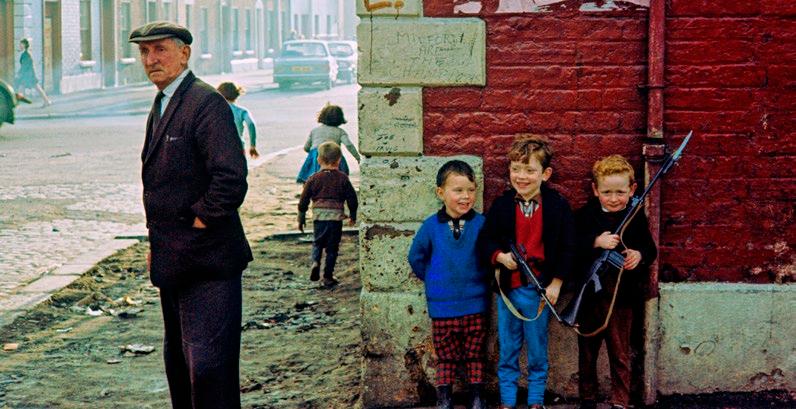

witness Belfast in "the best of times and the worst of times"—it really was a tale of two cities back then. There were armed troops in land-rovers on the streets, paramilitary gatherings, civilian searchers frisked shoppers entering Belfast City Centre, and countless shootings and bombings with over 3,600 fatalities. When there was trouble, public transport was sometimes closed which meant a problem getting home from school.
What I love about Belfast now is that it's a much more vibrant place, and wellknown for its friendly people, hospitality and "craic". It's a tourist destination with an army (much less military) of excellent tour guides. We're known for positive reasons such as making high-quality
dramas like Game of Thrones and Line of Duty as well as being the city that built and launched the Titanic. Belfast port is now the third most popular destination in the UK and Ireland for one-day cruise ship calls and in the past three years there has been an 82 per cent increase in the number of annual visits.
I began writing local history books about 17 years ago. I volunteered to write a brief history of when the Marie Curie organisation came to Belfast. The most common question asked was "What will be the subject of your next book?" I took the bait and published two more. But a series of examinations then revealed that I had an advanced brain tumour requiring immediate surgery. I suffered hearing loss and had to learn how to walk, eat and live again. I was unable to return to full-time work but have continued to write local history books. I am currently working on my 19th to raise funds for charity.
AUGUST 2020 • 67
Geoff A h ow A rd / Al A my Stock Photo
SUSIE MILLAR has lived in Belfast all her life. After working as a TV news reporter for over 20 years, she's now one of the city's tour guides. Visit titanictours-belfast.co.uk
I was in the thick of the Troubles as a reporter during the late 1980s, 90s and after the Good Friday Agreement. I can remember not being allowed to go into the city by myself or with friends until I was about 16. It was too dangerous. If you grow up with that, you think of it as entirely natural to have security checks before entering the city centre, to be searched going into shops and to have the army on the streets. I lived in a quiet suburb so I wasn’t directly affected every day but looking back on it now, I can see that my choices and economic outlook were limited by what was going on. Sometimes I’ll be walking through the city centre and remember being caught in a bomb scare as a child or what used to be there before it was blown up. I think it's important that the city hasn’t tried to
erase that part of our history because it’s part of what makes us who we are.
Belfast is unrecognisable from the city in which I grew up. When I was finishing college, we were just starting to have a nightlife again after the Troubles. Since then, we’ve moved into being a normal UK city but with a bit of an edge. We’ve re-embraced our industrial heritage and the stories that go along with it. The most visible change is the redevelopment of the old shipyard into the Titanic Quarter. It's an area which has really come to life. Where else can you walk in the footprints of where Titanic and so many other famous ships were built? I love walking from the top of the old slipways down the Maritime Mile and looking down Belfast Lough towards Carrickfergus. The area hosts maritime festivals a few times a year and is constantly expanding.
I think the Troubles have affected our attitude to life. We have a wry sense of humour in Belfast, which is probably borne out of coping with years of unrest. I think citizens of any city which has undergone trauma find a way of coping and ours definitely comes across in our humour. That’s not to say we’re ignoring the legacy of what happened, but for a visitor who is only here for a few days, it is the most likely way in which
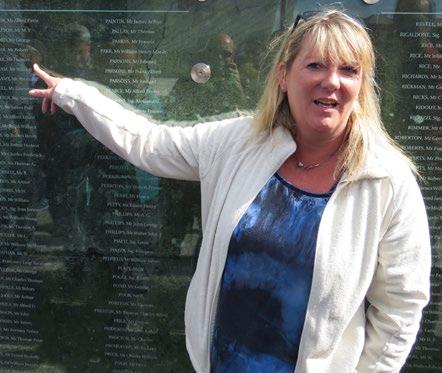
BEST OF BRITISH MY UNITED KINGDOM: BELFAST

they will encounter the influence of the Troubles. As a teenager, I had plans to move to Canada or Australia but I’m glad I stuck around, because I’m very proud of what Belfast has become and how we’ve moved away from the sectarian trouble.
I decided to become a tour guide as another way of utilising my storytelling skills after leaving journalism. I wanted to offer visitors a personal connection to the Titanic using the story of my great-grandfather, Thomas Millar. He was the assistant deck engineer on the Titanic and was sailing to New York with the hope of starting a new life for himself and his two sons after the death of their mother in early 1912. Luckily, he decided to leave his sons (my grandfather and his brother) behind, because he went down with the ship. Before he left, he gave each the boys two

new pennies and told them not to spend the coins until the family was reunited. Since they never were, the pennies were kept and are still in the family today.
There are so many things I love about Belfast. The people and their sense of humour, the position of the city surrounded by hills and water, the proximity to the Atlantic coast, the old streets around the Cathedral Quarter and the fine Victorian buildings which show to the world just how important we were at the turn of the 20th century. Most of all though, the genuine welcome we extend to visitors. We are so chuffed when people have made the effort to come and see the city for themselves.
AUGUST 2020 • 69
n Al A in l e G A r S meur " t he t rou B le S " Archive / Ser G i r e B oredo / Al A my
Children playing in streets affected by the Troubles, 1972. Rowan Gillespie's sculpture Titanica in front of the Titanic museum
In 2008, an acid attack by her ex-boyfriend left Katie Piper (36) with severe burns and blindness in one eye. She’s now an activist, presenter and model

If I Ruled The World Katie Piper
Schools would teach the importance of the family unit. I think a lot of society’s problems— in the justice system, in the education system—are because people start life within broken social backgrounds. I don’t think the importance of those units—whether a mother and father, two mothers or two fathers—is discussed enough, especially in terms of the stability it can give children.
Vinegar would be served with all food. I lost a lot of my taste buds when I got burned and now I put vinegar on every meal—Shepherd’s pie, spaghetti bolognese, my roast… And it never comes in big enough bottles! If I buy a lot of it then it comes in a sort of tankard, but I need it in a big dispenser. It would be so lovely to have it in a decanter.
You’d have to interact with strangers. When I visit villages I always notice that people say, “Good morning” when they walk past you. In London we
INSPIRE
don’t speak to people even if they step on our foot! More interaction, asking people how they are and acknowledging people would be great. It just puts you in a good mood if someone smiles at you.
Everyone would have their basic needs met. Essential human rights like hot water, heating and food would always be available to those who simply don’t have it. The distribution of wealth isn’t equal, and we can afford to change that.
Self/fake tan would be mandatory. One, because it’s feel-good, and would make you release endorphins. You feel good when you’re tanned and people always comment that you look well. But also, magically, it would lower the cases of skin cancer and sun stroke. People don’t realise how dangerous the sun is. It’s not necessary to sit in it with baby oil on when you can just have a good bottle of St Tropez!
Everyone would have to take regular exercise. When the options were taken away from people during lockdown, even those who had never exercised before wanted to do their hour-long walk outside. I think it’s so good for so many different reasons. It’s a natural anti-depressant— exercise is a great tool for mental health and loneliness because it provides structure. It would also improve our stats around obesity.
Not everybody wants to go to the gym but walking each day can really help lots of cardiovascular problems.
I’d like to see more kindness. During coronavirus we’ve all been more kind to people we’ve previously been dismissive of like key workers, Amazon drivers and Ocado delivery people. I’ve seen great stuff on social media where people are putting thank you notes on their wheelie bin. I’d ensure there was more appreciation of all the different pillars of our community.
When you move into a new area, you’d have to introduce yourself to your neighbours—you’d knock on the door and swap skill sets. You could say, “Look, you’re retired so would you mind taking my parcels in for me? And if you need me to help with your shopping or fixing your computer, let me know.” I think it would help to create more of a sense of community.
There would be better public hygiene. If everybody could just Dettol down their seats on public transport after using them that would be great. Let’s get that system going! n
As told to Anna Walker
Katie Piper’s Extraordinary People podcast is available to download now. For information on Katie’s burns charity, visit katiepiperfoundation.org.uk
AUGUST 2020 • 71
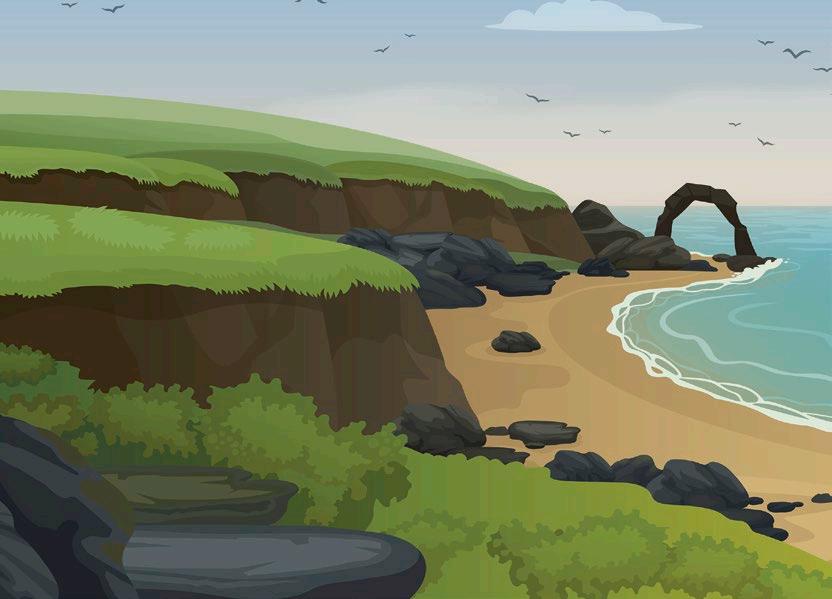
“May you live in interesting times”
For many years I believed that this was a Chinese proverb or if you like a curse, however I have been enlightened of my ignorance by “the mighty” Google who informs me that the quote originally appeared in “The Yorkshire Post” in 1936 from a speech made by Sir Austen Chamberlain, so there you are it must be true! He also reportedly said “We move from one crisis to another. We suffer one disturbance and shock after another”. He could well have coined that phrase today. We’ve had “Brexit” (ahhh sorry!), Trade Wars, disrupting global (err) trade and the dreaded Coronavirus. At the time of writing this article the United Kingdom and America are yet to reach peak infection rates and sadly deaths. Here’s hoping that by the time of publication the dreaded
disease is in retreat and we are returning to our “normal lives” whatever normal is for you!
Over the last months and years we have spent a great deal of time talking to people about how to invest and when to invest. The how (actually) is easier than you think, as to the when, that can sometimes be a little tricky! So let’s start there then;
When markets are rising should you invest? When they have fallen should you invest? The answer isn’t as clear cut as it may seem, “why?” I hear you ask. Because it isn’t that simple, life and especially investing never is. You may be buying into an overpriced market (when it’s going up... and down!). Equally you never know when the bottom is going to come, the old adage “trying to catch a falling knife” springs to
PARTNERSHIP PROMOTION


mind. Not very helpful so far? My advice to clients over the last 30+ years (yes I said it!) has been linked to an analogy that (so far) I’ve only heard me use. So here goes;
If you go to the seaside and the wind is blowing a gale, the waves are pounding the beach, skies are grey, it’s cold and raining you wouldn’t go in for a swim (well I wouldn’t!). If on the other hand the sun is cracking the pavement, the sea is calm and inviting you’d, I expect, be straight in. All I’m trying to illustrate here is that when things look very uncertain you wouldn’t “dip your toe in the water”. Let me be clear, we never try to time the markets as we firmly believe that it is “time in the market” that counts however you wouldn’t volunteer for scenario one at the beach so why would you jump in with your hard earned cash.
The how of investing is generally, for most people much easier. You should establish your investment goals; do you want income, growth or a combination of both. Think about your time horizon and the returns you need to achieve these goals. You must consider how much risk you are willing and able to take to achieve your objectives (you can use on-line risk profiling tools to help here).
Then invest in a balanced and well diversified investment portfolio that aligns to your risk profile. Once you are invested, if you find yourself in a “squall” and over the medium to longer term you certainly will find testing times (another Seaside analogy - I don’t even go to the beach - well not much anyway) you must stick to your strategy. Don’t be tempted to sell when markets fall unless you really, really need to (you should consider your short and medium term cash requirements before you invest). If you sell into a falling market you will crystallise your losses and find it very difficult to recover from them.
On a positive note, if you want to achieve better returns than your bank or building society, over the longer term a well balanced and diversified investment portfolio should do it every time. If you would like a FREE copy of our Beginners Guide to Investing please call 0800 043 8341 or send an email to letstalk@ fathomfinancial.co.uk n
Mark Abley
Managing Director at Fathom Financial.
Tel: 0800 043 8341
Email: letstalk@fathomfinancial.co.uk
xREUNITED BY SCIENCE
REUNITED BY SCIENCE
Millions of people have used commercial DNA tests to trace their family trees. For a few lucky folks, the results have been lifechanging, introducing them to relatives they had lost long ago—or never knew existed.
had lost long ago—or never knew existed
By Claire Nowak
74 • AUGUST 2020 INSPIRATION
Photograph by Bailey Rebecca Roberts
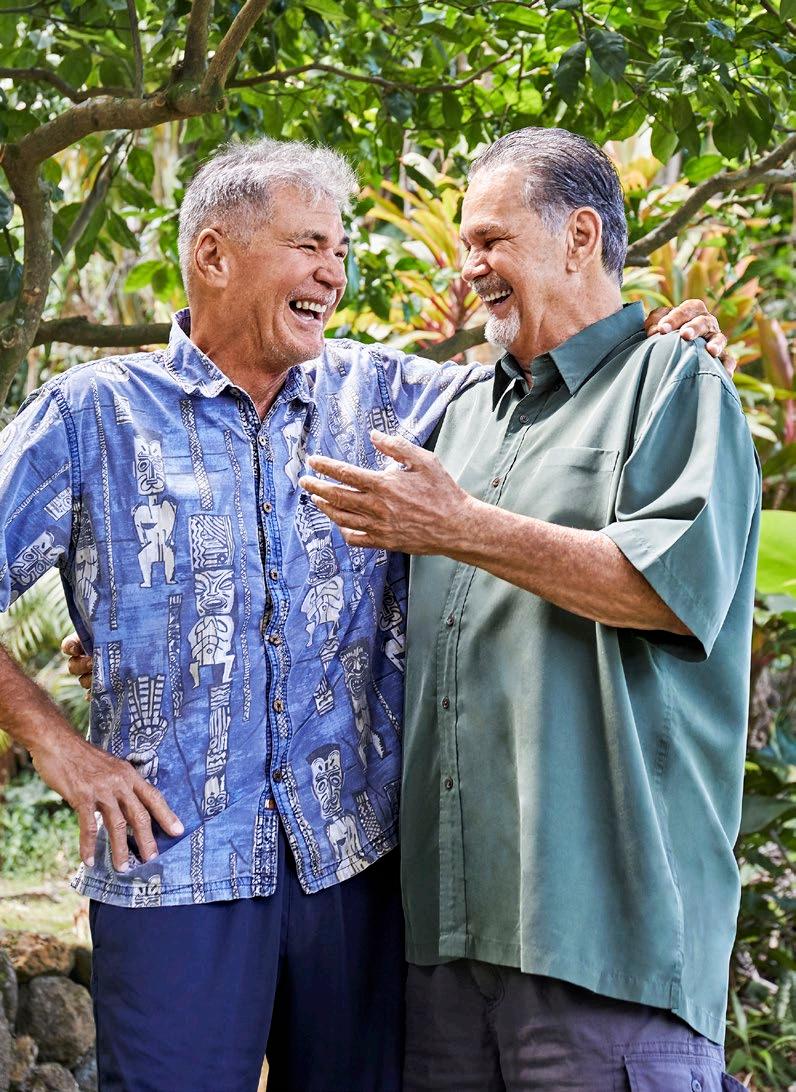
tests. The results showed they were related
Lifelong friends Alan Robinson (left) and Walter Macfarlane unknowingly took the same DNA
BOND OF BROTHERS
Walter Macfarlane, 76, and Alan Robinson, 74, have been friends for more than 60 years. They grew up a few miles away from each other in Honolulu, Hawaii, and met at school, where they played American football together. They are so close, they’re Uncle Walter and Uncle Alan to each other’s kids. So imagine their surprise when they discovered they were in fact biological brothers.
“It did feel natural,” Walter says of the revelation. “We knew each other so well.”
It came about, as so often happens, by accident. Walter, a retired maths and physical education teacher, knew that he had a complicated family tree. His mother had been young and unmarried when she gave birth to him during the Second World War, and because she couldn’t raise him on her own, the family pretended that his grandmother was his mother and his mother was his sister. Walter didn’t learn the truth until he graduated from high school. Even then, his mother never told him (or anyone else) who his father was.
So in 2016, when commercial DNA-testing kits were starting to take off, Walter’s daughter, Cindy Macfarlane-Flores, suggested he try a couple. When Cindy logged on to ancestry.com to check the results,
she saw that a user named Robby737 and her dad shared enough DNA to be half siblings. When Cindy asked her parents whether they knew anyone who could have that username, her mother immediately thought of Walter’s friend, Uncle Alan. His nickname was Robby, and he used to fly 737s for Aloha Airlines.
Could that really be possible? Walter wondered. He spent ten minutes trying to get his friend on the phone. When Alan finally answered, he confirmed to Walter that his username was Robby737.
“I’m trying to act cool,” Walter says. “But I’m so excited inside, I’m gonna burst out. I think I said, ‘Oh, I think we’re brothers,’ in just a casual manner. Then he said, ‘Yeah, sure. OK, Walter.’ ”
“I was in denial,” Alan says. “We’ve known each other for so long, I thought he was just joking around.”
But Alan knew it was possible. He had been adopted as a baby by Norma and Lawrence Robinson. Several years before, Alan had taken the same DNA tests that Walter did to learn more about his ethnicity and medical background. But he’d never talked to Walter about it.
Soon after the phone call, the men compared their test results on 23andme.com and found that they shared several identical X chromosomes, meaning they had the same mother.
“If I wasn’t in that database, this
76 • AUGUST 2020
REUNITED BY SCIENCE
Courtesy Cindy Ma C farlanef lores ( f ootball), Matthew Cohen (border)
discovery never would have happened,” Alan says. “It was meant to happen.”
However, one person apparently worked very hard to make sure that it never happened: their mother. Walter knew his mother’s name was Genevieve K Paikuli, but Alan’s birth certificate lists his mother as Geraldine K Parker. The identical initials in the name listed as Alan’s mother led the men to believe that Genevieve had used a pseudonym when she gave Alan up for adoption. Alan also believes that his adoptive parents, the Robinsons, knew Genevieve was his birth mother and didn’t tell him out of respect for her wishes.

they were actually related
Neither brother knows why no one ever told them they were related, but they attribute it to the era’s social norms and the turbulent times surrounding the attack on Pearl Harbor and the war, which was still being fought when they were born.
“We don’t know what transpired, but [we have] no bad feelings,” Walter says. “At that time, you had your own reasons why you did what you did.”
But they have gained much more than they lost. Thanks to their DNA test results and research by Cindy, they learned who their fathers were— both were military men from the mainland who had been stationed
in Hawaii. Those discoveries led to more: Walter found out that he has four more half brothers and has since traveled to California to meet them in person; Alan has two half sisters and a half brother.
“It’s mind-boggling,” Walter says.
Now that their family searches have come to a close, Walter and Alan just want to make up for lost time. They had fallen out of touch after high school, and although they eventually reconnected, they still didn’t see much of each other because they were busy raising their kids. “If we had known sooner we were brothers, we would have been contacting each other all the time,” Walter says. They are now. Both still live in Honolulu, about five miles apart, just like when they were kids. They talk on the phone weekly and
AUGUST 2020 • 77
Courtesy e lliot l oewenstern
go to lunch regularly. They’re even planning to take a cruise together.
“Our mother lived to be 92,” Walter says. “We have a few more years, hopefully. We have good genes.”
“THIS
IS MY DAUGHTER”
When she was 16, Joanne Loewenstern learned that she was adopted. Until that day, she’d believed that her adoptive parents were her birth parents. Instead, they told her that her birth mother was a woman named Lillian Feinsilver and that she had died days after giving birth to her at Bellevue Hospital in New York City. Feeling betrayed and confused, Joanne spent many nights crying, wondering what her birth mother had been like. And yet, some part of her believed her mother was still alive.
something about her biological family might give Joanne some peace. So Joanne took the test, and about a year later Shelley received a message on ancestry.com from a man named Sam Ciminieri, whose genetic report had matched him with Joanne.
Shelley immediately wrote back to Sam, asking whether he knew a Lillian Feinsilver. Yes, Sam said, that was his mother’s name. Almost unbelievably, she was alive, at age 100—Joanne had been right all along.
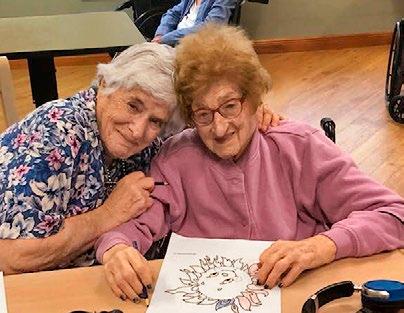
The doubts nagged Joanne for years. After watching this emotional turmoil, Shelley Loewenstern, Joanne’s daughterin-law, suggested taking a DNA test. That was in 2017, and Joanne was already 79 years old. Even if her mother had passed years before, Shelley reasoned, learning
But there were more shocks to come. Sam said that Lillian lived in an assisted-living facility in Port St Lucie, Florida. Joanne lived in Boca Raton, less than 80 miles away.
“As it turns out,” Joanne’s son, Elliot Loewenstern, told the Washington Post, “we have a whole other family
78 • AUGUST 2020 REUNITED BY SCIENCE
Courtesy Jay s peights (left). s arah l . Voisin/ w ashington p ost/ g etty iM ages (right)
Joanne (left), 80, and her birth mother, Lillian, 101, enjoy colouring together when Joanne visits
we never would have discovered.”
The families quickly planned a reunion at the facility where Lillian lived. A month later, Joanne found herself sitting across from the mother she had searched for her whole life. Elliot, Sam, Shelley, and one of Joanne’s grandsons looked on. Lillian, who suffers from dementia and uses a wheelchair, was silent.
“I don’t know if she recognises me,” Joanne said.
She told Lillian that she had been adopted in 1938 and that she’d been told her birth mother had passed away. No response. Joanne started to cry. At that point her mother perked up, as if she had started to understand. Joanne excitedly began telling Lillian all about her children and grandchildren. Lillian smiled. Then she said the words Joanne had waited more than 60 years to hear: “This is my daughter.”
The Loewensterns learned that over the years, Lillian had repeatedly told her family that she “lost her daughter.” Everyone, including Lillian, assumed that the baby had died. Joanne’s family speculates that because Lillian was unmarried when she gave birth, the baby was taken away and put up for adoption.
But now that the two women had been unexpectedly reunited, none of that mattered so much anymore. They spent time that first afternoon together colouring with coloured pencils, which just happens to be a
favourite hobby for both of them.
When Joanne visited again three days later, Lillian remembered quickly who she was. Now they see each other every few weeks to colour, play games, and enjoy the time they have together. “I’m proud,” Joanne told WPTV. “This is something I wanted to do all my life.”
A ROYAL REVELATION
As a descendant of enslaved people, Jay Speights had struggled to find written documentation of his family history. He spent years looking, as his father had before him, but he was 64 before a DNA test offered a solid lead. The pastor from Rockville, Maryland, learned that 30 per cent of his DNA was from Benin, a country located to the west of Nigeria about which Jay knew next to nothing.
At the urging of a friend, he turned to a database called GED Match, which has had success connecting African Americans and their African relatives, to learn more about his link to Benin. After uploading his data to the site, Jay saw a surprising DNA match. The website listed a man named Houanlokonon Deka as his distant cousin. Next to the listing were the words royal DNA. Beninese royalty? Jay was stunned. He had no idea what to do next. But fate—or maybe even divine intervention— kicked in a few months after Jay
AUGUST 2020 • 79
READER’S DIGEST

After arriving at the royal palace of Allada, Jay was given traditional Beninese attire
learned of his royal lineage. At the New Seminary in New York he met the leader of the West African religion Vodun, who had travelled from his home—in Benin. Jay told the man and his group his unusual story, and one of the Beninese men immediately replied, “I know your king. Here is his number.”
“I mean, how could that possibly happen?” Jay wonders. “After all these years of going through my father’s search, going through files… it just fell in my lap. That’s the hand of God.”
The first time Jay called King Kpodegbe Toyi Djigla, the traditional ruler of the kingdom of Allada in southern Benin, the king hung up. The second time, the king handed the phone to his English-speaking wife, Queen Djehami Kpodegbe Kwin-Epo. She and Jay started
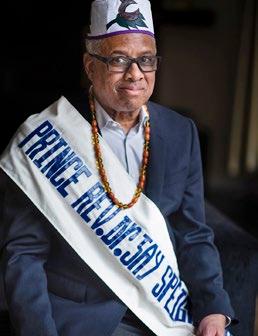
messaging each other online. She told him he was a descendant of King Deka, who had ruled Allada centuries earlier. “We would be delighted to welcome you to your home, dear prince,” she wrote.
And so Jay went. On January 6, 2019, his late father’s birthday, he landed in Benin. Posters written in French, the country’s official language, greeted him: “Welcome to the kingdom of Allada, land of your ancestors.” At least 300 people were waiting for him outside the airport. They danced, sang, and played instruments to celebrate the return of their long-lost prince.
Accompanied by a motorcade, the queen picked him up from the airport, introduced him to local dignitaries, and showed him some historical sites. When they arrived at the palace for an audience with
80 • AUGUST 2020 REUNITED BY SCIENCE
Martha a sen C io r hine/ t a M pa b ay t i M es/Zu M a p ress
the king, at least 1,000 people were waiting for them. Jay was overwhelmed with emotion.
“I started looking at faces and features. I’m looking for the physical connection to our DNA. Just taking it in,” he says. “You’re kind of almost dazed because you find yourself in a situation that most African Americans really believe you can never step into, that can never happen, and that’s to find the part of your DNA that comes from Africa.”
Once Jay composed himself and got out of the car, people cheered and chanted his name. He smiled and waved while walking through the crowd. When he and his interpreter reached the palace, he received a quick lesson in royal etiquette—what he should do when the king entered and how he should address Beninese royalty. In the throne room, the king welcomed Jay home, and they spoke about his trip through their interpreters.
Later that night, Jay participated in a ritual that was to show whether his ancestors would accept him into the family (luckily, they did).
How Jay’s royal ancestors came to the US from Africa remains a mystery. Benin was once home to one of West Africa’s biggest slave ports. African royalty would sell war captives into slavery, and some would allow royal family members to travel with European merchants
to the New World, where they would usually end up being enslaved.
Jay’s Beninese relatives told him the royal family of Allada would not have sold their own people into slavery, but they couldn’t tell him how his ancestors had ended up on a slave ship. He is still grappling with being a descendant of enslaved people and those who led others into slavery, but that knowledge doesn’t keep him from embracing his Beninese heritage.
“I’ve stepped into my identity,” he says. “I can point to a place on the map and say, ‘The Speights family comes from here, right here.’ We’re a royal family. We have a history.”
In fact, Jay has continued to deepen his connection to his newfound homeland.
When they met, the king also gave Jay some “princely duties”. once he got back to his home in Maryland, he was to look for ways to bring clean water to the village surrounding the palace in Allada and to promote the kingdom in the US. Now Jay is partnering with the Rotary Club of Alexandria West in Alexandria, Virginia, to raise money to build wells in the village.
He also searches for others who have DNA from Allada (primarily through GED Match) and introduces them to their ancestral home. After all, not everyone can be lucky enough to be handed the king’s phone number. n
READER’S DIGEST AUGUST 2020 • 81

SEPARATED BY RELIGION
Balkan wars are still fought in Bosnia, only now in the school system
By Eleanor Rose
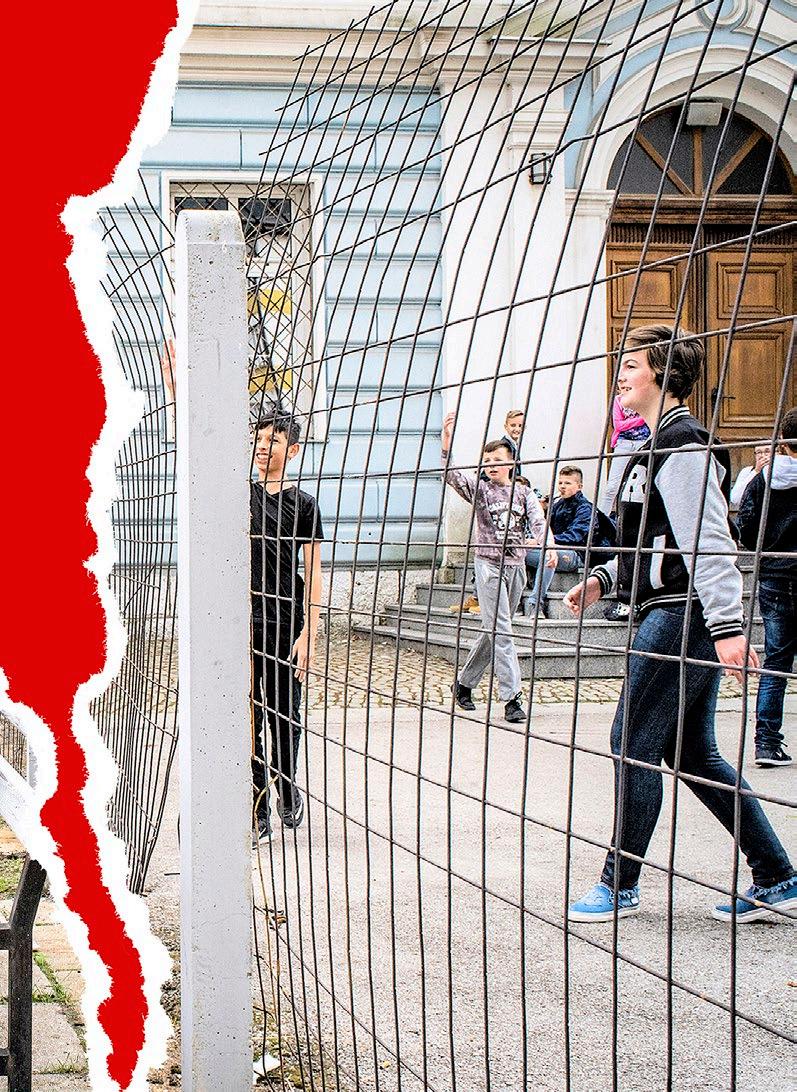
In the school in Travnik children from Croatian Catholic families attend class in the right side of the building, while students on the left are predominantly Muslim
Awire fence divides a schoolyard in Travnik, in central Bosnia and Herzegovina. To the right is a clean blue facade, marked with pillars and a set of carved wooden doors. The brown wall to the left of the fence is pockmarked with shell holes from the 1990s war and splattered with graffiti.
This is where Elisabeth Hrgic´ and Inas Dagoja, both 25, went to school—Elisabeth to the wellmaintained right of the fence, Inas to the crumbling left. She is a Bosnian Croat and a Catholic, he a Bosnian Muslim (Bosniak). They never met while they studied here; the school bells rang different break times on either side, and they used separate entrances. It wasn’t until they were 20, in 2014, that they met in a local night club and fell in love.
They took a photo here on their wedding day in June 2019, separated by the fence—Elisabeth in a white dress, pressing her hands against Inas through the gaps between the wires. She posted it on Facebook alongside a caption urging friends to “teach your children that they are all the same”. It went viral. Thousands of Bosnians shared it, and newspapers across the Balkans printed it.
“The fence was a mental border— they didn’t tell us, ‘don’t go over
there’, but in our heads we didn’t want to,” Elisabeth tells Reader’s Digest in the schoolyard a few days after the wedding.
Elisabeth’s school, the private Catholic School Centre Petar Barbaric´ is attended by Croats. Although in theory anyone can attend Inas’s school, the public Mixed Secondary School Travnik, in practice its pupils are mostly Bosniaks. Officials say the fence in this schoolyard was built for security, but for many Bosnians it is a symbol of widespread segregation in education, not only in Travnik but across the country.
The nationwide debate sparked by the now-famous photo had less to do with the fence in Travnik, which separates a public school and a private school, than it does with a whole larger issue of a systematised segregation across government-run schools elsewhere in Bosnia and Herzegovina.
Bosnia has three main ethnoreligious groups—Croats (mostly Catholics), Bosniaks (Muslims) and Serbs (Orthodox). They were pitted against each other in the 1992-95 conflict in which 100,000 people were killed. Linguists consider the language spoken by the three groups largely similar, with some small differences. But after the war, the Dayton Accords—still the country’s de facto constitution—only briefly mentioned education and the issue
84 • AUGUST 2020
SEPARATED BY RELIGION
was largely left to the ministries of education in the country’s ten cantons.
A system called “Two schools under one roof” was installed in some ethnically mixed parts of Bosnia, segregating schools as a short-term measure, with the help of the Organisation for Security and Cooperation in Europe (OSCE)—an international governmental body that helped restore peace in the country.


More than 20 years later, some of those schools have unified, but 56 are still running across 28 sites. Experts say they block ongoing reconciliation and are breeding grounds for the ethnic divisions that could threaten the peace. In 2001 the Organisation for Economic Cooperation and Development deemed the schools a “hostage to [the] latent nationalism” touted by Bosnia’s most powerful political parties, and in 2018 the OSCE publicly renewed its calls for leaders to “end the discriminatory and damaging practice… to ensure a stable and prosperous future.”
The type of partition varies. In some schools, pupils use different entrances and physical spaces within a building. In others, facilities are shared according to a timetable. Disagreements over time slots
fuel feuds between families. At one school in Vitez, ten miles from Travnik, Croat and Muslim pupils shared an IT lab until a dispute broke out over equipment maintenance. It was solved when a second lab was built and the students were completely separated.
The “us and them” mentality perpetuated by segregated schooling has a profound impact on children. Aleksandra Krstovic, National Programme Officer, Education, with the OSCE Mission to Bosnia and Herzegovina (BiH), explains: “Several studies have shown that the social distance, prejudice and stereotypes between the young people in BiH are significant, and that the level of trust, acceptance and understanding of ‘the other’ is very low.” An OSCE 2018 report says that children learn from segregation that “the differences
AUGUST 2020 • 85
Elisabeth Hrgic ´ went to school on the wellmaintained right of the fence, and Inas Dagoja to the crumbling left
between them are irreconcilable.”
Locals say divisions are most visible in taboos around inter-ethnic love. Elisabeth and Inas tread a difficult path; one Bosniak friend sparked a row at their wedding, complaining about a Croat song. And, when the couple’s photograph went viral, they began to receive online abuse. “Your parents didn’t teach you right,” said one message on Facebook; others are too unpleasant to print. The pair know other mixed couples who’ve split because of the intolerance they faced.
The atmosphere is driving young people to emigrate, says Elma Salihagi, projects coordinator at an educational nongovernmental organisations in the central Bosnian town of Jajce, where several schools are split.
everything should be divided in three— Bosniak, Croat, Serb. It’s absurd,” she adds.
Politicians and local authorities have shown little interest in tackling segregation, even where divisions are stark. In Stolac and C ˇ apljina, two towns in the southwestern municipality of Mostar, segregated primary schools simply ignored a 2014 Supreme Court ruling on a case brought by crusading legal aid group Vaša Prava to merge.
"ONE BOSNIAK FRIEND SPARKED A ROW AT THE WEDDING, COMPLAINING ABOUT A CROAT SONG"

Bosnia’s population has dwindled from 4.3 million in 1991, shortly before the war, to 3.3 million today. In 2018, 4,474 people gave up Bosnian citizenship, 1,385 of them 18 to 25 years old, according to officials quoted in media. “People say it’s about unemployment, but it’s not,” Salihagi says, alluding to high joblessness statistics. “It’s this system making people go—the mentality that
Meanwhile, in Mostar city itself, dubbed Bosnia’s most divided, Croats and Bosniaks lead separate lives on either side of the River Neretva, which marked a frontline during the war. Most schools on the western side of the river cater only to Croats, and on the eastern side to Bosniaks.
That’s why pro-unity campaigners were keen to integrate pupils in a rare Mostar facility where Bosniak and Croat children were both present—the Mostar Gymnasium, a grand Austro-Hungarian school opened in 1902. It stands on the west bank of the river, at the crossroads between the two communities, and
86 • AUGUST 2020 SEPARATED BY RELIGION

before the war it had a multiethnic intake. Afterward, however, it began operating as “two schools under one roof,” segregating 650 pupils.
NGOs and the OSCE saw the potential for a pioneering project that would bring Mostar’s young people together. After intense lobbying by the international community and the promise of donor funds for refurbishment, the Bosniak and Croat schools legally joined in 2004. In 2009, the parents’ councils unified, too.
But with scant support from local politicians, the experiment never quite took off. Today the only class Croats and Bosniaks take together is IT; and in 2014, the parents’ council decided to split in two once again. Croat and Bosniak students can interact during 15-minute breaks as they dash to the shop for a snack, but many don’t. Fifteen-year-old Ajla*,
explains from the school gate: “we see each other in the hallways. We have acquaintances, not friends.” To her, it’s a missed opportunity for her to truly get to know more Croats.
In the absence of political will, it’s been left to young people to find connections with each other. But it’s not easy when the sense of difference is strong. Faris C ˇ ovic´, 19, arrived at a recent festival on the west side of Mostar to hear shouts from Croat football hooligans, calling him a “motherf***** from the east.” Impressively, it hasn’t put him off.
As vice-president of the city’s student council, Faris was in a meeting last year when a coordinator mentioned plans by politicians to name a new bridge over the river after a Croat army official. “You just knew that name would contribute to division and conflict,” he explains.
AUGUST 2020 • 87
Students from the Bosniak side attending a class in the school in Travnik
t i
S /
U x
photo: © LAURA B o US h NAK/ t
he New Yo RK
me
R ed
So the teenagers on the student council discussed it. “Why not call it the ‘Student’s Bridge’?” they asked.
They drafted a letter and joined forces with other youth groups. Some 20,000 students signed a petition—and the city yielded. Today, the Student’s Bridge joins Mostar’s Croat university on the west bank to the Bosniak university to the east.
It’s a small victory in a city mired in complex problems. But other stories, too, show how young people drive change where officialdom has failed. Seventeen-year-old student Nikolas Rimac was in class in May 2016 at his mixed secondary vocational school in Jajce when his history teacher broke the news that Bosniaks and Croats from his and another secondary, called Nikola Šop, would soon be split. Although Nikolas had always attended mixed schools, he’d once visited a local segregated school where he saw pupils forced to use different toilets and hated the idea.
He gathered Croat and Bosniak classmates from the two secondary schools. First they demanded meetings, but school authorities brushed them off. Then they wrote letters to the regional government, which also ignored them. Finally they began mounting street protests, carrying placards with slogans such

as “Segregation is a bad investment” and “We are here to create the future not repeat the past.”
Local media and international diplomats lent support, but there was also a backlash. The principal of Nikola Šop banned students from joining the protests. One girl’s mother even lost her local government job after speaking on television about the issue, sending a ripple of fear among families. Many kids dropped out.
Then, in summer 2017, Nikolas had an idea. Teachers and students should simply down tools and walk out of classes. “You’ve nothing more to lose,” he told teachers.
On the day of the planned strike, the weather was warm. Nikolas watched as the vast majority of the school’s teachers and pupils
88 • AUGUST 2020 SEPARATED BY RELIGION
photo : © e LV i S BARUKC i C/AF p V i A Gett Y i m AG e S
Nikolas Rimac led Croat and Bosniak classmates in street protests against the planned segregation of his school in Jajce
streamed out into the yard. Local media came to watch them all relaxing outside, sharing their food. “See? We’re enjoying ourselves together,” Nikolas told reporters.
One morning a few days later, Nikolas woke to a ping in his email inbox. A local journalist had sent him a news story saying the regional government was dropping its school segregation plans. His heart swelled. “It felt like we’d banished everything bad in the world in a snap,” says Nikolas. “Bosnia is a place where everybody wants change, but nobody is willing to. So we were the change.”
More than 100 students took to the streets for one more protest, this time demanding the unification of segregated schools across the country. They wore masks so the students from Nikola Šop couldn’t be singled out. “It’s not the end,” says Nikolas, now 20 and attending university in Sarajevo.
He hopes the students and teachers will use the networks they formed during the Jajce battle to continue their campaign. In November 2018, the OSCE awarded the protestors its Max van der Stoel Award for improving the lot of national minorities.
It will be a long struggle. Because of Bosnia’s decentralised power-sharing government and complex legal system, there is no single catch-all
approach to end “two schools under one roof” or other forms of discrimination in schools, according to the OSCE’s Krstovic.
“The agreement reached, after student’s protests in Jajce, is specific, and each of these cases has to be addressed individually,” she adds.
While the OSCE works at a higher level to convince Bosnian leaders to find a solution, pressure from citizens themselves is the only strategy yielding shorter-term results.
Back in Travnik, kids on rollerblades and scooters mingle on a warm Friday evening on the town’s main bustling thoroughfare.
Girls gossip as they glide, weaving between families. Boys play on slides in a playground nearby. They are from both Croat and Bosniak families, Elisabeth Hrgic´ says, but from how they look and talk, you wouldn’t be able to tell.
Neither Elisabeth nor Inas know that a few days after they show the Reader’s Digest issue around their hometown, a yellow JCB bulldozer will arrive in their old schoolyard to tear down the fence that once kept them apart. Although the school director denies it, the Bosnians conclude it’s because of the viral photo.
Catholic school officials plan to replace the fence, but instead of bisecting the playground, the new barrier will surround the whole property—both schools together. n
READER’S DIGEST AUGUST 2020 • 89

In The Footsteps Of Giants
By Sarah Kante
TRAVEL & ADVENTURE

The rugged coast of Northern Ireland is the stuff of legends.
Sarah Kante takes on the surf and the stories to discover the North Antrim Coast
The Giant's Causeway at sunset
Game of Thrones’ fans know it as the Iron Isles. The tourists who flock to the North Antrim Coast, located between Portrush and Ballycastle in Northern Ireland, come for its rugged and breathtaking beauty. On this stretch of coast, myths and history live side by side, and running out of things to do is near impossible: Giant’s Causeway, Carrick-a-Rede, Old Bushmills Distillery, the Iron Isles’ filming locations...
However, when I make my way to the north of the country in October, none of the aforementioned attractions are on my mind. What pushes me to leave Belfast behind and take two buses to the coastal town of Portrush are the waves. Located on a peninsula, Portrush boasts three Blue Flag beaches (West Strand, East Strand and Whiterocks Beach) and all the usual points of interest of a coastal town. You’ll find the largest amusement park in Northern Ireland (Barry’s Amusements), a harbour, Ramore Head and its cliff edges and trails, and the world-famous Dunluce Links Royal Portrush Championship Golf Course.
But what makes the North Antrim Coast so special is the promise of the consistent swells hitting its shores. Its uncrowded waves attract some international attention but remain relatively under the radar. A surfer’s paradise. This is the home of sixtime Irish national surfing champion Andrew Hill, after all.
I meet Andrew at his shop, Troggs, which was opened in 1984 and is the number one stop for all things watersport in Portrush. We talk surf, of course, but also travel, comparing notes on our favourite spots around the world.
ON THIS STRETCH OF COAST, MYTHS AND HISTORY LIVE SIDE BY SIDE
Staying at Portrush Townhouse Boutique Hostel—a five star hostel which is also part of the Troggs family—I cross the street and get a board from the shop. Jumping in the water at West Strand, I quickly realise that my trusted wet suit is not enough. Within just 30 minutes, I’ve lost all feeling in my feet and hands, and my ears are burning. I retreat to the Townhouse and gulp down steaming tea, before popping by the shop again. Booties are what I need, we decide. I leave with a new determination to master the icy Atlantic waves and an invitation to surf a different spot with Andrew and his friend that afternoon. I will probably always
92 • AUGUST 2020
IN THE FOOTSTEPS OF GIANTS
Whiterocks Beach
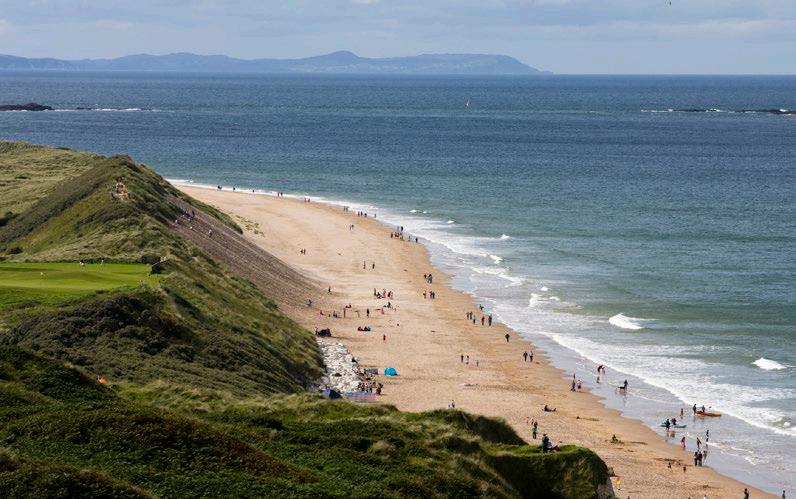
regret declining the incredibly generous offer, a chance to go out with surfers whose experiences and abilities far exceed my own, but on that particular day my head is set on one thing only: taking my revenge on the waves that turned me into a popsicle that very morning.
Even with boots, surfing the cold waters of Portrush leaves my feet purple. I become covered in bruises that don't register until I thaw out each night, and it takes a couple of days to fully regain feeling in my hands. But it's worth it, and I would gladly do it all over again.
While surfing is what attracted me to the North Antrim Coast, I'm soon led away from the ocean. Visiting without
a car offers the opportunity to walk a good chunk of the coast, slowly discovering the beauty of the place— my feet and the local bus timetable my only guides.
Leaving the uncrowded Portrush behind, I bus to Giant’s Causeway, a Unesco World Heritage Site and where most visitors congregate when in this part of the world—for good reason. It's breathtakingly beautiful, and free. I spend a couple of hours channelling my inner photographer, hiking the Shepherd’s Steps to the cliff top trail, watching the waves crash onto the basalt columns created by a volcanic eruption almost 60 million years ago and staring in awe at the power and beauty of nature.
It's a mind-boggling experiment to imagine the sheer power of a volcano
AUGUST 2020 • 93
that could create such a masterpiece, one of almost perfect mathematical precision. So unfathomable is the scientific creation of this chessboard of basalt, that's it feels almost truer to look to the myth to understand its origins.
The giant Finn McCool created the causeway to travel across the water to Scotland, where giant Benandonner is threatening Ireland. “Bad idea— Benandonner is terrifyingly massive. Finn beats a hasty retreat, followed by the giant, only to be saved by our hero’s quick-thinking wife who disguised him as a baby. The angry Scot saw the baby and decided that if the child was that big, the daddy must be really huge,” explains the Tourism Ireland website.
Another explanation, according to a tourist I meet, is even simpler: this “tourist attraction” was created by some Irishmen to drum up visits from all over the world. No amount of science could deter her: this was Ireland’s answer to Disneyland.
To escape the crowds—as well as the unusual theories—and with the weather holding up, I decide to follow the Giants Causeway and Bushmills Railway tracks to Portballintrae, crossing the Bush river and taking in the scenic views of the North Atlantic Ocean. Following the coast, I come upon Dunluce Castle, the old seat of the Earls of Antrim, built in the 16th century. The castle kitchens—along with its staff—fell into the sea in 1639,
prompting the 2nd Earl of Antrim to abandon the place.
With the sky starting to cloud over, I make my way to the Magheracross viewpoint to photograph the sweeping vista before sheltering from the rain now lashing the coast. After the rain I walk back to Portrush along the beach, watching the surfers manoeuvring the icy waves under double rainbows.
Another day and another bus take me to Carrick-a-Rede Rope Bridge, where visitors muster courage before treading the narrow planks-and-wires bridge over the 65-foot-wide chasm between the coast and a tiny island. It's a modern version of the bridge that the local fishermen hung for 200 years in this very spot. I forgo the dizzying bridge and walk along the coast, watching the families cross, their shrieks of laughter and fear mingling with the wind.
I follow the Coastal Way to Ballintoy Harbour, finding myself squarely in Iron Isles territory. This is where part of Game of Thrones seasons two and six were filmed. Away from the Harbour and the tourists on a Game of Thrones bus tour, I make my way across muddy fields crisscrossed by rivulets and overrun by rabbits. The ruggedness of the coast that translated so well on the small screen is exhilarating in reality: waves crash on rocks strewn
94 • AUGUST 2020
IN THE FOOTSTEPS OF GIANTS

 Giant’s Causeway
Dunluce Castle
Giant’s Causeway
Dunluce Castle

 Carrick-a-Rede Rope Bridge
Ballintoy Harbour
Carrick-a-Rede Rope Bridge
Ballintoy Harbour
all along the coast, seabirds whirl overhead and the wind has a mind of its own. Alone but for the elements, I attempt to continue on to White Park beach, known for its wild surf and beautiful sands. However, the tide is against me and a cliff stands in my way. There are no ways around, even as I glimpse bits of the beach I am trying to get to in between the waves that stand in my path.
With waterlogged feet and muddy jeans, I turn around and go back up to Ballintoy, stopping to photograph the Ballintoy Church of Ireland, its cemetery highlighted against the stormy skies. If not winter, at least rain is coming. I wait for the bus to take me back to Portrush and jump in, forgetting that contactless is not an option on the local public transportation. Thankfully, the driver takes pity on me and lets me ride to Bushmill, where I run to the supermarket and through to the ATM at the back before re-joining my bus and the driver, who has generously waited for me to get cash out. The rain has finally come, lashing at the windows as we drive back to town.
The North Antrim Coast feels as far away from the modern history of Northern Ireland as possible: this is a land of legends, of castles falling into the sea. It's a land of giants, fantasy and wild seas. International surfers and friendly bus drivers. But, as I discover on my last night in Portrush, this is still a land tainted by the Troubles. Religious contention played out on school grounds and bombs under cars did not forget these shores. A local who recounts his school days in vivid detail is prompted by my misunderstanding of the rules of Gaelic football:
“Catholic game that,” he tells me. And yet, he is quick to add, he’s not religious. I hover between pushing the issue or retreating, settling on finishing my drink and letting it go.
The next day, I walk through town to the bus that will take me to Coleraine and on to Derry. A few surfers are out, but Portrush is otherwise a ghost town. It's Sunday. The streets are empty, but the waves pound on, oblivious to the history they hold within their swell. n
As the crow flies…
Start-up company Crowded Cities from the Netherlands, fed up with the constant litter on their streets, have successfully trained wild crows to pick up cigarette butts and place them in the bin in exchange for peanuts. The company are currently looking to fund trial runs to make their dream of crow litter patrols a reality for cities of the future.
SOURCE: MENTAL FLOSS
READER’S DIGEST AUGUST 2020 • 97
My Great Escape:
Happy Campers
Our reader Sharon Haston is pleasantly surprised by a comfy caravan holiday
Ismiled but my heart sank when my husband suggested a caravan holiday in North Berwick to celebrate our anniversary.
My childhood holiday memories of caravans aren’t fantastic. Cramped spaces, a walk to the freezing shower and toilet block with a towel tucked under my arm, rain sounding like tubs of nails being thrown at the tinny roof…
Imagine my astonishment then, as I tentatively climbed the caravan steps and walked into a mini palace. Open plan kitchen, with plenty of space— not that I planned to do any cooking.
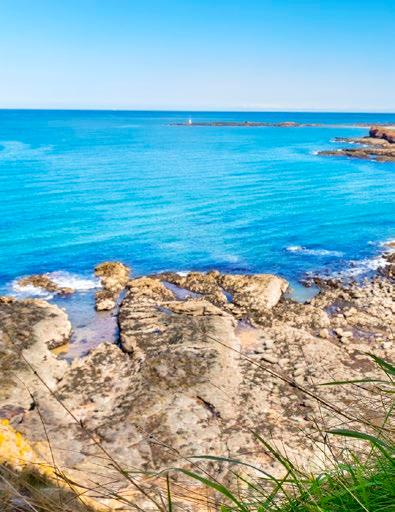

A plush lounge with living flame fire, two bedrooms, an en-suite, another toilet, plenty of wardrobe space, and even central heating.
I know, I know! Those of you who go caravanning regularly are rolling your eyes and saying, “Where have you been?”, but it was a revelation.
We arrived on a sunny day, so
TRAVEL & ADVENTURE 98 • AUGUST 2020


strolled along the coast to feast on fish and chips and ice cream. Back in our caravan, we sat on the comfortable sofas and drank champagne.
The next day, we explored North Berwick’s picturesque traditional town, with its gorgeous sandy beaches, looking out towards the Bass Rock. Being a bit of a history buff, I persuaded my husband to visit the nearby Tantallon Castle. It’s a ruin, but the views are spectacular. It doesn’t take too much imagination to bring its troubled past to life. It must have been freezing living there in the winter months, behind the thick stone walls, with the wind and waves whipping against the rocks.
That night we enjoyed lobster in a restaurant converted from the old coastguard station, before, alas, the rain began. So yes, we did still have the experience of those nails being flung against the caravan roof as the rain pelted down. But I pulled the comfy duvet over my head, happy in the knowledge that I could pay a visit to my warm en-suite anytime. No trek to the toilet block required.
Caravans have definitely changed in the last 40 years. I loved our stay as it took me back to being a child again, but this time with home comforts. It certainly won’t be another 40 years before I’m back… n
Tell us about your favourite holiday (send a photo too) and if we print it we’ll pay £50. Email excerpts@readersdigest.co.uk
AUGUST 2020 • 99

Bonnington Square, London
An enchanting corner of London brought about and maintained through the power of community
Vauxhall is most famous for its bus station, handy train connections, gay clubs and a whopping great roundabout. In short, the riverside district mostly isn’t London’s most beautiful—and yet there is one dazzling exception.
Initially constructed for railway workers and badly bombed during the Second World War, Bonnington Square earned renown in the Eighties when its set-for-demolishment housing became squatted. Resolutely progressive, these residents established a garden, a vegetarian cafe, a wholefoods shop, a bar and a nightclub.
Those squatters later morphed into a housing co-operative, one which now leases the terraced, brown-brick buildings and has developed that greenery into a terrific little “Pleasure Garden” that’s open all week.
Partly developed by Channel 4
gardener Dan Pearson and fairy-lit after dark, it contains subtropical plants around a huge hand sculpture and an Industrial Revolution waterwheel once used to cut marble. The association behind that also oversee a “Paradise Project” which sees the surrounding square’s houses and walls festooned in vines, topiary, palm trees and cherry blossom. It’s hopelessly exotic and, somehow, pin-drop quiet.
The wholefoods shop has been replaced by Italo (italodeli.co.uk, Wed-Sat only), a nice deli-cafe, while the original, still-volunteer-run veggie (and now also vegan) cafe remains a few metres away on Vauxhall Grove. Prices for the home-cooked lunches and candlelit dinners are still determinedly low, and a boho atmosphere endures. Remember that it’s cash-only and BYOB (bonningtoncafe.co.uk). n
100 • AUGUST 2020 Geoffrey Taun T on / a lamy S T ock Pho T o
GEMS HIDDEN
READER OFFER
15% OFF HEALTH SUPPLEMENTS FOR ALL OUR READERS
SUPPORTING THE 50+
GET MORE GREENS IN YOUR DIET
If you need an easy and convenient way to get more greens in your diet, why not try Prime Fifty’s new e ervescent super greens tablet which is the first of it’s kind available in the UK. It’s received great reviews for its well-researched ingredients list, ease of use and superior taste – with a melon and lime flavour which makes it an altogether tasty and refreshing drink that you can take daily. £23.00 for a 1-month supply.


SKIN, HAIR & NAILS SUPPLEMENT
TAILORED TO THE 50+

RECEIVE 15% OFF YOUR FIRST ORDER
USING CODE DIGEST15









Designed to nourish and protect your skin, hair & nails from within - these “Beauty from Inner Health” supplements have been exclusively formulated by Prime Fifty to meet the unique needs of the over 50s. Created to supplement your diet using an age-specific multi-nutrient formulation, comprising the most essential vitamins, minerals and natural extracts to help you feel good in the skin you’re in. £65.00 for a 3-month supply.





YOUR ORDER TODAY. VISIT PRIMEFIFTY.CO.UK/RD OR CALL 07383 443625
PLACE

Has Coronavirus Left You With More Or Less Money?
Though lockdown and social distancing brought us all together (despite being forced apart), the COVID-19 pandemic has impacted us all differently, and nowhere more so than when it comes to our finances.
Many who couldn’t work will have lost income. The government’s furlough scheme limited the losses to just 20% of earnings for around a quarter of the workforce—but the drop will still have been felt by millions with 25% of the workforce on the scheme.

Andy Webb is a personal finance journalist and runs the award-winning money blog, Be Clever With Your Cash
102 • AUGUST 2020
MONEY
And others, especially freelancers, limited company directors and the recently self-employed, fell through the gaps provided by the government. Many were left unable to work and unable to earn. The only option was to claim benefits, and record numbers have applied for Universal Credit since March.
Yet there were also a lot of people who continued working as before, albeit from the kitchen table. This meant no change to the money coming in. But while they earned the same, their spending was down thanks to the limitations on where they could actually spend their money.
Whichever applies to you, I’ve got some ideas of ways to make sure you get you and your money in the best possible place for whatever comes next.
If you’ve got less money
should find out exactly what their contract says. It could be that you’ll get a bigger payout than the legal minimums—it’s good to know so you can prepare.
If you do lose your job or things don’t go back to normal (some sectors are going to struggle much more than others), then apply for Universal Credit and other benefits. There are websites such as Entitled. to and Turn2Us.org. uk which will help you find out what support is out there for you.
YOU’LL NO DOUBT HAVE ALREADY LOOKED AT PAYMENT HOLIDAYS FOR THINGS LIKE YOUR MORTGAGE
The government support schemes for employees and the self-employed are due to end shortly. Hopefully you’ll be back at work earning your normal salary before then.
But if that doesn’t happen then you could find yourself in a precarious financial state.
Anyone worried about redundancy
But these won’t provide anything like what you’re used to. It’s vital you start getting as prepared as possible right now.
You’ll no doubt have already looked at payment holidays for things like your mortgage if applicable. If not, and you think you’ll need one, or even to extend an existing one, make sure you ask the bank for this rather than just stop paying.
This kind of fix is short term and you’ll still need to pay that money back. So cut back as much as you can to boost the cash you have available. In the June issue I shared my money makeover, so it’s worth checking out those tips again, and there are lots of resources online to help you cut bills
AUGUST 2020 • 103

and spend less. It’ll be incredibly useful to build up an accurate view of where all your money is, and where it goes. This master budget is easy to do—you can use paper and pen, a spreadsheet or even an online tool such as the one from the Money Advice Service.
Then take the figures from there and break them down into smaller household and spending budgets. You’ll need to cap how much you can put towards pretty much everything, from groceries to transport to entertainment. And you’ll need to track that spending too.
If the situation looks dire and borrowing seems like the only way to survive, then it’s never too early to seek help. Charities such as National Debtline and StepChange will give you free and confidential advice on the steps you can take.
You’ve got more money
No commuting, frozen membership fees, eating in rather than eating out, cancelled holidays—the list of money you would normally have spent that stayed in your account goes on.
So what to do with this spare cash? Well, building up your emergency savings fund is a really good idea. You’ll want to have this in an account which is easy to access, but separate to your normal, everyday banking. Though savings rates aren’t great, it’s still worth finding an account with the best interest rate. Ideally aim for three to six months of expenses if you can.
But if you have any debts, they should be your priority. Starting with the ones that charge the highest interest is the most cost-effective, but clearing others in one go can be a great psychological boost.
104 • AUGUST 2020
Once these are cleared, move on to that savings pot. Don’t try to do both at the same time. There’s little point having debts costing 20% or more at the same time as savings earning less than 1%. If an unexpected cost does come along, then you can always borrow again.
If both debts and emergency savings are covered, then you’ve got more options. There’s not much point having too much in low-paying accounts, so instead you could put extra money towards your pension, mortgage or other investments.
The best one for you will depend on many factors—including how close you are to retirement and the interest rate on your mortgage. It’s worth talking to a financial advisor about your scenario.
If you’re confident that your
situation won’t change and there’s still plenty to spare, then I’d encourage you to also do what you can to support local and independent retailers. The knock on effects of the virus will continue, and they’ll likely be among the hardest hit.
You could also reassess your estate planning by gifting money to family now rather than later. You can give up to £3,000 a year without it impacting Inheritance Tax. Above that level, money needs to be given at least seven years before you die to avoid taxation.
Of course, if you do this you can’t guarantee you’ll get it back if you do need it later. Plus, whoever receives this gift could find it impacts their eligibility for certain benefits—so check whether there could be any knock-ons as a result. n
Canny canines…
As they became domesticated, dogs evolved specific muscles that allow them to raise their inner eyebrows to manipulate human emotions. Dogs who make this facial movement in animal shelters are more likely to be adopted than those who don’t.
Human faces are known to be asymmetrical, with people instinctively moving their gaze to the right side of a face when they meet someone to try to discern their emotional state. Dogs have developed the same instinct when encountering a human, despite the fact that they do not do this when meeting other dogs.
Researchers found the earliest example of a domesticated dog at a burial site in Germany. The 14,000-year-old dog remains were discovered in Bonn-Oberkassel.
AUGUST 2020 • 105 READER’S DIGEST

ELLA MILLS AKA DELICIOUSLY ELLA
A TASTE OF HOME: Tomato Risotto
This risotto was one of my mum’s go-to recipes when we were growing up—we all loved it and she’d make it almost every week. After my daughter was born, it was the dish that I craved the most and my mum would pop over and make a big batch of it for us.
Making it always brings back those cosy memories and immediately creates a sense of warmth and comfort. I’ve found myself making a lot of risottos over the last few months—they’re such an easy, fuss-free family dinner, our little one loves them, and the leftovers always taste so good.
 © Sophia Spring
© Sophia Spring
Ingredients:
(Serves 4)
• 12 sun-dried tomatoes in oil (or semi-blushed tomatoes), finely chopped, plus 3 tablespoons of oil from the jar
• 1 onion, finely chopped
• 2 garlic cloves, finely chopped
• 2 celery stalks, finely chopped
• 2 large tomatoes
•2tsp dried rosemary
• 250g risotto rice
• 1tsp brown rice miso paste
• 200ml boiling water
• 1 × 400g tin of coconut milk
• 3tbsp tomato purée
• roughly 30 cherry tomatoes, sliced
• olive oil
• 1tbsp nutritional yeast
• handful of basil
• salt and pepper
1 Place a large saucepan over a medium heat and add the oil from the sundried tomatoes. Once warm, add the onion, garlic and celery. Cook for 5–10 minutes until soft.
2 Meanwhile, blanch the large tomatoes by covering them with boiling water and
letting them sit for 1 minute, then remove their skins and roughly chop the flesh.
3 Add the rosemary to the onions, stir it through, then add the rice. Stir the rice through the onion for 30 seconds or so before adding the miso, 100ml of boiling water, a generous sprinkling of salt and the chopped tomatoes. Bring to the boil then turn down to a simmer.
4 Preheat the oven to 180°C fan/gas mark 4.
5 Add the sun-dried tomatoes and tomato purée to the rice and mix well. Add another 100ml of boiling water and start to add the coconut milk, stirring in about a quarter of a tin of milk and a splash of water at a time. Let the risotto cook for 20–25 minutes, stirring regularly: add a little more water as you go if it looks like there’s not enough liquid to cook the rice.
6 About 15 minutes before the risotto finishes cooking, put the sliced cherry tomatoes into a roasting tin with a drizzle of olive oil and some salt and place in the oven. Let them cook until they’re blistering—this should take around 5–10 minutes.
7 Stir the cherry tomatoes and their oil into the risotto, and add the basil, nutritional yeast and lots of pepper, plus a little more salt if required. Spoon into bowls and serve.
TIP If you want to add more veggies to your risotto, slice a courgette and add it to the tray of roasting tomatoes and/or stir through a big handful of spinach at the end so that it wilts. n
Recipe extracted from Deliciously Ella: Quick & Easy by Ella Mills, published by Yellow Kite, £25
AUGUST 2020 • 107
FOOD


World Kitchen
Turkey: Spicy Kofte Kebab
This dish is known as “Adana kebab” in the big cities. The same technique applies to the version without chilli, which is known as “mild kofte kebab”. If you don’t have a zırh (a curved cleaver), combine the lamb shoulder, lamb brisket, salt and fat and put through a meat grinder. If you don’t have a barbecue, you can use a regular grill. You will need five long cast-iron skewers or ten regular wooden skewers (soaked).
To make the kebab mixture:
• Prepare a barbecue for cooking or preheat a grill to high.
• Mix the onion, chilli, red pepper flakes, black pepper, cumin and salt in a large bowl for 1 minute, until well combined. Add the lamb shoulder, brisket and tail fat or ghee and gently mix for 5 minutes. Cover and chill in the refrigerator for 10 minutes.
To make the salsa:
• Mix the onion, red bell pepper, parsley, sumac, mint, tomatoes, olive oil and salt in a large bowl for 2 minutes. Chill in the refrigerator until ready to serve.
• Take the kebab mixture out of the fridge.
If using long cast-iron skewers and a barbecue:
• Divide the kebab mixture into 4 pieces. Mould each piece on to a cast-iron skewer to make a 6-inch
flattened roll and squeeze the two ends firmly. Thread the banana peppers on to another skewer. Set the skewers 3 inches above the hot barbecue embers and cook for 3 minutes on each side, turning them every 30 seconds.
If using wooden skewers and a regular grill:
• Divide the mixture into 8 pieces and make the kebabs slightly shorter, about 4 inches, and thread the banana peppers on to 2 skewers. Grill for 5–6 minutes on each side, turning as required.
• Add the flatbreads to the barbecue or grill and cook for 2 minutes, turning them every 30 seconds.
• Quarter the flatbreads lengthwise and divide among serving plates. Use the bread to draw off the meat and the peppers from the skewers and transfer to the plates. Serve with the salsa. n
FOOD 108 • AUGUST 2020

Serves: 4
• Preparation time: 25 minutes, plus 10 minutes
chilling
• Cooking time: 25 minutes
For the kebab mixture:
• 60g onion, finely sliced
• 1 fresh chilli, finely sliced
• 1½tbsp dried chilli (red pepper) flakes
• 1/8tsp black pepper
• 1/8tsp ground cumin
• ¾tsp salt
• 400g lamb shoulder, trimmed of sinew, finely chopped with a zırh (a curved cleaver)
• 100g lamb brisket, trimmed of sinew, finely chopped with a zırh (a curved cleaver)
• 100g tail fat or ghee
For the salsa:
• 60g onion, sliced
• 1 red bell pepper, sliced
• ½ bunch flat-leaf parsley, finely chopped
• 2tsp ground sumac
• 300g tomatoes, sliced
• 2 fresh mint sprigs, finely chopped
• 2tbsp olive oil
• ¼tsp salt
To serve:
• 4 Tirnakli Ekmek (pide flatbread)
• 8 banana peppers (mild sweet peppers)
The Turkish Cookbook by Musa Dagdeviren is published by Phaidon—photography by Toby Glanville
How To Wallpaper A Feature Wall
Add another dimension to your décor using a statement wallpaper to create a striking focal point in any room
1
Begin by measuring the wall to be papered and ensure you order enough rolls to cover this area, minus any windows or doors. Always allow extra for trimming and patternmatching; most wallpaper websites have online calculators to help you estimate how many rolls you’ll need.
2 Measure the height of the wall and cut your first drop of paper. Always double-check your measurements before making the cut to avoid wasting paper and remember to leave 3–4cm either end for trimming. Using a plumb line or spirit level, draw a vertical line down the wall to ensure your first drop will be hung straight. Starting in the centre of the wall is a good point to work outwards from.
3 Some wallpapers require pasting at a table, while for others the paste is applied directly to the wall. Following the instructions on your chosen

Homes and gardens writer and stylist
Cassie Pryce specialises in interior trends and discovering new season shopping
paper, apply the paste and gently press the top against the wall, leaving the 3–4cm overlapping at the ceiling. Use a wallpaper brush to smooth it into place, matching the edge to your vertical line. Push out any air bubbles with the brush as you work your way down the drop to the skirting board. Most pastes have a little give and will allow you to move the paper as you go.
4
To trim the top and bottom of the paper, use the back edge of a pair of scissors to mark the line, then carefully pull the paper from the wall, trim and brush back into place. Cut your second strip of paper to patternmatch against the first and repeat the process to cover the wall.
5To paper around light switches, always turn off the electricity and cut outward diagonal lines from the centre point on your paper to create the opening. Trim away the central excess paper to leave a surround of a few millimetres to be tucked beneath the faceplate. Unscrew the plate slightly to lift it from the wall and use the brush to tuck the paper behind the plate before tightening the screws. n
110 • AUGUST 2020
HOME & GARDEN


Taking A Younger Approach
In 2019, more than 1.4 million young people around the globe took part in the School Strikes for Climate Action protests that were largely prompted by 17-year-old Swedish activist Greta Thunberg. The inspirational young Swede, while a media favourite, is far from the first or last young person to fight for a better environmental future—and with European summers set to increase by 4.7°C in 2050 (since 2000) it’s no wonder.
With the rise of social media in recent years, young people around the globe have easy access to startling information about how we’re currently failing to look after the Earth. Websites such as YouTube provide accessible coverage on ecological matters that quickly garner millions of views, and links to new scientific information are easily shared between peers. But, it’s not just online research that exposes the truth, and it’s not a distant threat either. Climate change is happening around us as we speak; our oceans are 30 per cent more acidic due to carbon pollution, an increase of droughts and heatwaves means a
loss of crop production and one and a half acres of forest is cut down every second.
Of course, just because young people are now readily armed with statistics such as these doesn’t mean all adults will eagerly listen to them. Many write off young activists simply due to their age, and others still aren’t willing to see the environmental challenges we face, but that doesn’t mean a difference can’t be made.
In fact, there are some advantages to being a young activist. A study on participants aged 16-24 in the UN climate negotiations revealed that adults perceived younger activists as being more trustworthy due to the lack of financial incentives to be there. Young activists not only aren’t smudged by agendas being forced on them, they also have an untainted view of what’s going on and, being free from politics, they often say what adults aren’t willing to..
S o, it seems achieving a carbon neutral world in the future might depend on young determined voices inspiring experienced adults who can make a difference. Preferably, young people wouldn’t worry about the environment at all, but our civilisation forced them into the conversation when their futures were put at stake, so their voices should be included in the solution. n
by Jessica Lone Summers
ENVIRONMENT 112 • AUGUST 2020
Expert Q&A: Vanessa Nakate
Ugandan climate justice activist
What first spiked your interest in the environment? In 2018, I wanted to do something to bring change for people in my community. I carried out research to understand the problems affecting them and found that climate change was the greatest threat. When I realised many people in the rural areas faced devastating impacts such as landslides, floods and droughts, I decided to stand up. Seeing climate change threaten the availability of food and water in my country was a wake-up call.
What do you think older activists can learn from younger activists?
We are focused and very clear with our demands. We are not afraid of holding governments and corporations accountable for the climate crisis because the science is clear. We will not give up because our future is at stake. Older activists need to demand for climate action like their lives depend on it too, because they do.
How can activism enact change? Farmers in Ontario stood up against a proposed mega quarry in their land. They held festivals to draw attention, they spoke up against
corporate mining which threatened their groundwater and soil, they mobilised many people to stop it and in 2012, Highland Company withdrew their plans.
What environmental changes do you hope to see in your lifetime?
I hope to see the end of the fossil fuel industry, we need renewable energy. We need sustainability in every sector through green building and clean transportation. I hope to see recovery of our ecosystems through planting more trees, having urban forests and protecting wildlife. Our existence depends on that of our ecosystems. I hope to see more resilience built in the most affected communities.
How can other young people become activists too? There are many climate movements all over the world and most have social media accounts. Find a local group that you can work with to demand climate action. When people are united, they cannot be defeated. Earth is our home to protect. Everyone is needed. n

Follow Vanessa on Twitter at @vanessa_vash
Stylish Summer Sunnies
Our resident fashion expert espouses the benefits of a quality pair (or four!) of sunglasses
This August, most of us are probably staying put in the UK rather than heading off somewhere sunny for a traditional summer holiday. Personally, I'm thrilled about this. There are so many incredible places to explore in the UK. As a bonus, I don't feel any of the usual need to splurge on new holiday clothes.

Lisa Lennkh is a banker turned fashion writer, stylist and blogger. Her blog, The Sequinist, focuses on sparkle and statement style for midlife women
The only thing I will buy, as I do every summer, is a new pair of sunglasses. I find that a little update in design goes a long way to freshen up my look throughout the year. I have a wardrobe of sunglasses, some expensive and some very inexpensive, but always with good quality lenses. I have several good options with very dark lenses for those bright sunny days, and some pale brown coloured lenses for overcast days or for sitting outside having lunch in shady spots. If I'm near water or snow or anything highly reflective, I make sure they're polarised lenses as well.
When buying sunglasses, be sure not to confuse the darkness of the lens with protection for the eye. All good sunglasses should offer UV ray protection, visible light protection, and be impact-resistant. Never buy any sunglasses without a CE mark; this ensures that the lenses are made to meet European and UK safety standards. If they come with
FASHION & BEAUTY 114 • AUGUST 2020


a UV 400 sticker as well, even better. It sounds a little over the top, but I usually have three or four pairs of sunglasses in my handbag year round. In the summer, I make sure two are with very dark lenses and two are lighter. For a long weekend lunch outside with changing light, I always have a few options with me to switch around. I get headaches from very bright light or from eye strain in dim lighting—I'd rather carry a few extra sunnies around than risk being cranky with a headache!
Although we think about sunglasses more in the summer, it's important to protect our eyes all year round. UV light harms our eyes just like it damages our skin, and just as the UV damage on our
skin, the effects of UV light are cumulative on our eyes. A good pair of sunglasses is truly an investment in your eye health as well as your style.
I know there are lots of rules about which frames suit which face shapes the best. I tend to disregard these and just try on what I like. The right ones always look "right". If I can, I'll take a friend or my husband along for a second opinion or to help with taking a photo. Seeing the glasses on you in a quick phone snap gives you a more objective view of how well they work on your face than straight on in a mirror.
My top recommendation for sunglasses is Australian brand Le Specs. They are extremely high quality lenses that filter out 100 per cent of UVA / UVB / UVC and harmful blue light up to 400nm. Even better, they are mostly around £40 a pair and quite easy to find online and in shops. Now that I've discovered them, I almost don't even look at other brands; there's very little at this quality and style at this price point. They do very classic frames as well as more unique ones, like the ones I’m wearing here.
No matter where you may or may not be going on holiday this year, it really is worth investing in a good pair of stylish sunglasses to protect your eyes. n
AUGUST 2020 • 115
Painting Pins
Will leg contouring catch on in the same way as it has for the face? Jenessa Williams investigates
What is it?
As temperatures rise, so do hemlines. Tired, patchy pins that have been lurking under trousers for most of the year are suddenly unleashed to the world, leaving many of us feeling self conscious about their shape or any lingering scars, veins and stretch marks. While body positivity is all about accepting and celebrating our bodies as they are, some of us may still need a little boost, and leg contouring is all about that—creams, gels and oils which can be applied to the skin to help reduce water retention, even skin tone and blur the appearance of pores.
What are the supposed benefits?
Essentially, these products operate as something akin to facial foundation or primer. They aim to smooth the appearance of the skin and help it glow, using tinting agents that create the subtle colour that you might expect from a pair of skin-coloured tights. Many also claim to reduce cellulite via a combination of lemon, rosemary and patchouli, all ingredients popularised
within massage "inch-loss" treatments. While weight-loss or toning will never be achieved by cosmetic products alone, users have reported a sensation of feeling as if their limbs are lighter—a welcome relief for anybody who suffers from water retention or swelling in heat.
Do they actually work?
In much the same way that a good moisturiser will, leg contouring oils and creams can definitely work wonders on the feel and appearance of your limbs. The key is in the stimulation of the skin—massage will always be helpful for the draining of excess fluid in the epidermis, regardless of what cream you do it with. If you’re looking for something more subtle than a fake tan and safer than a chemical peel, a tinted cream will flatter your legs without feeling as if you have to break out a full make-up palette to shade your knees or tone your tibia. In the absence of a sunny trip abroad, these clever creams can make for a very welcome addition to your beauty cabinet. n

FASHION & BEAUTY 116 • AUGUST 2020














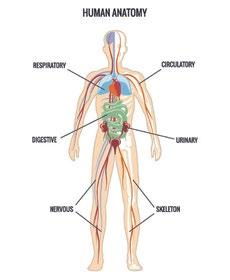









TICK OPTIONS HERE I enclose cheque/PO payable to Bioenergiser for (amount) £ or please charge my VISA / MASTERCARD credit/debit card Card No. Expiry Date: / Security Code: Cardholder’s Signature: Title: Name: Address: Postcode: Telephone Number: 14 day money back guarantee Advanced Formula Hemp Oil 10ml 1 Bottle Miracle Hemp Oil 10ml £9.99 + 2.95 P&P = £12.94 3 Bottles Miracle Hemp Oil 10ml (x3) £29.97 + £2.95 P&P = £32.92 6 Bottles Miracle Hemp Oil 10ml (includes 1 FREE) = £49.95 + £2.95 P&P = £52.90 13 Bottles Miracle Hemp Oil 10ml (includes 3 BOTTLES FREE) & FREE DELIVERY = £99.90 FREE P&P BUMPER BONUS PACK> Post to: Bioenergiser, Biovit Miracle Hemp Oil™, Unit 2, Frederick Road, Hoo Farm Industrial Estate, Kidderminster, Worcestershire DY11 7RA Delivery normally within one week, but please allow 28 days. If you do not wish to receive other interesting offers from our carefully selected partners please tick this box 14 day refund.If you’re not delighted with your Biovit Miracle Hemp Oil™ return for refund, in its original condition and packaging to Bioenergiser, Unit 2, Frederick Road, Hoo Farm Estate, Kidderminster, Worcestershire DY11 7RA. Used items cannot be refunded or returned due to hygiene.
iovit Miracle Hemp Oil™ will bring fast, effective relief – and has already changed thousands of people’s lives for the better... Academic institutions are studying in depth this amazing plant and the possible benefits for a wide range of conditions. SPECIAL OFFER TODAY! SAVE £20! Whilst stocks last NOW + 14-day money back guarantee Improve your quality of life with... ADVERTISEMENT JOINT & MUSCLE UPDATE - BY MARK JONES MIRACLE HEMP OILTM A NATURAL APPROACH TO WELLBEING 2 in 1 formulation – Mother Nature’s ancient
for wellbeing. MIRACLE HEMP OIL What is Biovit Miracle Hemp Oil™? Miracle Hemp Oil is packed full of minerals such as potassium, magnesium, iron, zinc, calcium, and phosphorus, plus micro elements like strontium, thorium, and chromium. High in essential fatty acids, Omega 6 and Omega 3. How to use Miracle Hemp Oral consumption: 2 or 3 100% Legal Produced in the EU Non-Physioactive Target Discomfort HURRY - SAVINGS END SOON DISCOMFORT
TAKE
OR APPLY DIRECTLY TO AFFECTED AREA IMPROVED QUALITY OF LIFE SUFFER FROM INSOMNIA? PROVIDES A RESTFUL NIGHTS SLEEP HEMP OIL HAS BEEN USED FOR THOUSANDS OF YEARS FOR ITS MIRACULOUS PROPERTIES 99 Oil™ drops under the tongue, twice a day. Topical use: 1 or 2 drops per day onto the skin and massage directly into affected area. No. 1 BEST SELLER HEMP OIL™ Ideal for joints NOT YET AVAILABLE IN SHOPS OR PHARMACIES 100% Natural Therapy Fast-acting Targets Muscles Improved Wellbeing Ideal for joints Active compounds deliver health rejuvenation benefits 100% Legal ORDER NOW: WWW.VY TALIVING.CO.UK Or call our UK call centre: 0800 470 1558 WE DELIVER TO YOUR DOOR Call centre 7 days a week/24 hours a day SAVE LIVES 1. CALL OUR UK CALL CENTRE 2. ORDER SECURELY VIA PHONE 3. WE DELIVER TO YOUR DOOR Your call order details are 100% SAFE AND PROTECTED. The safest way to order is online or via our call centre PROTECT THE NHS ORDER BY FREEPHONE NOW: STAY AT HOME FAST DELIVERY SERVICE (Usually within 7 working days but please allow up to 28days) 14-DAY MONEY BACK GUARANTEE! PLEASE QUOTE OFFER CODE PLEASE QUOTE OFFER CODE RDU1 RDU1
formula
TIREDNESS
ORALLY (pleasant tasting)

MAKE UP
Director Claire Oakley announces herself as a force to be reckoned with in this moody musing on self-love and sexual awakening
Set in a rugged coastal holiday park in windswept Cornwall, Make Up plunges deep into the inner world of Ruth—a young woman who arrives at the park to stay with her boyfriend, Tom. Yet what begins as a life of tranquil domestic bliss, soon turns into a vicious cycle of jealousy, when Ruth finds lipstick stains on her partner’s mirror and a strand of red hair on his T-shirt. Rather than confronting him about it though, she dwells on her paranoia, soon centring it around Jade—Tom’s colleague at the park, whose scarlet nails and bright copper wig feed into Ruth’s obsession.
Flamboyant and confident, Jade quickly cajoles Ruth into becoming her friend, forcing her jealousy to take an unexpected U-turn…
This stunning if somewhat unsettling debut from director Claire Oakley doesn’t pander to your taste, nor does it try to entertain or comfort you. It is a film to be experienced and immersed in like a hallucinogenic drug that’s both seductive and frightening, flirting with elements of horror and drama with the confidence of a seasoned auteur. The performances are quiet and understated, shrouded in the mystery and aloofness of the vast Cornish landscape. The solitary, tantalising red hue is the sole loud thing about Make Up that pierces the screen like lightning, chipping away at Ruth’s sanity.
READERSDIGEST.CO.UK/CULTURE 118 • AUGUST 2020
© CURZON ARTIFICIAL EYE
H H H H H FILM
RETRO Review

Suspiria (1977)

Fto its iconic status.
rom small-town Cornwall, we venture into the dangerous world of 1970s Germany, with Dario Argento’s cult classic, Suspiria. It’s a bit of an extreme jump, admittedly, as Argento is much more preoccupied with shock value and blood, where Oakley emphasises subtle symbolism and internal turmoil, however, if you enjoy the erotically charged aesthetic of Make Up, you’re bound to fall for the Italian giallo film genre.
Meaning “yellow” in Italian, giallo is a cycle of stylish, bloody crime thrillers, popular between 1960s and 1970s, known for their visual flair and themes of madness and paranoia. If you’re new to the genre, Suspiria is a great place to start due
It tells the story of a young American dancer, Suzy, who arrives in Freiburg to join an esteemed dance academy. Things seem to be a bit odd from the get-go: students go missing under mysterious circumstances, very questionable beverages are served with meals and we stumble upon rooms filled with barbed wire. Standard dance academy fare, right? It all starts to make more sense when we find out that its run by a coven of witches which Suzy is destined to destroy.
But don’t let the insane story put you off; Suspiria is a masterclass in visionary cinematography that you won’t witness anywhere outside of giallo. The shock cuts and peculiar camera angles are fresh and unexpected, while the ever-present theatrically bright-coloured lights will make you remember this film like a trip to a nightclub from hell.
And if you like what you see, make sure to check out the 2018 remake by Luca Guadagnino, featuring an all-star cast and an irresistible soundtrack by Thom Yorke—a bold and original piece of cinema in its own right. by
Eva Mackevic
AUGUST 2020 • 119
With the way the world has been turning of late, we could all do with an extra chuckle or two. Fortunately, the schedulers have come good. Mrs. America (BBC2; iPlayer) doesn’t immediately sound like a laugh riot— it’s dramatising the fight that erupted in 1970s America over the Equal Rights Amendment—but it emerges as one of recent TV’s liveliest history lessons. Showrunner Dahvi Waller gives it the full American Hustle treatment: “A Fifth of Beethoven” on the soundtrack, collars and trousers as wide as the hair is high.
At its centre is a typically imperious Cate Blanchett as Republican activist Phyllis Schafly, a Thatcherlike figure revered by the Right as a woman who came to wield considerable influence, and reviled by the feminist Left for what she chose to do with her clout. That latter faction is brought
Retro Pick:
to renewed life by a superlative ensemble cast—including Rose Byrne as Gloria Steinem and Tracey Ullman as Betty Friedan—ensuring this busy, entertaining miniseries reaches beyond one woman’s story to contain a multitude of experiences.
Different century, similar struggle: The Great (Starz via Amazon Prime) has rude fun letting the writer of The Favourite loose on the haphazard efforts of Catherine II (a luminous Elle Fanning) to modernise the Russian court. Should despair persist after that, reacquaint yourself with What We Do in the Shadows (BBC2; iPlayer) as the vampire-flatshare sitcom returns for an even sharper second bite. If its blundering characters can survive centuries of plague and pestilence, there’s no reason why you and I can’t hold out a little longer.
 by Mike McCahill
by Mike McCahill
TheArmandoIannucciShows (All4) Overshadowed by real-world tragedy on its initial run in September 2001, this vehicle for the comedy guru behind recent film successes The Death of Stalin and DavidCopperfield provides a pleasing blend of philosophy and absurdity.

TELEVISION
120 • AUGUST 2020
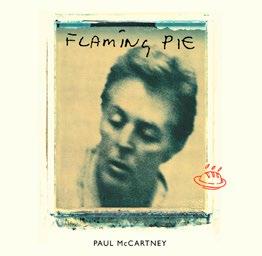
Album of the Month:
FLAMING PIE: ARCHIVE COLLECTION
byPaulMcCartney
Macca is undoubtedly one of the greatest songwriters in music history; a maverick whose ear for melody and composition is second to none. Flaming Pie was his most commercially successful solo album of the 1990s and on July 31, it’s getting an exciting re-release which includes re-mastered and bonus tracks, previously unreleased material, exclusive books, photos and artwork. If you’re scratching your head trying to remember which one of Paul’s vast discography Flaming Pie is, you’ll recognise it instantly by its lush, layered ballads such as the loose-limbed “Heaven on a Sunday” or pensive “Calico Skies” which features some of the most beautiful acoustic guitar picking known to man.
It’s an atmospheric, personal collection that Paul himself refers to as “a refresher course on the Beatles standards” due to the fact that it was heavily inspired by his involvement in The Beatles’ Anthology TV series. It’s the perfect Sunday-evening-kind of album that’ll ease you into a new week and take your mind off your worries.
by Eva Mackevic
MUSIC
Best Beatles Solo Albums
AllThingsMustPass (1970) by George Harrison
A creative triumph that helped Harrison emerge from the shadow of Lennon and McCartney.
PlasticOnoBand (1970) by John Lennon A formidable record that marked Lennon’s harrowing break from the past.
BandontheRun (1973) by Paul McCartney and Wings The record that showcases what McCartney was born to do: creating sophisticated arrangements and flawless hooks.
Ram (1971) by Paul and Linda McCartney Though plagued by controversy and poor critical reception, Ramhas gained a cult status over the years.
Imagine (1971) by John Lennon Though best known for its title track, Imaginehas lots more to offer with its disarming fragility and thematic depth.
What’s your favourite Beatles solo album? Let us know at readersletters@readersdigest. co.uk
AUGUST 2020 • 121
August Fiction
Whether you’re after chills and thrills or a profound musing on life, we’ve got you covered with this month’s books
Knife Edge by Simon Mayo (Doubleday, £12.99)
Knife Edge begins with a poignant reminder of the old normal, as London commuters make their way through the morning rush hour. Half an hour later, seven of them have been murdered across the city— but not randomly, because all seven worked on the investigations team at the International Press Service (IPS). This fast-paced start is then followed by a fast-paced middle and a fastpaced climax.

cast of assorted friends, allies and enemies. Above all—and perhaps not surprisingly for someone who talks for a living—Mayo proves unfailingly good at dialogue.
Once the book’s over, admittedly, you might find some spoilsport part of yourself wondering if everything was quite as plausible as it seemed when you were excitedly turning the pages. Yet, in a way, that only confirms what an overwhelmingly powerful spell Knife Edge casts while you’re reading it.
The plot, in fact, rattles along at such a thrilling lick that it takes a while to notice how skilfully Mayo is doing the less flashy stuff too. Main character Famie—an IPS journalist herself—is a richly drawn as well as highly appealing heroine. There’s a strong supporting

James Walton is a book reviewer and broadcaster, and has written and presented 17 series of the BBC
Radio 4 literary quiz
The Write Stuff
The Midnight Library by Matt Haig (Canongate, £16.99)
Matt Haig has previously written several novels with strange and intriguing central concepts. He’s also produced two books about coping with depression. In The Midnight Library, he brilliantly combines both things. Aged 35, Nora has come to believe that every decision she’s ever made has been a disaster. Having once been a promising swimmer, musician and philosophy student, she’s now
BOOKS
122 • AUGUST 2020
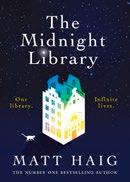
completely adrift: jobless, friendless and without hope. And so, after writing a suicide note addressed to “whoever”, she takes an overdose and waits to die.
Instead, though, she wakes in a vast, mysterious library containing an infinite number of books, each of which depicts—and allows her to enter—a version of her life as it would have been if she’d chosen differently at any given moment. And she can try out as many as she likes until she finds one that suits her.
The lessons Nora learns are perhaps not startling in themselves: the importance of love, say, and of counting your blessings. Nonetheless, Haig’s combination of ingenious story-telling and all-round decency doesn’t just provide a highly satisfying read. It really does make you think about what makes for a life well lived.
Name the author
Can you guess the writer from these clues (the fewer you need the better)?
1. His real name was Theodor Geisel.
2. One of his many bestselling children’s books begins, “The sun did not shine,/It was too wet to play”.
3. At first he pronounced his pen name to rhyme with “voice”—but later to rhyme with “goose”.
Answer on p126
PAPERBACKS
UpintheAtticby Pam Ayres (Ebury, £8.99). Her first new collection of poems since 2013 shows that Ayres has lost none of her ability to tackle subjects we all recognise with winning wit and charm.
Buriedby Lynda La Plante (Zaffre, £8.99). Gripping first instalment in a new crime series from the author of PrimeSuspect.
WindsofChangeby Peter Hennessey (Penguin, £12.99). Leading historian takes on the early 1960s with his usual flair for mixing the wider political picture with its impact on everyday life.
AgentRunningintheField by John le Carré (Penguin, £8.99). Riveting and often angry tale of the spying world in today’s Britain, where once again Russia needs careful watching.
Lowbornby Kerry Hudson (Vintage, £8.99). Hudson—these days, a successful novelist—vividly describes the poverty she knew growing up, and revisits her many childhood haunts to see if anything has changed there.
READER’S DIGEST RECOMMENDED READ:
An Affair To Remember
Love, lust, scandal and abdication crisis— Alexander Larman revisits the royal affair that changed the monarchy forever

“I
have found it impossible to… discharge my duties as King… without the help and support of the woman I love.” These words, spoken by Edward VIII in a radio broadcast announcing his abdication on December 11, 1936, are among the most famous in British royal history. How he came to speak them has remained a subject of fascination ever since.
Edward met Wallis Simpson in 1931, when he was Prince of Wales and she was married to her second husband, Ernest. The two were introduced by Edward’s
then-mistress Thelma Burgess, who three years later made the mistake of asking her old friend Wallis to look after the prince while she was away in the US. When Thelma returned, she realised Wallis “had looked after him exceedingly well”.
Although the British press stayed unusually silent, the affair was soon well-known within London society. Even so, Edward flatly denied it to his father, George V. George’s death in January 1936 then precipitated a fullblown constitutional crisis.
In this absorbing new book, Alexander Larman takes us through the whole, tangled story with great clarity. Opposing the king’s choice of a twice-divorced American wife was most of the British establishment. His supporters included the backbencher Winston Churchill, who helped him write that abdication broadcast.
Oddly, one of the people who didn’t think the king should marry Wallis Simpson was, it seems, Wallis
124 • AUGUST 2020
BOOKS
Simpson. Once the choice comes down to abdication or marriage, Larman makes it strikingly clear how badly she wanted out—on one occasion only going back to Edward when he threatened suicide.
As late as December 9, she made one last escape attempt—when her divorce lawyer Theodore Goddard flew to Cannes where she was holed up with Perry Brownlow, the king’s lord-in-waiting…
“Goddard later described her as being ‘in a most terrified state of nerves’, and desiring ‘complete capitulation [and] willingness to do anything’. He attempted to persuade her to withdraw the divorce action, which would immediately resolve the crisis, as it would mean that Edward could no longer marry her. Wallis was surprisingly keen to help. She told him that ‘I will do anything within my power to keep the King on the throne’, to which a relieved Goddard replied, ‘That is what I was sure you would say.’ Wallis later considered that ‘His expression was that of a man conscious of playing a crucial and successful role in a historical situation.’ It helped his case that he tactfully pointed out the weight of public opinion against her, and ‘a number of other disadvantages attendant upon pursuing the other courses open to her if she rejected his advice’. One salient fact that may have ‘‘
assisted her desire to stop Edward from abdicating was that, as a leading civil servant silkily described it, ‘Perhaps it had not been made sufficiently plain to the King and to Mrs Simpson that, if the King were to affront public opinion by abdicating, it was very doubtful whether Parliament would be prepared to grant money to the King after he had gone. It was thought that a hint of this position ought to be conveyed to the King and Mrs Simpson.’ The last thing the financially conscious Wallis wanted was to be in thrall to a penniless, bitter former monarch.
Brownlow was summoned for his advice, and played devil’s advocate. He doubted whether there was time to stop the king from abdicating, or if he would accept Wallis’s decision. As he argued, ‘For you to scrap your divorce will produce a hopeless anticlimax and an all-round tragedy.’ Yet Wallis felt it incumbent on her to attempt to avert disaster. Brownlow thus composed a short, tragic note saying, ‘With the deepest personal sorrow, Mrs Simpson wishes to
The Crown in Crisis: Countdown to the Abdication by Alexander Larman is published by Weidenfeld & Nicolson at £20

AUGUST 2020 • 125
READER’S DIGEST
announce that she has abandoned any intention of marrying His Majesty’, which she then signed.
It was time to call Edward, and tell him of her intentions. The line, as usual, was dreadful. With Goddard by her side, Wallis informed her lover that she was about to begin proceedings to withdraw her divorce petition, and that this was her heartfelt wish. Edward replied, calmly, ‘It’s too late. The abdication documents are already being drawn up. The Cabinet is meeting this very moment to act upon them. I have given them my final word. I will be gone from England within 48 hours.’ His next words told Wallis, if she did not already know, the manner of man she was dealing with, and would find herself associated with for the rest of her life. ‘Of course, you can do whatever you wish. You can go wherever you want—to China, Labrador, or the South Seas. But wherever you go, I will follow you.’’’
The Abdication Crisis in Quotations
“After I am dead, the boy will ruin himself in twelve months.”
George V
“Almost the whole of London is laughing at the way he is making himself ridiculous, being so patently under this woman’s thumb.”
Edward’s assistant private secretary, Godfrey Thomas, 1935
“It was she who filled his thoughts at all times—before her the affairs of state sank into insignificance.”
Edward’s private secretary Alec Hardinge on the beginning of his reign
“The truth is she’s bored stiff by him.”
Socialite Diana Cooper after holidaying with Edward and Wallis in 1936
“She is a nice woman and a sensible woman—but she is hard as nails and doesn’t love him.”
Diana’s husband Duff Cooper after the same holiday
And the name of the author is…
Dr Seuss. It’s TheCat intheHatthat begins, “The sun did not shine”— and other bestsellers include Green EggsandHamand HowtheGrinchStole Christmas, which added a new word for “killjoy” to the language.

“The Simpson crisis has been a great delight to everyone.”
Evelyn Waugh’s diary, December 8, 1936
“If he had stayed, everything would have been different. His abdication was a severe loss for us.”
Adolf Hitler, quoted by his minister of armaments, Albert Speer
BOOKS
126 • AUGUST 2020
Books
THAT CHANGED MY LIFE
Author and blogger, Candice Brathwaite, is a Sunday Times bestseller. I Am Not Your Baby
Mother is available now (Quercus, £16.99)
The Coldest Winter Ever by Sistah Souljah

This book was such a cultural flag for me growing up. Set in Brooklyn, New York, the story follows Winter Santiaga—the daughter of a drug kingpin. Even though I’m British, both myself and many other black girls at the time could draw parallels with how Winter was feeling and the nuances of being a young black woman stuck in tough situations due to poverty. It’s a story that swallows you whole and spits you out at the other end. I couldn’t get enough of it and nor could my school mates as our strict headmistress promptly banned it when she read its contents. The book becoming contraband made it even more enticing, of course, and today it’s still one of my favourites.


To Kill A Mocking Bird
by Harper Lee
Such a cliché, but who wasn’t influenced by this book? This was my first interaction with reading material that dealt precisely with racism and injustice in the US. The character, Atticus Finch, has stayed with me forever. This book is still so very timely considering what the US are still upholding with regards to police brutality and very public racism. This book taught me that life isn’t fair, even more so if you’re black. But it also taught me that there are good people who are ready to fight for what is just, even if most of the time they will fail. We have to be in it for the ten per cent.
The Alchemist
by Paulo Coelho
I had never even thought about things tied to the law of attraction or the idea of destiny until falling in love with this book. I read it at a very difficult time in my life and, like most brilliant books, it was like a raft carrying me away from the sinking Titanic. I very much believe that like the shepherd we all have a destiny and it’s important to not be swayed by the ideas and expectations of the outside world or by momentary hardship. We all have treasure to find. Coelho created a simply told masterpiece which is loved by so many people, including me.

FOR MORE, GO TO READERSDIGEST.CO.UK/CULTURE AUGUST 2020 • 127
Better, Faster, Stronger
James O'Malley explains the astonishing capabilities of the much-discussed new technology, 5G

Next month, it is widely expected that Apple will reveal this year’s new iPhone. Like previous years, it will probably run a little faster, have a slightly better screen—and the camera will inevitably be improved too. But most importantly, it will likely be the first iPhone to take advantage of brand new technology: 5G.
At first glance, 5G may seem like a merely evolutionary technology: it’s going to make browsing Facebook on the train slightly faster, right? That’s what the adverts tell us. But the technology offers so much more.
Yes, 5G is faster, but the real innovation is in terms of latency—the time it takes for signals to travel between your phone and the mobile phone transmitter. For example, there
should be less lag between hitting the “play” button and the video starting to play, and video calls won't be stilted by a delay.
If you’ve ever tried to use your phone in a large crowd of people, you’ll know how the internet can slow to a crawl because everyone is sharing the same mobile phone mast. This is something 5G is designed to tackle by allowing more connections. Connectivity should be better for everyone too. In dense urban areas, phone networks can use “millimetre wave” technology to augment their 5G networks. These are essentially 5G antennas that work using a different part of the electromagnetic spectrum designed for short range. Rural areas will benefit too: the improved speed and bandwidth means that rural
128 • AUGUST 2020
communities will no longer need to wait for fibre-optic cable to reach them in order to get a high-quality internet connection.
Even better, the government has insisted that the phone companies
YOUR BIKE COULD BOOK ITSELF IN FOR SERVICE WHEN IT DETECTS A FLAT TYRE
provide wider geographic coverage than they did with 4G—so there’s more chance that Google Maps will still work when you really need it while lost on a country road.
These improvements still do not capture the full scope of what 5G will enable and the most important factor isn’t how it will improve our phones.
In a world where high-speed 5G connectivity is ubiquitous, it has the capability to transform our lives— both big and small, as 5G chips are routinely built into everything. Driverless cars and delivery drones will be able to take advantage of the low-latency transmissions to navigate safely. Remote surgery, where doctors control robotic arms from the other side of the world, could become plausible rather than science fiction.
Industry will be able to track containers closely as they travel around the world. Electricity companies will be able to closely monitor infrastructure to reduce power cuts. And your bike could one day book itself a service appointment when it detects a flat tyre.
The most exciting part though is that these ideas are just speculation. The truth is, we just don’t know what new technologies and improvements 5G will bring. Before 4G, nobody had thought of the idea of ordering a taxi or a meal at the touch of a button, but because 4G created the technological space, someone invented them.
As the technology rolls out across the world, it is going to finally, fully blur the line between the quality of internet connectivity we can expect at home, to what we get when we’re out and about. In the not-too-distant future, we may not need to worry about whether we’re connected to the wifi network or using mobile data— the internet will just work.
So, do you need to rush out and upgrade your handset? Realistically, the answer is “not yet”. Though all of the major networks launched their 5G offerings last year, it is still very early days: signal is restricted mostly to major cities. And, unless you have an urgent reason to need rock-solid connectivity, 4G will probably still make do for most purposes.
But 5G is inevitable—and it is going to change our world. n
AUGUST 2020 • 129
TECHNOLOGY
You Couldn’t Make It Up
Win £30 for your true, funny stories!
Go to readersdigest.co.uk/contact-us or facebook.com/readersdigestuk
What started as a very sombre virtual meeting with 150 ambassadorial and managerial-level attendees, turned out to be quite comical when, halfway through, it was taken over by hackers. During a ceaseless, exhausting address by a sulkylooking speaker, a video from an adult site popped-up mid-screen, taking over our meeting with moans and dirty talk. The speaker’s wideeyed, open-mouthed expression and the technical person’s flustered embarrassment were priceless! Needless to say, the meeting was curtly adjourned.
STEPHANIA AQUILINA, Switzerland
My teenage daughter came downstairs looking confused. She had spent the last five minutes trying to clean the screen of her iPad.
"How does this work?" she queried, holding up the new rubber she’d recently bought. Its packaging was labelled "Tablet Eraser".
GILL MARTIN, Surrey
I was asking my nursery class about the noises animals made which they got correct until we got to a mouse. "Click" they said. It took me a while to figure it out—even four-year-olds use computers these days!
SHERYL SCOTT-COOPER, London
When I was a teenager I went to spend a month in France with a family to improve my French. On the first evening the mother asked me, in French, if I liked boiled eggs and I confirmed I did.
Then she asked how many minutes she should cook it. I didn't understand and when she suggested "Une minute?" I agreed.
For a month I started the day with a one-minute-cooked egg and didn't want to admit I had not understood the question!
LUCY PESARO, Middlesex
My grandmother is well renowned for being a little bit snooty, however much we love her.
FUN & GAMES 130 • AUGUST 2020
cartoon by Steve Jones

"Wait'tilyourfathergetshomefrom...oh"
"Wait till your father gets home from... oh!"
At an airport once, she was unhappy with the shabby appearance of her old suitcase. She waited until it was the last one on the carousel before she took it off, so no one knew it was hers. She had to wait ages!
My teenage son came home and told us that someone had come into school that day to teach them about first aid. He asked us if anyone at home knew about CPR.
AMBER JACOBS, Cheshire
Our teenage children never get used to their dad's outlandish golf outfits because they usually consider him quite trendy for his age.
I overheard them talking to their friends about him. One commented that, "Golf must be an acronym for going out looking funny."
ELERI WEBSTER, Cheshire
My friend was telling me about her father who had been in hospital for an operation "down below".
"He had to be castrated" she said.
Seeing the horrified look on my face, her husband quickly cut in with, "You mean catheterised."
Thank goodness!
SUE BUCKINGHAM, Monmouthshire
His six-year-old brother piped up with, "That's so easy. I know the whole alphabet."
CORRINA WILLIAMS, Rhuthun
I was talking to my sister-in-law on the phone and I didn't like what she said to me so as I put the phone down I said, "Cow". The phone rang a minute later and my daughter answered the phone.
"Mum" she shouted to me in the kitchen, "It's the cow on the phone." Oh dear!
LIA COOKE, Devon
I picked my friend's eight-year-old son up from school and we were chatting about what he'd been doing. He said, "A policeman came today and told us that people get arrested and put in custard."
JANE WHITAKER Kent
AUGUST 2020 • 131

















YES I want to subscribe to Reader’s Digest Magazine for just £3 for 3 issues (a saving of £8.37 on the shop price of £11.37 based on the cover price of £3.79 per issue). I understand that if I do not wish to continue receiving Reader’s Digest after my first 3 issues I can simply cancel my subscription by contacting customer services. If I do want to continue to subscribe after my first 3 issues I need do nothing and my subscription will automatically be renewed at the low rate of £7.50 for every 3 issues until I decide otherwise. Name: Address:


HEALTH • MONEY • TRAVEL • RECIPES • FASHION • TECHNOLOGY SMALL AND PERFECTLY INFORMED Living With Your RegretsLESSONS IN BRANAGH Kenneth ON HARRYHOPE,POTTER AND RETURNING TO HIS HOMELAND HARRY POTTER HEALTH • MONEY • TRAVEL • RECIPES • FASHION • TECHNOLOGY READER’S DIGEST SMALL AND PERFECTLY INFORMED Julie Andrews A WITHCONVERSATION THE SILVER The Art Of The BOOKSHELF WHAT DOES YOUR LIBRARYABOUTREVEAL YOU? LETTING GO Please complete direct debit mandate below Name of Bank ...................................................................... Account Holder Branch: / / Account No Instructions to your bank or Building Society: Pay Reader’s Digest Direct Debits from the account detailed on this instruction subject to the safeguards assured by the Direct Debit Guarantee. I understand that this instruction may remain with Reader’s Digest and if so will be passed electronically to my Bank or Building Society. Signature ..................................................................... Date .............................................................................. INSTRUCTIONS TO YOUR BANK OR BUILDING SOCIETY TO PAY BY DIRECT DEBIT. Originators reference: 400162
Email:
health, books, films, food, humour and travel alongside in-depth news features, memoirs and celebrity profiles. It’s never been easier to enjoy the world’s favourite magazine! Sort Code Data Protection: From time to time Reader’s Digest may contact you with details of its products and services. Please tick here if you object to receiving such information Return your completed form to: Reader’s Digest, The Maltings, West Street, Bourne PE10 9PH Or call us today on 0330 333 2220 Quoting code RDN077 3 ISSUES FOR JUST £3! AUGUST2020 HEALTH • MONEY • TRAVEL • RECIPES • FASHION • TECHNOLOGY READER’S DIGEST SMALL AND PERFECTLY INFORMED | AUGUST 2020 Gordon Ramsey “I MISS THE KITCHEN LIKE HELL” Finding My Family LIVES TRANSFORMED BY DNA TRACING AUGUST2020 £3.79 readersdigest.co.uk 3 GIANTS InTheFootstepsOf DISCOVERING THE NORTH ANTRIM COAST
Postcode: Telephone:
Each must-read monthly issue covers life, culture,
IT PAYS TO INCREASE YOUR
Word Power
Hope you don’t mind, but we’ve mined the lexicon for examples of homophones—sound-alike words with different spellings and meanings. Who says mistaken identity can’t be fun?
BY ROB LUTES
1. nock—A: notch on an arrow that fits the bowstring. B: cap on a fence post. C: large, exposed tree root.
2. bight—A: raised centre of a roadway. B: curve in a coast forming a bay. C: degree of hardness of ice.
3. buccal—A: trunk of a tree. B: thin membrane under an eggshell. C: relating to the mouth.
4. frieze—A: horizontal band of sculpted or painted decoration. B: type of meringue. C: footbridge.
5. cession—A: extreme air pollution. B: act of giving up. C: a pilgrimage.
6. clew A: mix vigorously with water. B: provide with spiritual understanding. C: the lower corner of a sail.
7. naught—A: nothing. B: imminent harm. C: middle of nowhere.
8. awl—A: young raccoon. B: narrow ditch. C: a sharppointed tool.
9. rede—A: advice. B: constructive criticism. C: fear of the unknown.
10. offal—A: animal organs used for food. B: tea made from dried dung. C: choral works from the baroque period.
11. plait—A: question in a forceful way. B: twist together into a braid. C: ease someone’s grief.
12. limn—A: depict in words or by drawing. B: adorn with flowers. C: run quickly.
13. indite—A: control by force. B: compose. C: organise into groups.
14. pique—A: sudden feeling of annoyance. B: opaque pottery glaze. C: purity.
15. loupe—A: now-extinct wildcat breed. B: quill writing implement. C: small magnifying glass used by jewellers.
AUGUST 2020 • 133 FUN AND GAMES
ANSWERS
1. nock—[A] notch on an arrow that fits the bowstring. Expertly sliding the bowstring into the nock, Jamal prepared to shoot the apple off the distant stand.
2. bight—[B] curve in a coast forming a bay. The bight was the only place along the coast calm enough to snorkel.
3. buccal—[C] relating to the mouth. The buccal phase of swallowing ends with the tongue pushing food into the throat.
4. frieze—[A] horizontal band of sculpted or painted decoration. The room was a marvel of design, capped by the delightful tiled frieze on the west wall.
5. cession—[B] act of giving up. The sheik’s cession of the long-disputed border territory was a sign to the world that diplomacy had succeeded.
6. clew—[C] lower corner of a sail. I grabbed the clew and, moving it from side to side, helped steer the boat.
7. naught—[A] nothing. Standing at the edge of the sinkhole that just swallowed his house, Fabian thought of how his years of hard work had come to naught.
8. awl—[C] sharp-
pointed tool. Paola marked the leather at even distances with an awl before stitching the leather pouch.
9. rede—[A] advice. Facing any tough choice, Andrei always sought rede from his brother.
10. offal—[A] animal organs used for food. To her own surprise, since marrying a butcher, Nara has developed a taste for offal.
11. plait—[B] twist together into a braid. Aimée grudgingly allowed her stepmother to plait her hair.
12. limn—[A] depict in words or by drawing. The street artist used pencil to limn tourist likenesses.
13. indite—[B] compose. He would often stop in the middle of a conversation to indite a poem.
14. pique—[A] sudden feeling of annoyance. Hearing her father’s voice brought a moment of pique, but Lynn greeted him affectionately.
WORD OF THE DAY*
HUMICUBATION
To lie on the ground penitently
Alternative suggestions:
"The noise people make when concentrating on solving their Rubik's cube"
15. loupe—[C] small magnifying glass used by jewellers. Elena brought the loupe right up to her eye with one hand and held the diamond with the other.
VOCABULARY RATINGS
7–10: fair
11–12: good
13–15: excellent
*POST YOUR DEFINITIONS EVERY DAY AT FACEBOOK.COM/READERSDIGESTUK
134

Making it count
After spending far too much time on apps and social media over the last few years, Gemma decided it was time for a change.
“I’d started to get really frustrated with how I was spending my spare time”, said Gemma, 54 from London. “One day, I realised I’d checked my phone over 100 times. Something had to give.”
“So, I deleted my social media apps from my phone and made a promise to myself to do something more positive with my time.”
At first, it wasn’t easy for Gemma to find things to do.
“I’m embarrassed to admit that I’d stopped reading as much over the last couple of years. But, then a friend recommended Readly to me. I’d always loved reading magazines and thought it was time to give them a go again.
The selection is amazing: food, fitness, lifestyle, culture, crafts and

hobbies are all covered. I’ve been using Readly in the evenings to relax instead of watching TV. I’ve also found it great for inspiration and ideas for new recipes. We’ve been doing some re-decorating, so the interior design section has been really helpful. Having so many past issues to browse through is just fantastic. I can’t think how much I would’ve had to spend to get all that content. If you read more than a couple of magazines, you’ll be saving money each month.
My husband loves the car, sport and business magazines. And we cuddle up and do the puzzles and crosswords together now as well!
As it’s a family membership, I’ve shared my subscription with my daughter who has started using it. She’s a teacher and loves getting inspiration from the kids news, science and history magazines.”
To find out more about Readly, and to try 1 month for free, please go to www.readly.com/digest
PARTNERSHIP PROMOTION
Brainteasers
Challenge yourself by solving these puzzles, then check your answers on p139
Four-Bidden
Place an X or an O in each empty cell of this grid so that there are no four consecutive Xs or Os appearing horizontally, vertically or diagonally. There’s only one solution. Can you find it?
A New Perspective
To “Tell” The Truth
You’re playing poker against Tex. He has a “tell”: his eye twitches 90 per cent of the time when he thinks he has a good hand. The trouble is that he has a twitchy eye anyway, and there’s a 10 per cent chance it’s twitching even when he thinks his hand isn’t strong. If Tex considers 30 per cent of all the hands he gets to be good, and if his eye is twitching right now, what’s the probability that he thinks he has a good hand?
You’ve seen this sequence before, but maybe not like this, with darker shadows indicating greater distance away from the eye. What should the next (and last) picture look like?
136 • AUGUST 2020 O O X O O X O X X O O X X O X X X O X O X O O O X X
(Four-bidden) Fraser s impson; (To “Tell” T he Tru T h, a n ew p erspec T ive) d arren r igby
Sum-Thing Special
Each letter from A through H has one of the eight values listed below, and no two letters have the same value. Which number corresponds with each letter to make all of the equations true?
1 to 25
Move the numbers from the outer ring onto the board. Each number must be placed in one of the five cells that lie in the direction indicated by its chevron. The numbers must snake together vertically, horizontally or diagonally so that they link in sequence from 1 to 25 (for example, 2 must be adjacent to both 1 and 3). There’s only one solution. Can you find it?
FUN & GAMES AUGUST 2020 • 137 17 22 18 6 10 13 25 16 15 5 20 12 23 24 3 9 1 2 14 19 21 4 7 8 11
( s um-Thing s pecial) Fraser s impson; (1 T o 25) Je FF w idderich A B C D E F G H D + G = A F + A = E H + C = F D + B = E C + F = G 3 4 6 7 11 17 18 24
CROSSWISE Test your general knowledge. Answers on p142 BRAINTEASERS ACROSS 1 German liqueur (8) 9 Burden excessively (8) 10 Self-important (8) 11 Travelling case for clothes (8) 12 Refrain voluntarily (7) 13 Gambling game (4,4) 14 Private feud (8) 18 Acts (8) 21 Bald (8) 23 Black magic (7) 24 I o W town (8) 26 Staple of Mediterranean cooking (5,3) 27 Goodbye (8) 28 Charismatic (8) DOWN 2 Responsive to drugs (7) 3 Midday (8) 4 Musician who could play the Moonlight Sonata (7) 5 Drunkards (4) 6 Musical performance (7) 7 Tranquil (6) 8 Cushion for kneeling (7) 13 Poaches with a torch (5) 15 Substantial (8) 16 West-Atlantic island country (7) 17 Decreased (7) 19 Covering for a building (7) 20 Cocktail (7) 22 Battered (6) 25 Small island (4)




C BRAINTEASERS ANSWERS READER’S DIGEST AND THE £50 GOES TO… ROBERT BLUCK, Birmingham THE FIRST CORRECT ANSWER WE PICK WINS £50!* Can you name the famous people honoured in the following statutes? ANSWER TO JULY’S PRIZE QUESTION A: James Callaghan B: Edward (Ted) Heath C: Harold Macmillan D: Neville Chamberlain £50 PRIZE QUESTION Email excerpts@readersdigest.co.uk AUGUST 2020 • 139 A B C D Four-Bidden To “Tell” The Truth 27/34 or around 79 per cent. A New Perspective As shown: These are the letters T, U, V, W, X, Y and Z as seen from below. Sum-Thing Special 1 to 25 X O O X O O X O X O X O O X O X O X O X X X O X O X O O X X O X X O O O X O X O X O X X O O X O X X O X X X O O O O X O X O X X 17 22 18 6 10 13 25 16 19 18 16 15 14 15 5 20 17 6 5 13 20 12 23 21 4 7 12 23 24 22 24 3 11 8 3 9 25 2 1 10 9 2 14 19 21 4 7 8 11 A B C D E F G H 17 18 4 6 24 7 11 3
Laugh!
WIN £30 for every reader’s joke we publish!
Go to readersdigest.co.uk/contact-us or facebook.com/readersdigestuk
I regret rubbing ketchup in my eyes. But that’s Heinz sight.
Comedian NICK HELM
My new boyfriend told me that he’s got my face as his wallpaper, which I thought was cute, until I saw his lounge.
Comedian STEFF TODD
I was buying a dishwasher online, so I sorted the results from lowest to highest. The top result was a sponge.
Comedian DARIUS DAVIES
My name is Sukh, which is short for Sukhjeet, which is Sanskrit for, “you’re never going to find it on a f*****g keyring in a gift shop.
Comedian SUKH OJLA
My friend claimed that he could print a gun using his 3D printer, but I wasn’t impressed. I’ve been using a canon printer for ages!
Submitted via email
In honour of 2020, I think Goodyear Tyres should change their name to “Tyres”.
Comedian KREG PAUL
Comedian MARTHA MCBRIER
I didn’t get involved with the fight I saw outside the kebab shop. I just thought, “let the chips fall where they may.”
I recently went to see a faith healer who was visiting my town. There’s
140 • AUGUST 2020
FUN & GAMES
Why did the can crusher quit his job? Because it WAS SODA PRESSING! Seen online INSTAGRAM
nothing wrong with me, I was just curious, but the weirdest thing happened. I sat in the back of the room, but the healer still managed to find me. Without asking anything, they laid their hand on my head and said, “You can walk. You can walk.”
I didn’t understand, because I had never had problems with my legs, but the healer was convinced, “You can walk. You can walk.”
After the show, I walked out, and you’ll never guess—someone had stolen my bicycle. Submitted via email
You’ll never guess who I bumped into on the way to get my glasses fixed last week? Everyone! Seen on Reddit
Three dinosaurs find a magic lamp in a river. A genie pops out and says, “I will grant each one of you one wish!”
The first dinosaur thinks and says, “I wish for a huge piece of meat!”
The genie smiles and a big, juicy steak appears in front of him.

Birds On Film


AUGUST 2020 • 141
USER @OSTDROSSEL PLACED A HIDDEN CAMERA IN HER BIRD FEEDER via sadanduseless.com
The second dinosaur says, “I wish for a shower of meats!” The genie snaps his fingers and it begins to rain freshly cooked steaks.
The last dinosaur thinks for a bit and then finally gets an idea. Not to be outdone, he says, “I wish for an even meatier shower!”
Submitted via letter
I’ve written a joke about a fat badger, but I couldn’t fit it into my set.
Comedian MASAI GRAHAM
A man went to the doctor with a strange complaint. “Well, it’s like this doctor—when I drive to work in the morning through the country lanes I start to sing ‘The Green Green Grass of Home’. If I see a cat on my travels, then it’s ‘What’s New, Pussy Cat?’ It’s so embarrasing. Even when I’m asleep and dreaming, I still keep singing. Last night, it was ‘Delilah’, and my wife was not amused!”
“Don’t worry, I understand,” the doctor replied. “It would apear that you have the early symptoms of Tom Jones syndrome.”
“Well I’ve never heard of that, is it common?” asked the man.
“It’s not unusual,” replied the doctor. Seen on Facebook
I’ve got sensitive teeth. They’ll probably be upset I’ve told you.
Comedian GORDON SOUTHERN
CROSSWORD ANSWERS
Don’t Judge A Book…

Twitter users suggest some hilarious ways to ruin classic book titles by adding just one word.
@Haley_Victory: Charlotte’s Web History
@KerinOn: The Conference Call of the Wild
@Carl_Stawicki: Charlie Manson and the Chocolate Factory
@GumGumerson: Jane Eyre Pods
@ShelleyLerma: Jurassic Trailer Park
@Saru_Chan_: Thumb War And Peace
@AlachuaLibrary: Dante’s Divine Romantic Comedy
Across: 1 Schnapps, 9 Overload, 10 Arrogant, 11 Suitcase, 12 Abstain, 13 Liar dice, 14 Vendetta, 18 Performs, 21 Hairless, 23 Sorcery, 24 Yarmouth, 26 Olive oil, 27 Farewell, 28 Magnetic.
Down: 2 Curable, 3 Noontide, 4 Pianist, 5 Sots, 6 Recital, 7 Placid, 8 Hassock, 13 Lamps, 15 Concrete, 16 Bahamas, 17 Reduced, 19 Roofing, 20 Martini, 22 Rammed, 25 Holm
LAUGH

60 Second Stand-Up
We chat to the quickwitted comedian, Bilal Zafar
WHAT’S THE BEST PART ABOUT PERFORMING? My favourite bit of stand-up is when you improvise and it goes well. That’s probably the most fun you can ever have.
WHAT INSPIRES YOUR COMEDY? I base it on life experiences. Right now on Twitch.tv I’m doing an improvised comedy show where I play a football manager and a lot of it is inspired by the ridiculousness in football.
CAN YOU TELL US ABOUT A FUNNY TIME YOU BOMBED ON STAGE? I did my first corporate gig about five years ago
which was a Q&A with a big cricketer and I was the entertainment. When I went on they started serving the food, so no one was listening. I was talking to silence while the cricketer walked around signing stuff.
DO YOU FIND ANY PARTS OF THE UK TO BE FUNNIER THAN OTHERS? A lot of the time the most random towns that I haven’t heard of before, like Stockton and Poole, are really up for a laugh.
IF YOU WERE A FLY ON THE WALL, WHOSE WALL WOULD IT BE ON? Kanye West. What’s going on with him? He’s someone that I kind of like sometimes, not lately. I’m kind of obsessed with him.
WHAT’S YOUR FAVOURITE OF YOUR OWN JOKES? I really want to take singing lessons, which is odd because I don’t want to go on X-Factor. I just want to be able to sing so someone can catch me one day and complement me.
WHAT SUPER POWER WOULD YOU HAVE? I’d like to teleport. The travelling in stand-up can be a nightmare, especially outside of London. But I’d use it all over the house too, I’d get really unhealthy because I’d never need to walk again. n
You can stream Bilal Zafar’s Pro Evolution Soccer show on Twitch at @zafarcakes
FOR MORE, GO TO READERSDIGEST.CO.UK/INSPIRE/HUMOUR
READER’S DIGEST AUGUST 2020 • 143
Beat the Cartoonist!

Think of a witty caption for this cartoon—the three best suggestions, along with the cartoonist’s original, will be posted on our website in mid-August. If your entry gets the most votes, you’ll win £50.
Submit to captions@readersdigest.co.uk or online at readersdigest.co.uk/fun-games by August 7. We’ll announce the winner in our September issue.
JUNE’S WINNER

Our cartoonist has finally reclaimed his crown as his hilarious caption, “You’d be surprised how many princesses fall for it” destroyed the competition to win your votes and take the competition’s top spot. Want the chance to knock him off his throne next month? Enter the next competition using the details above.
IN THE SEPTEMBER ISSUE
SISTERS ARE BREWING IT FOR THEMSELVES
We meet the women revitalising the beer brewing industry and subverting stereotypes

THE MYSTERY OF THE PLAIN OF JARS
The quest to solve one of archaeology’s greatest puzzles
The music legend on what he would change about the world if he was in charge of it
LAUGH
+ 144 cartoons by Royston Robertson and Bill Houston
Peter Frampton
Discover the freedom of renting…
Why RENT?:
• Flexibility to choose to live and move - where and when you want
• No property ownership responsibilities
• Added security with our assured ‘lifetime’ tenancy
• Rent your home for as long as you wish
• No service charges or event fees
• Landlord is responsible for maintenance
Start living your retirement to the full!
Register with us to find your new home today. We have properties available to rent nationwide.
Exclusively for over 55’s our properties include independent living spaces alongside welcoming communal lounges with maintained gardens for socialising & relaxing. On-site managers and 24 hour emergency care line for additional peace of mind. All these services and more are included in the rent! 0800
525 184 www.girlings.co.uk
In this advert each word represents one mil e dri ven in an electric car. So far you’ve driven eighteen miles and all’s well. You’re on full charge, the kids are dropped o ff and you’re heading out for the day. T h e driving’s smooth, quiet and you’re clocking up brownie points for being emission free . But which car are you drivin g ? Well, by the end of this wor d, you’ve reached sixty five miles and the battery still looks very healthy. You’re on your way to pick something up from your sister’s before the trip this weekend and you know t he traffi c o n the B roads is going to be a nightmare. But off you go regardless. After an hou r, you turn onto her road just before this comma, or one hundred and twenty five miles, confident you won’t need to plug in for a while yet. Job done you hit the road again, you’ve still got further to go. Back at the school gates, you bundle the kids into the car and you’re ready to go, heading up the motorway for a weekend away and a chance to flee the urban jungle. Finally, you pull up at the hotel and plug the car in, amazed you’ve driven two hundred and f i ve mile s on a single charge, not far off your car’s whopping two hundred and forty five mile r ange. Which means
t h ere’s just fourteen
w ords left to reveal
w hich electric car
y ou’ve been
t
R

Zero tailpipe emissions. CO 2 while driving: 0 g/km, MPG: n/a according to WLTP homologation tests. Model shown GT Line R135 238 miles. Play R110 up to 245 miles. WLTP figures for comparability purposes. Figures obtained after the battery was fully charged. Actual real-world driving results may vary depending on factors such as accessories fitted after registration. For details visit renault.co.uk/zoe. 5 year warranty on cars ordered from 18 December 2019 – 5 years or 100,000 miles (whichever comes first). Exclusions apply visit renault.co.uk/warranty.
e n a u
O E
l t Z
d rivin g
h e N e w















































 Evander Holyfield, Gordon Ramsay, Oscar De La Hoya on CelebrityMasterchef (Below); The Gordon Ramsay restaurant in Paris hotel, Las Vegas
Evander Holyfield, Gordon Ramsay, Oscar De La Hoya on CelebrityMasterchef (Below); The Gordon Ramsay restaurant in Paris hotel, Las Vegas




















































































 Giant’s Causeway
Dunluce Castle
Giant’s Causeway
Dunluce Castle

 Carrick-a-Rede Rope Bridge
Ballintoy Harbour
Carrick-a-Rede Rope Bridge
Ballintoy Harbour


























 © Sophia Spring
© Sophia Spring

































 by Mike McCahill
by Mike McCahill






































